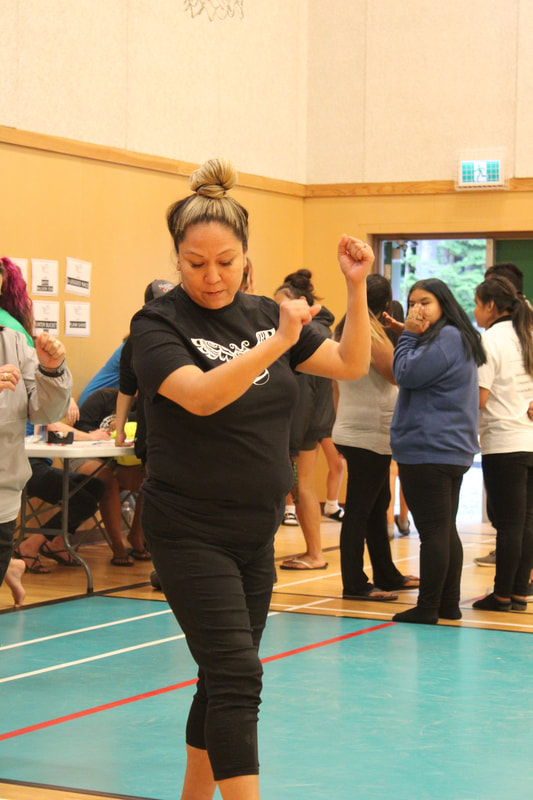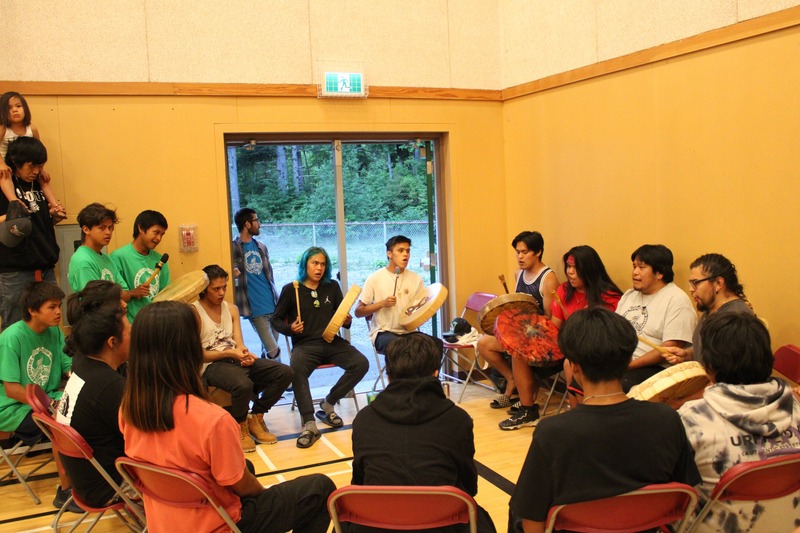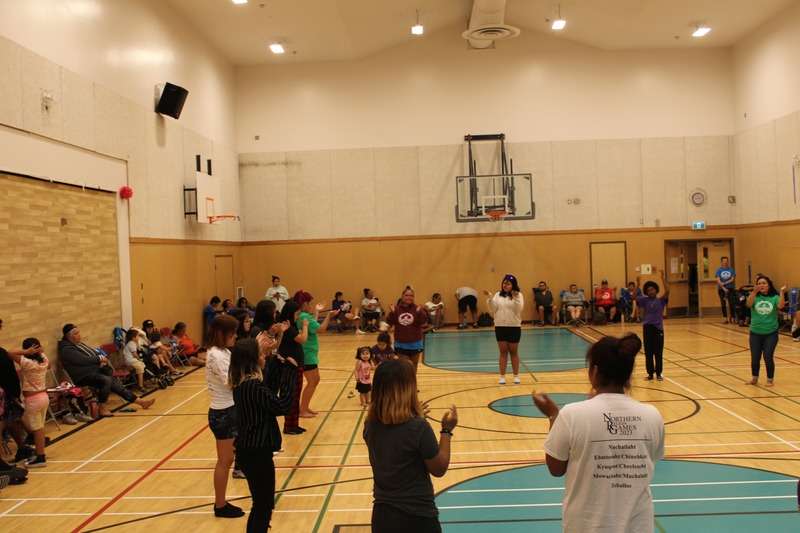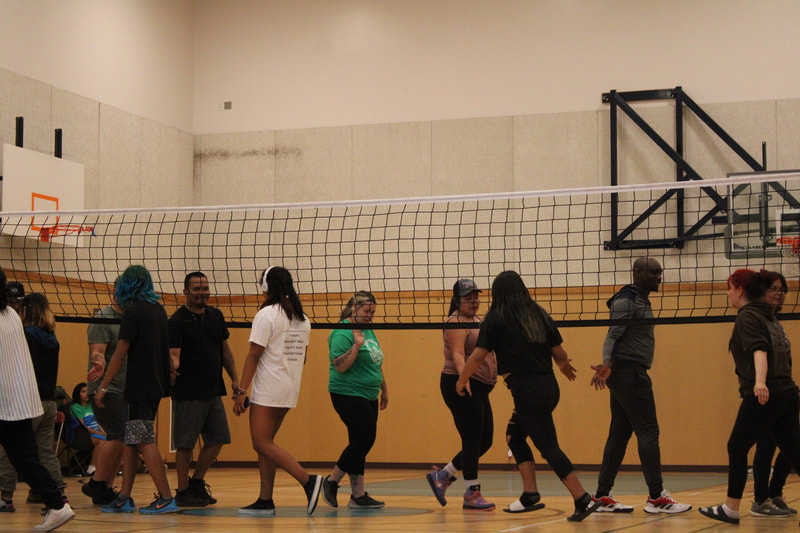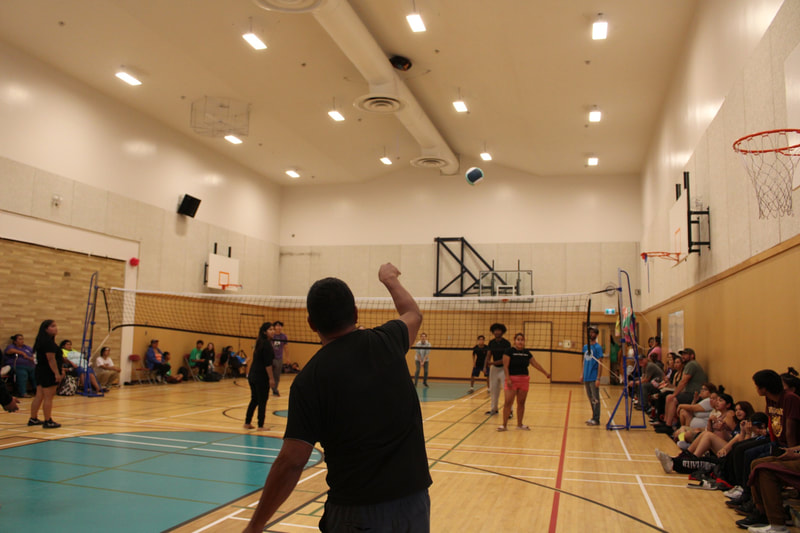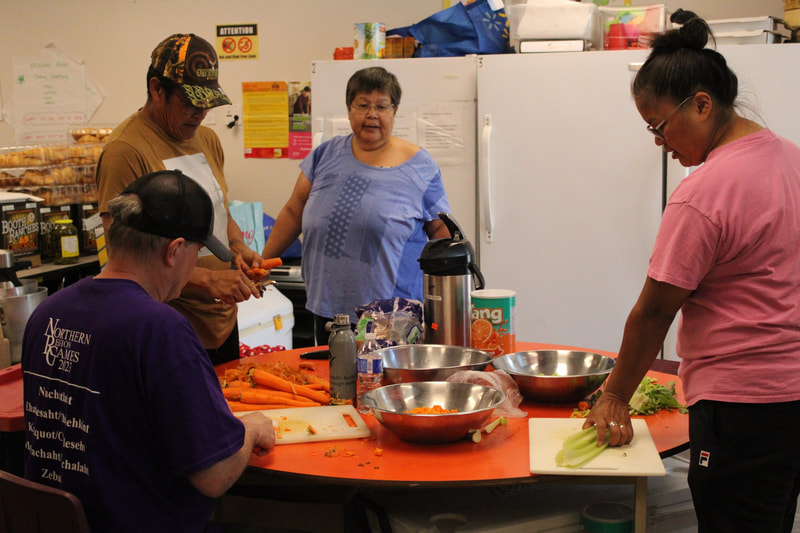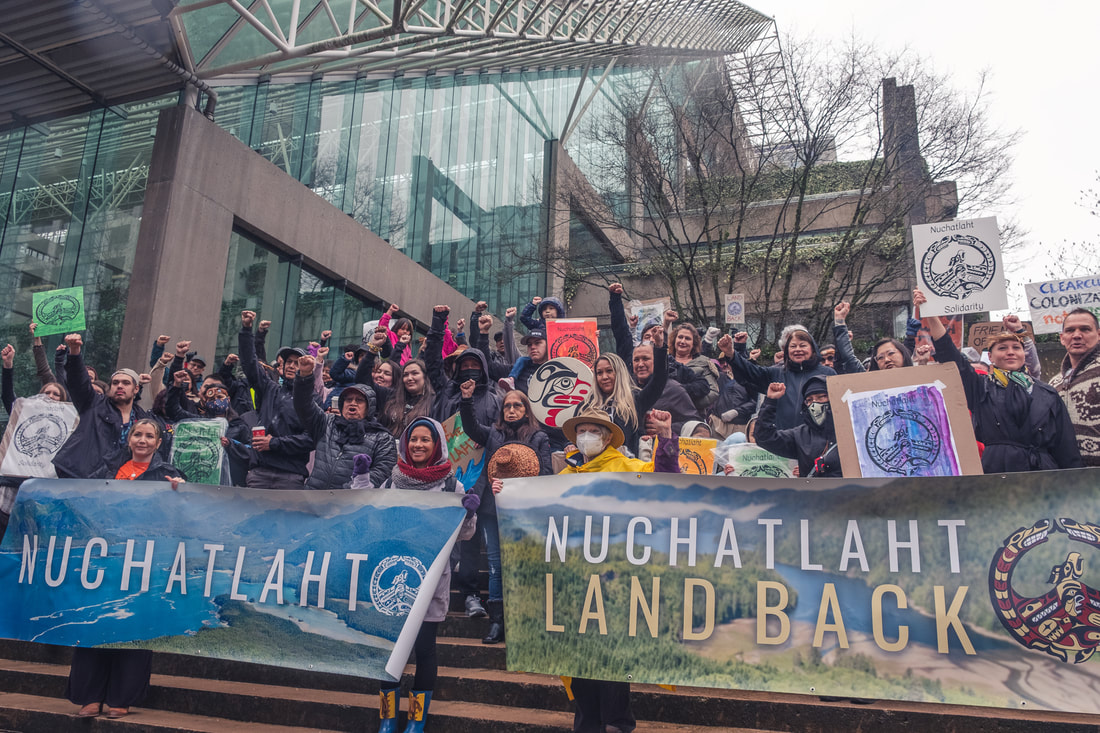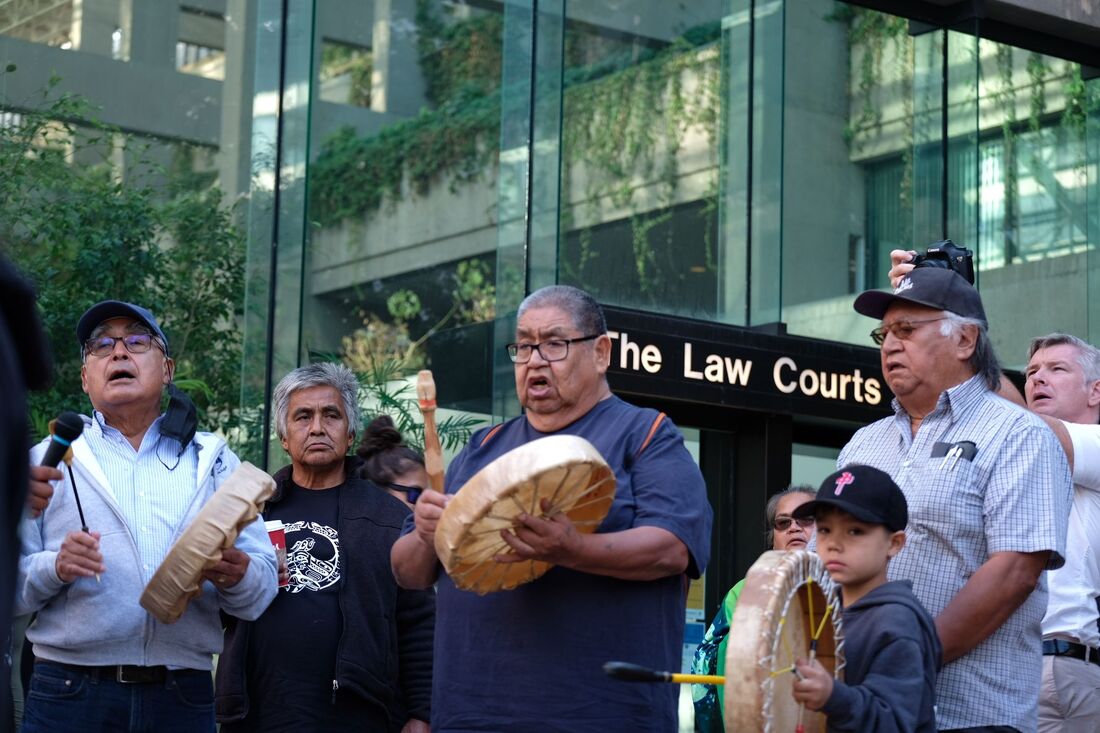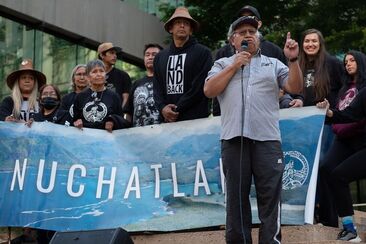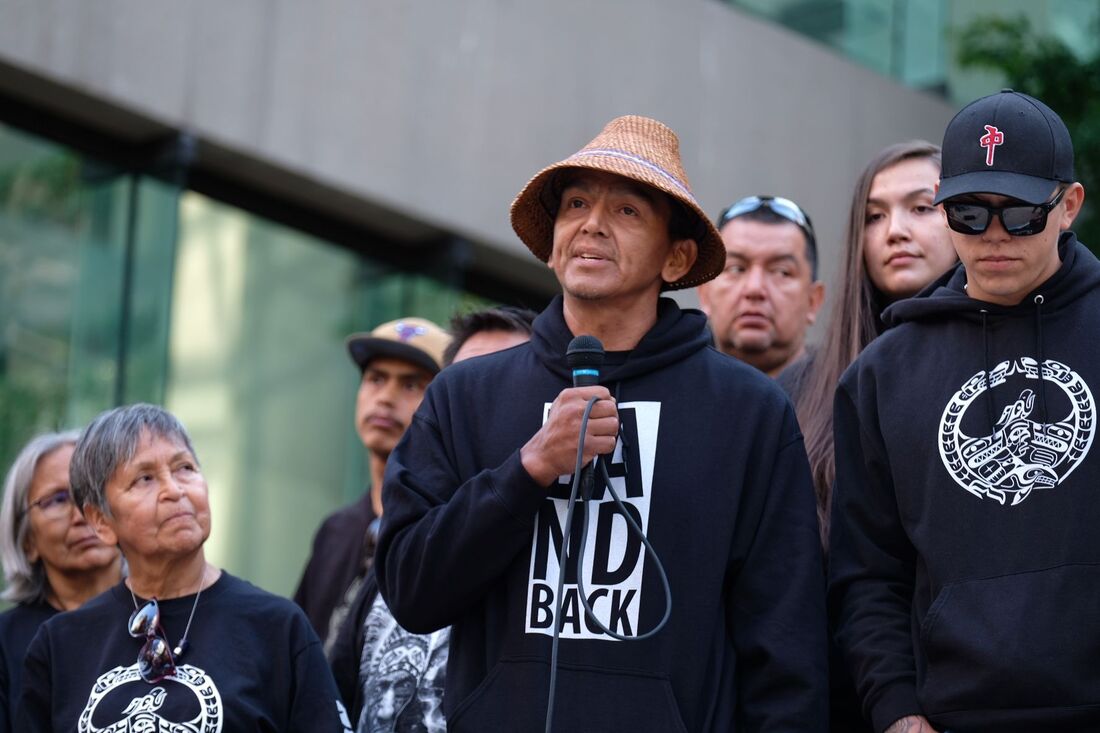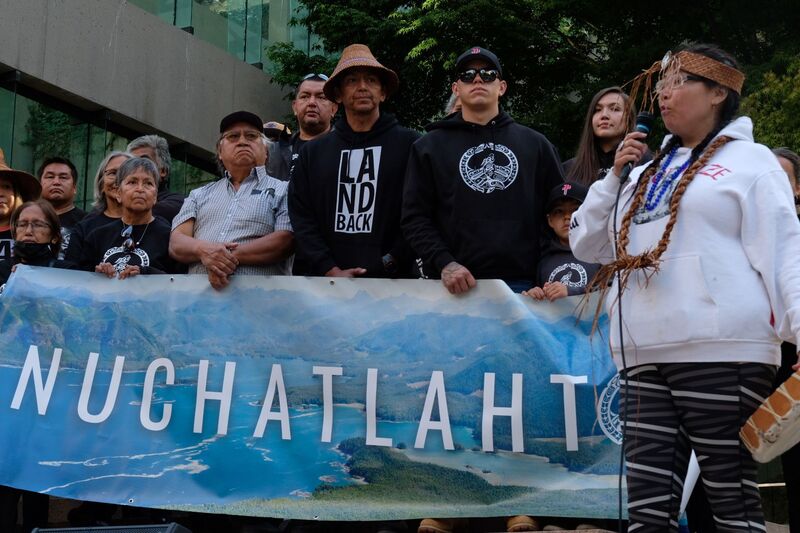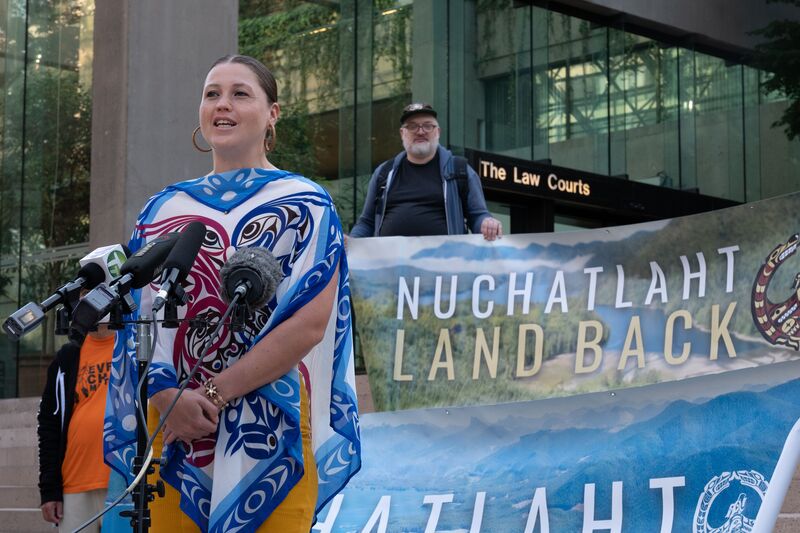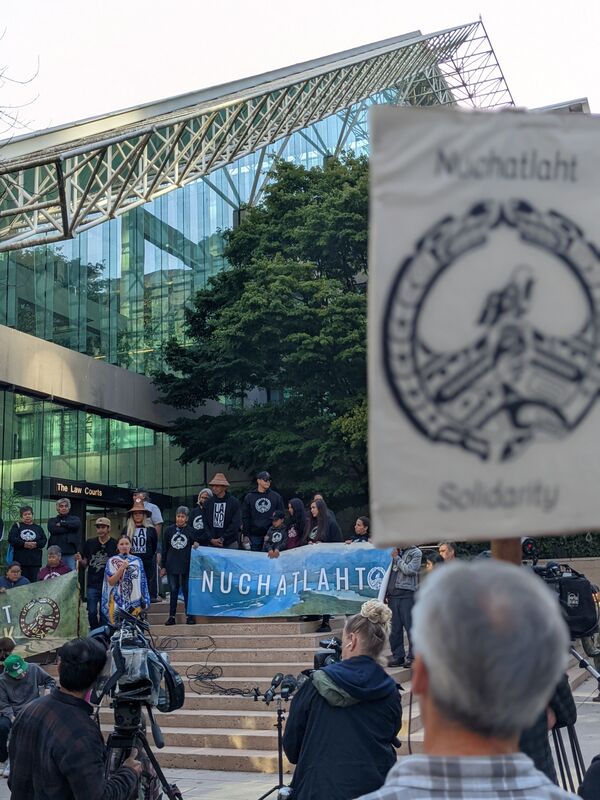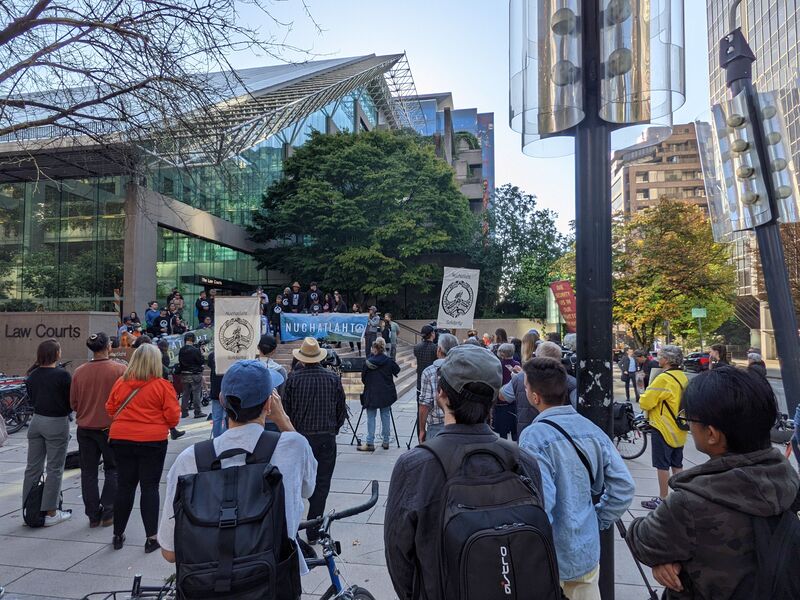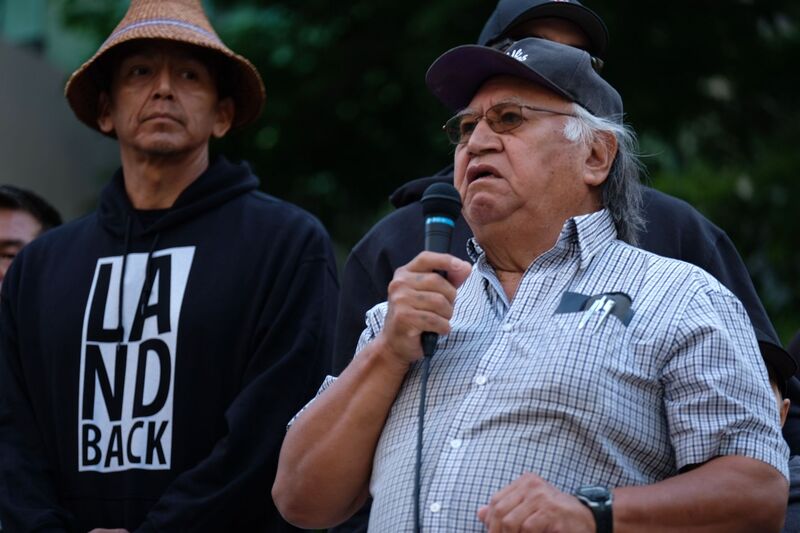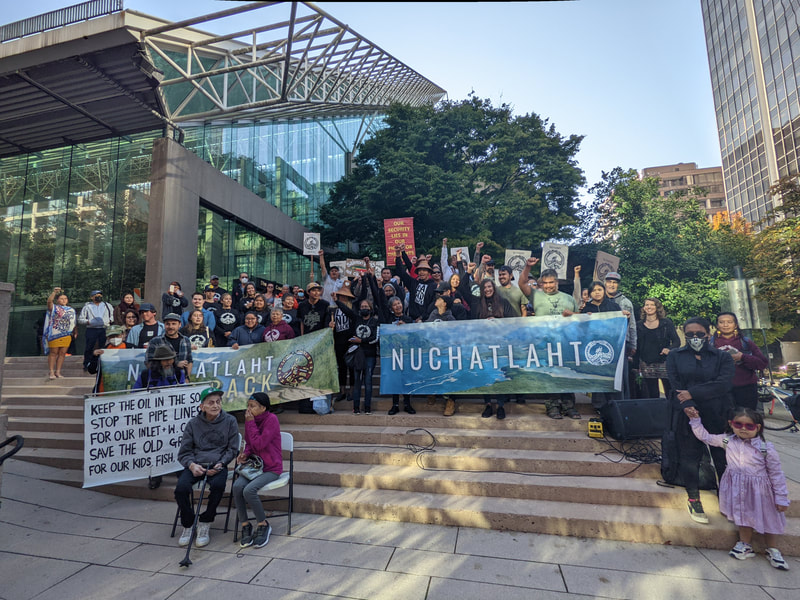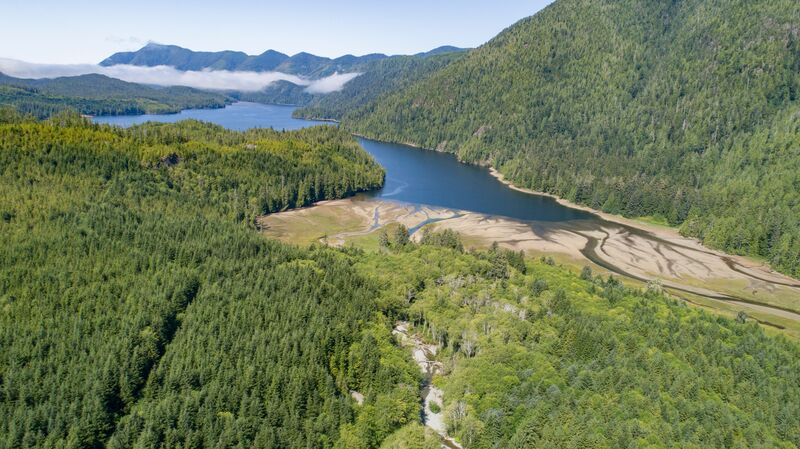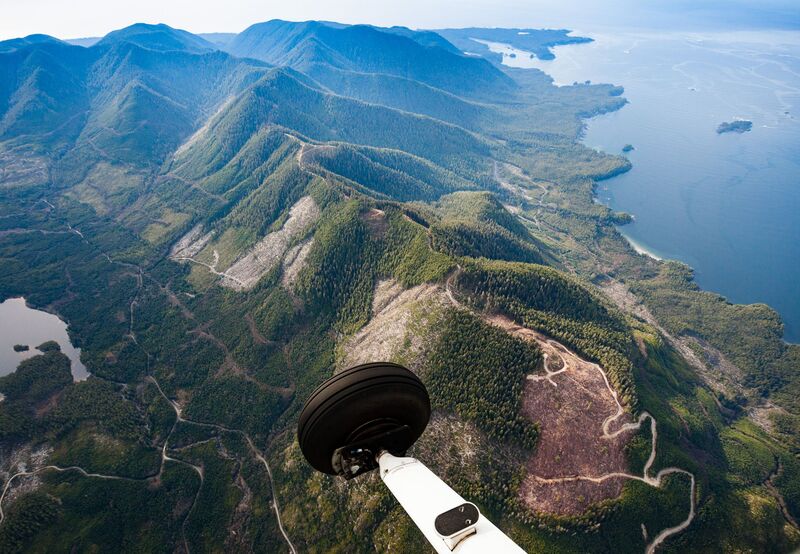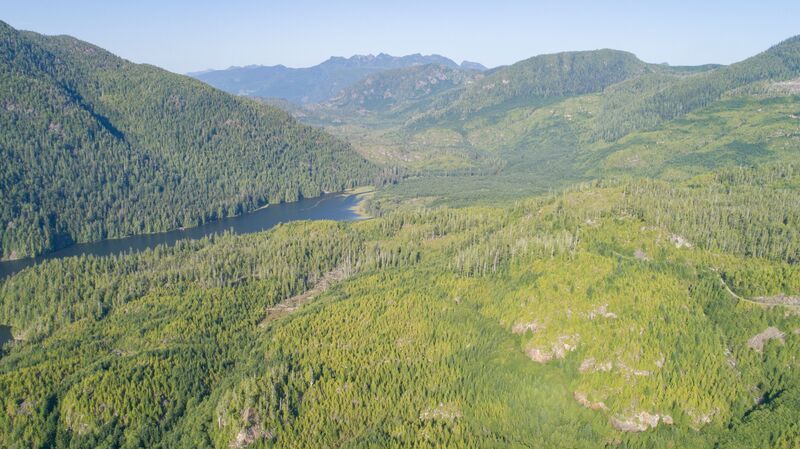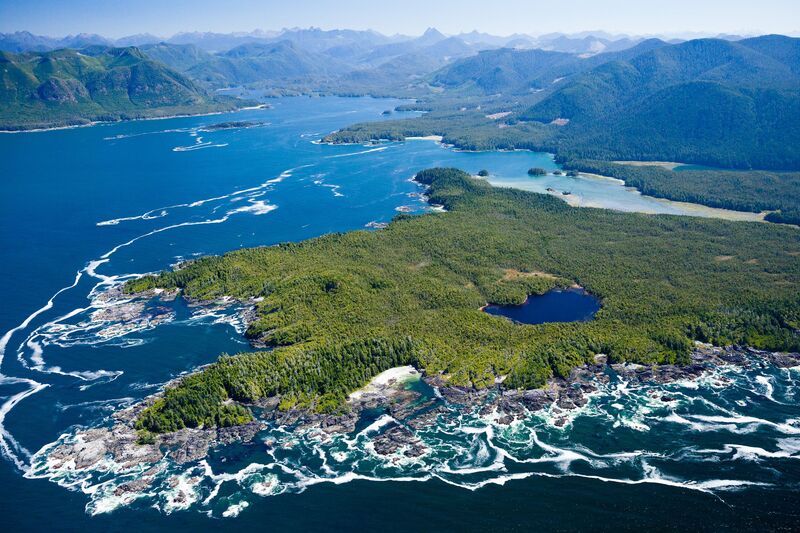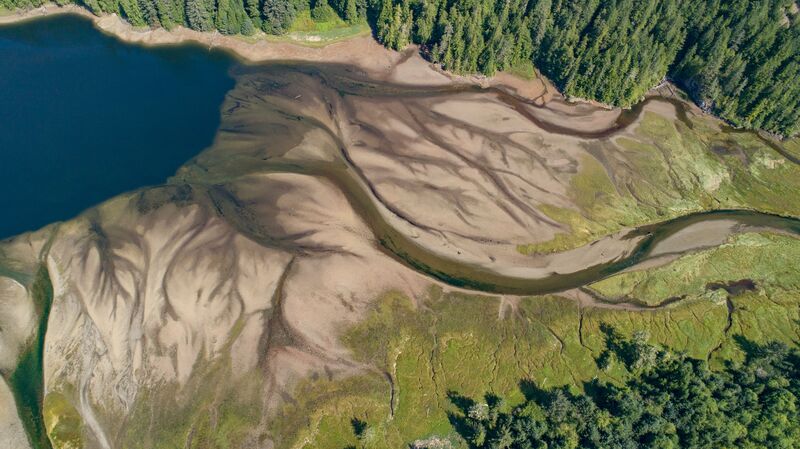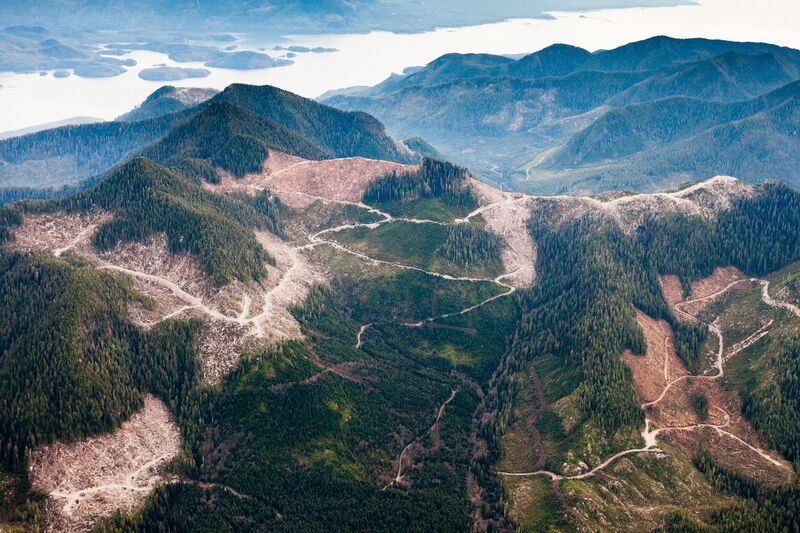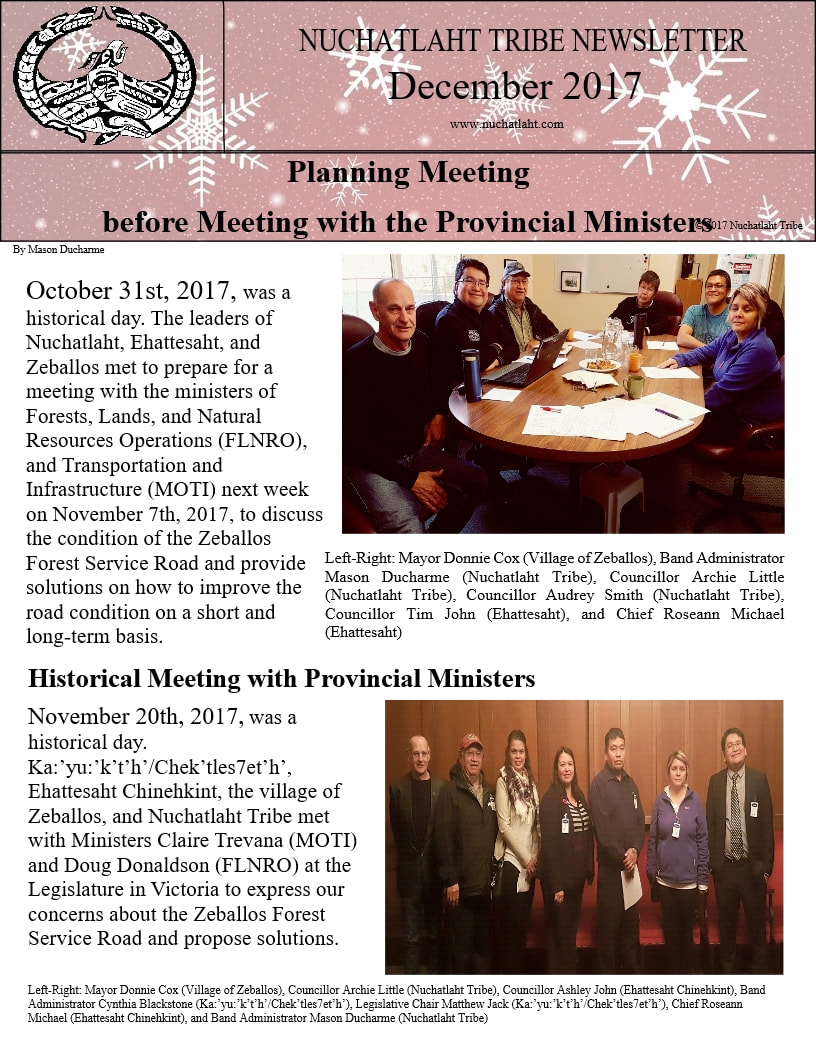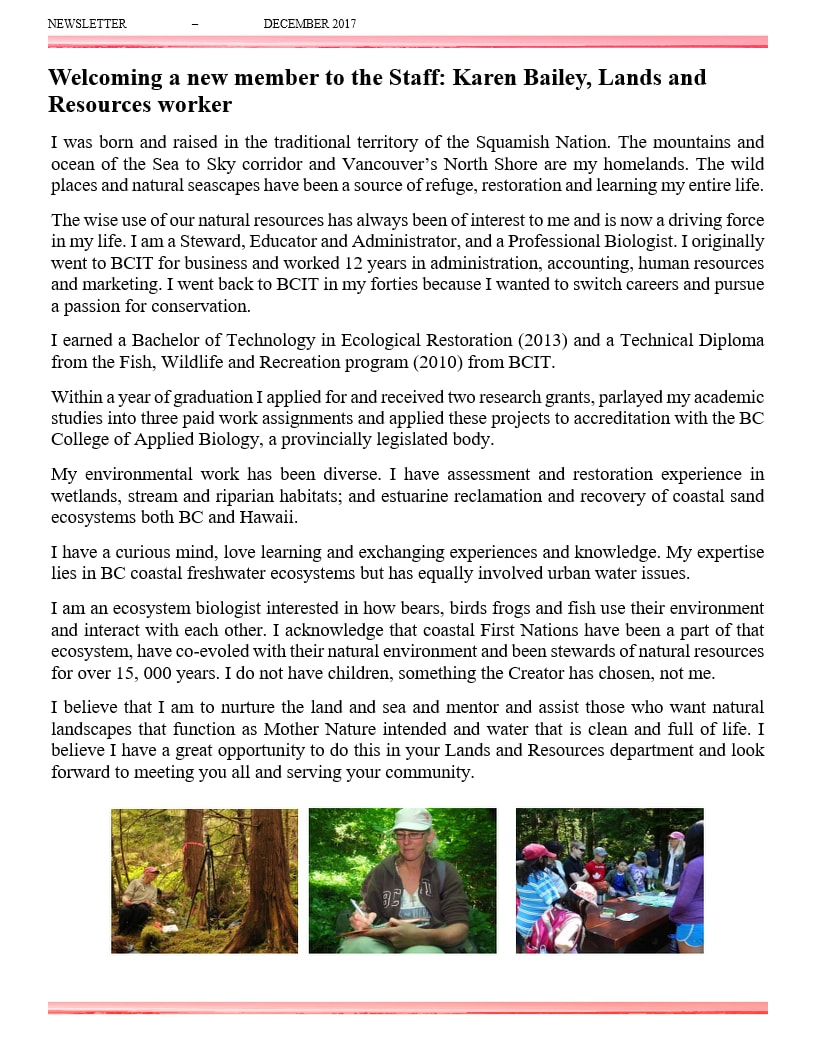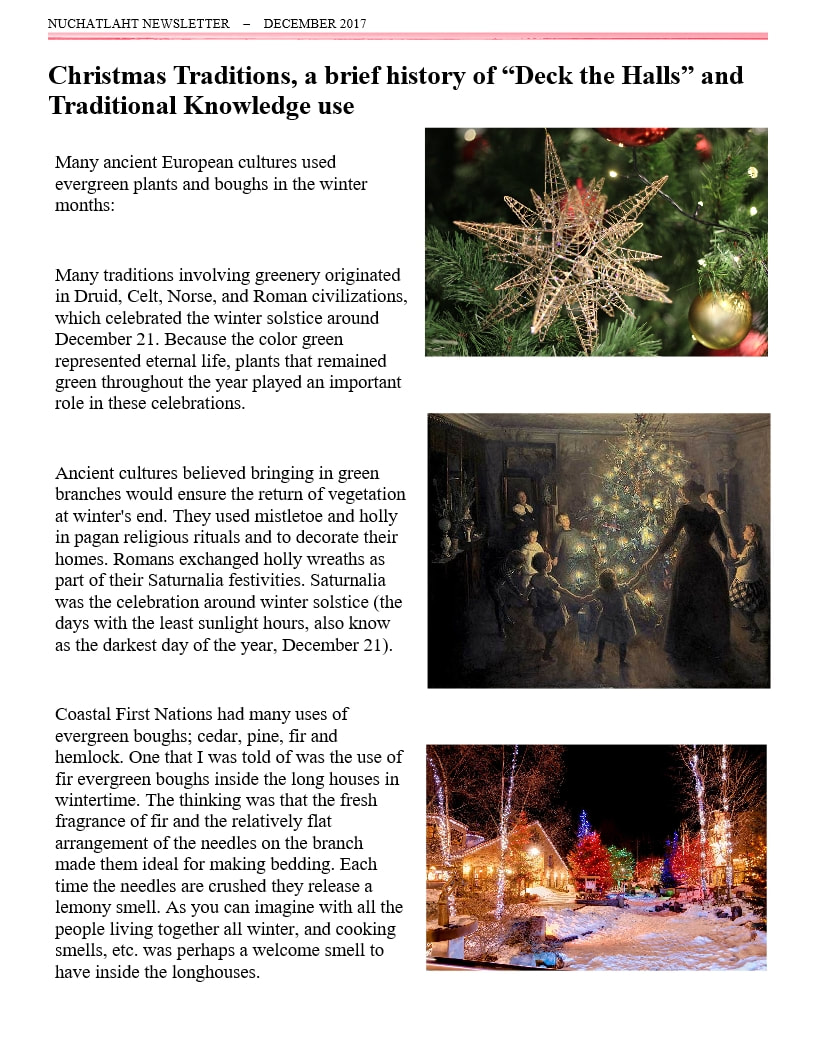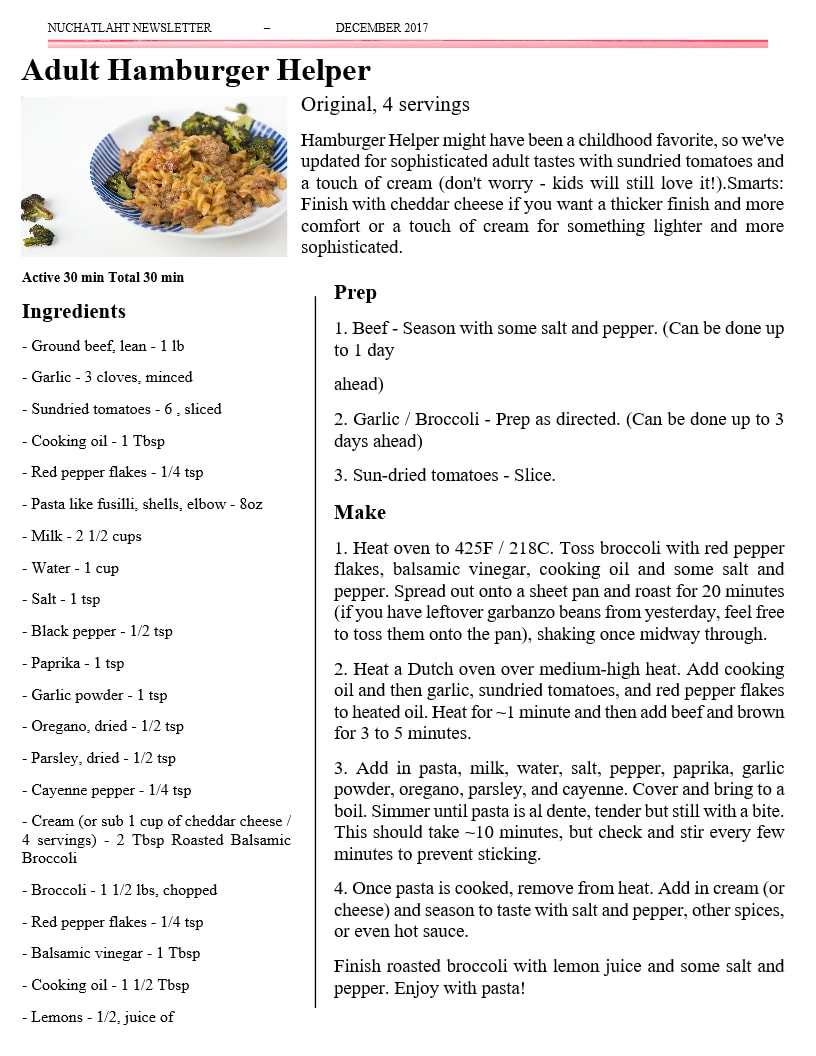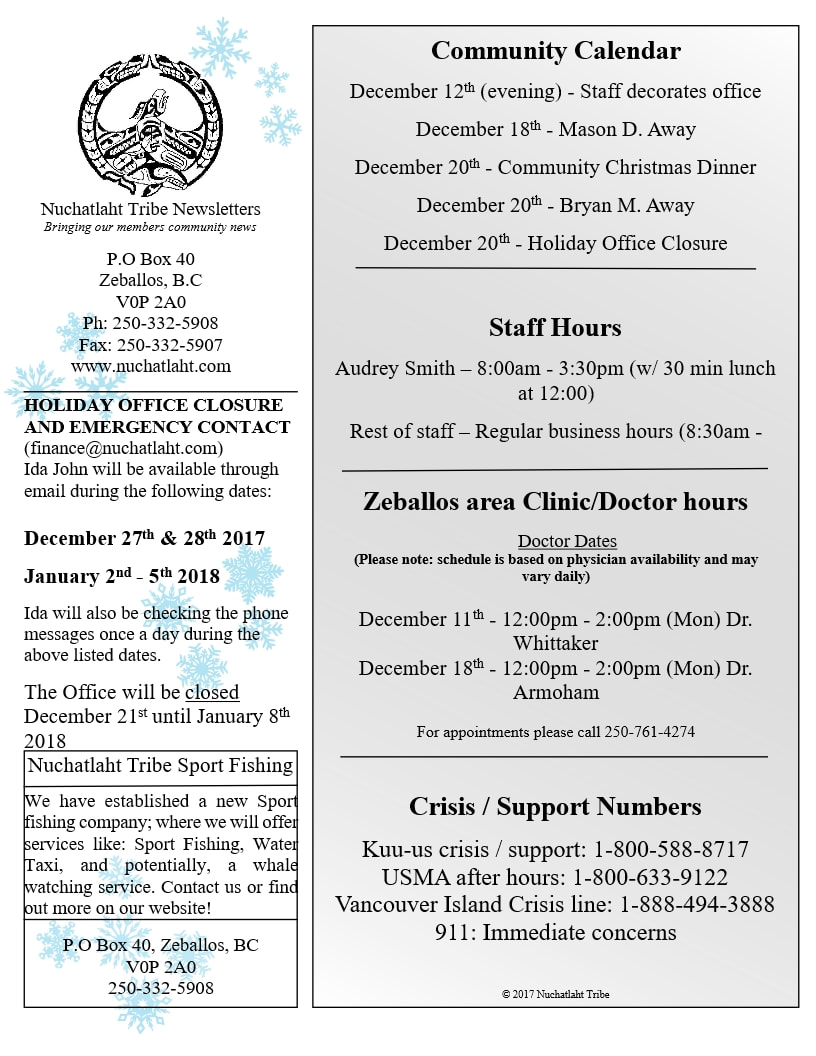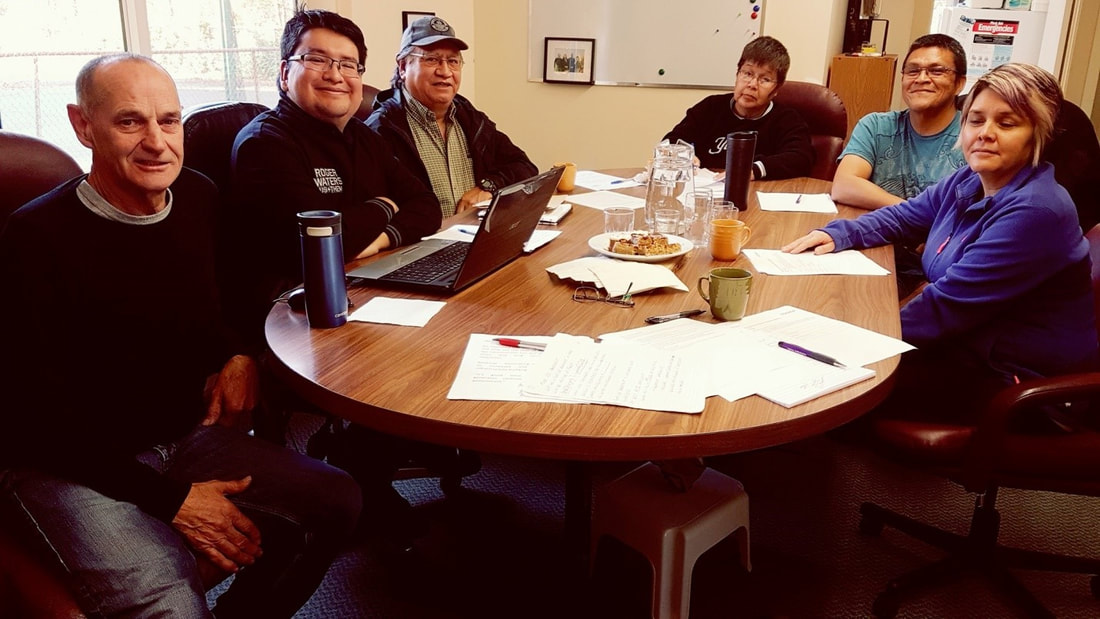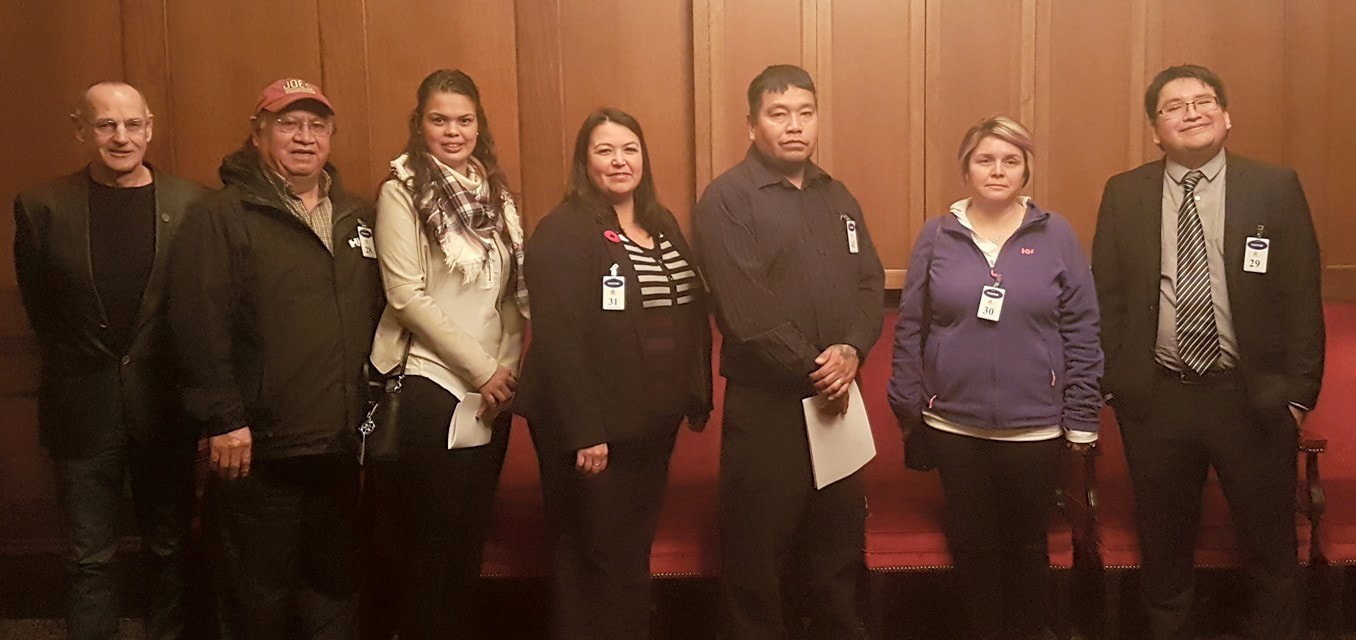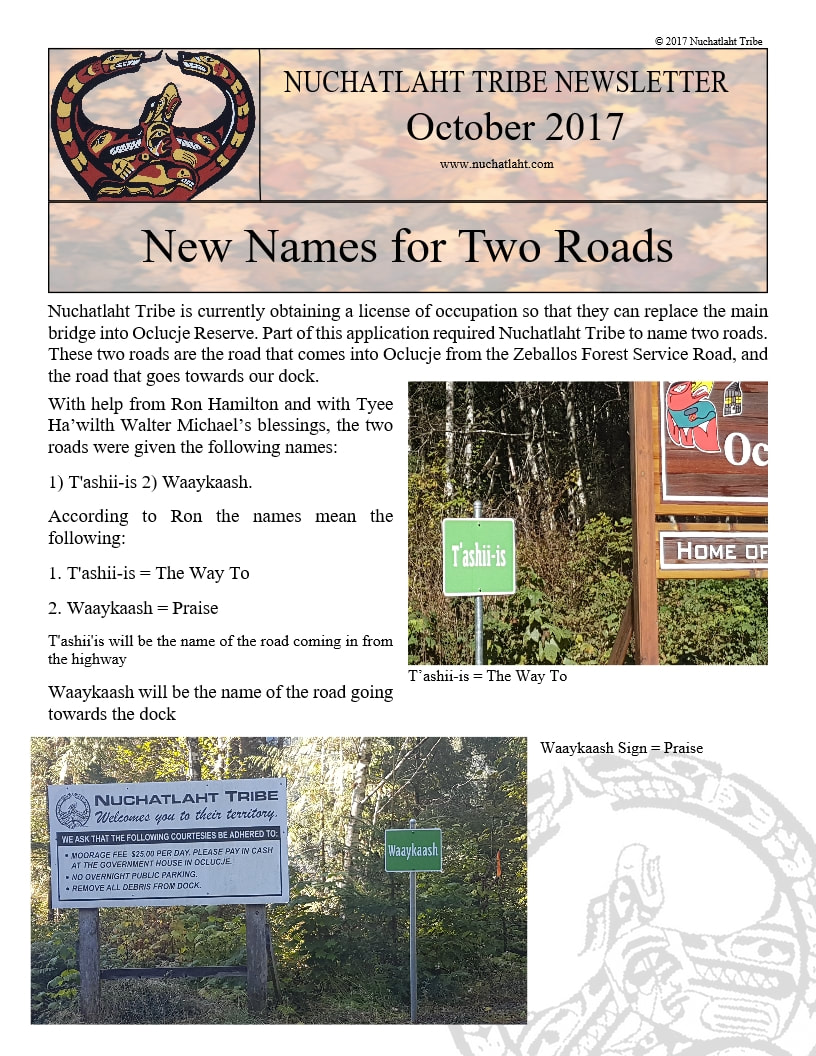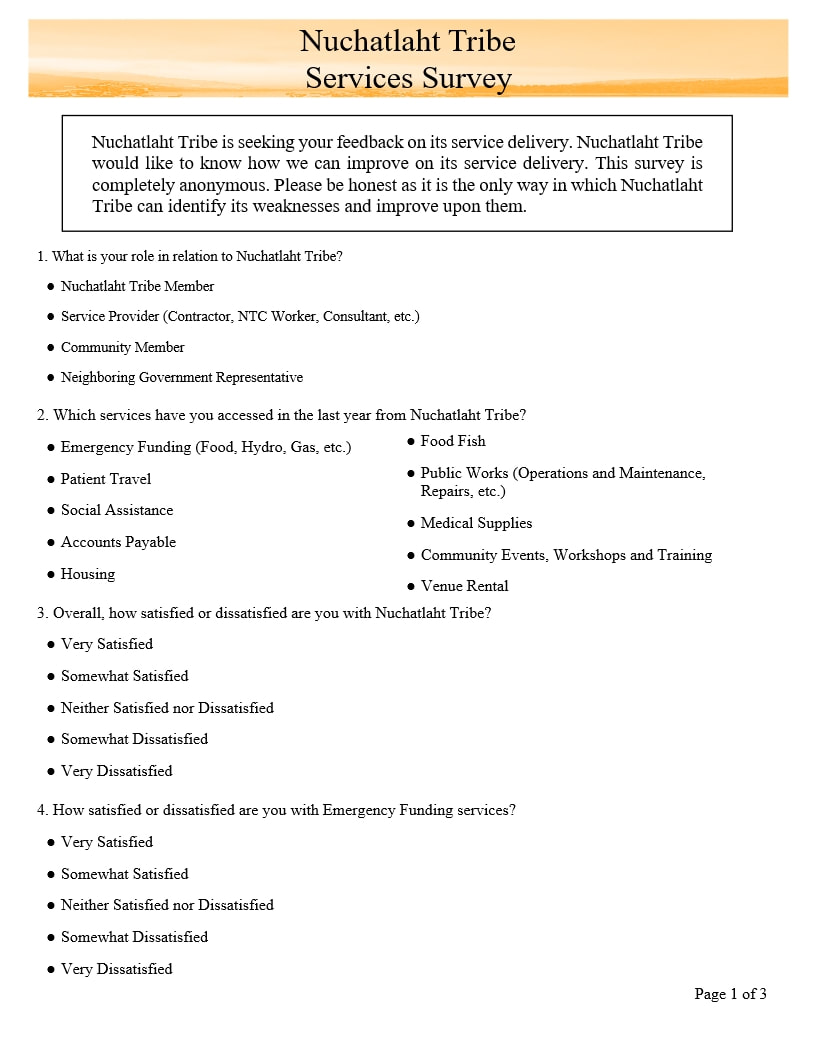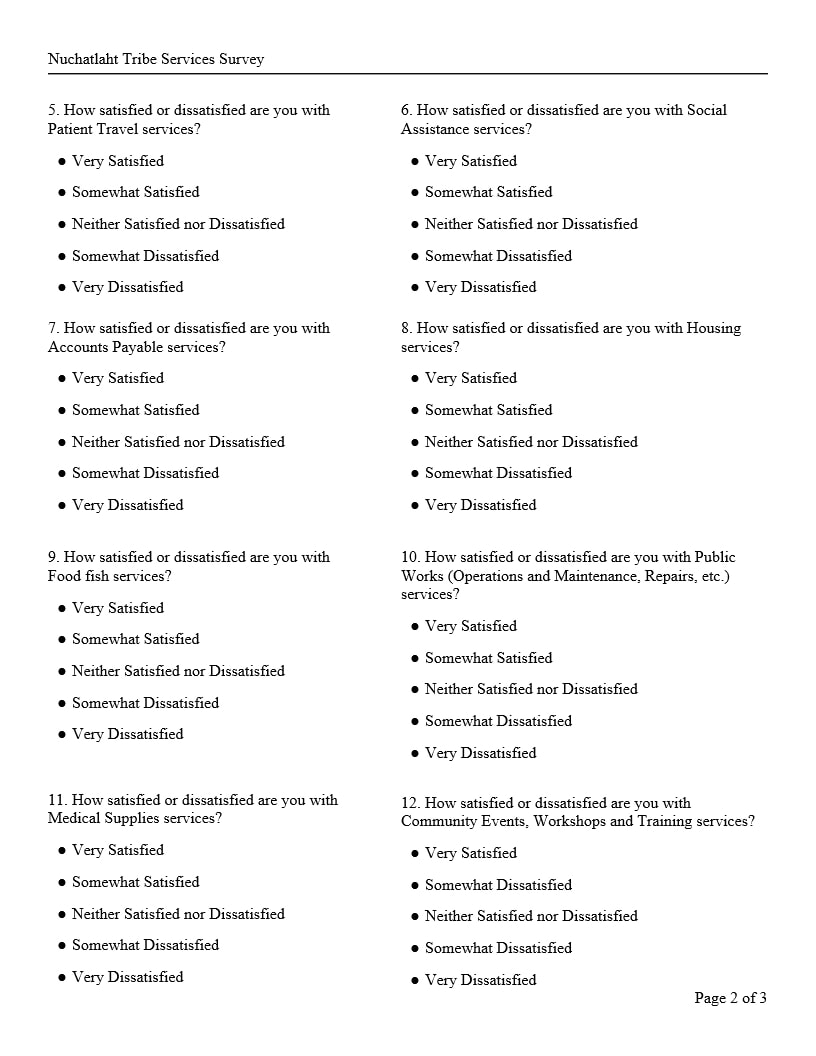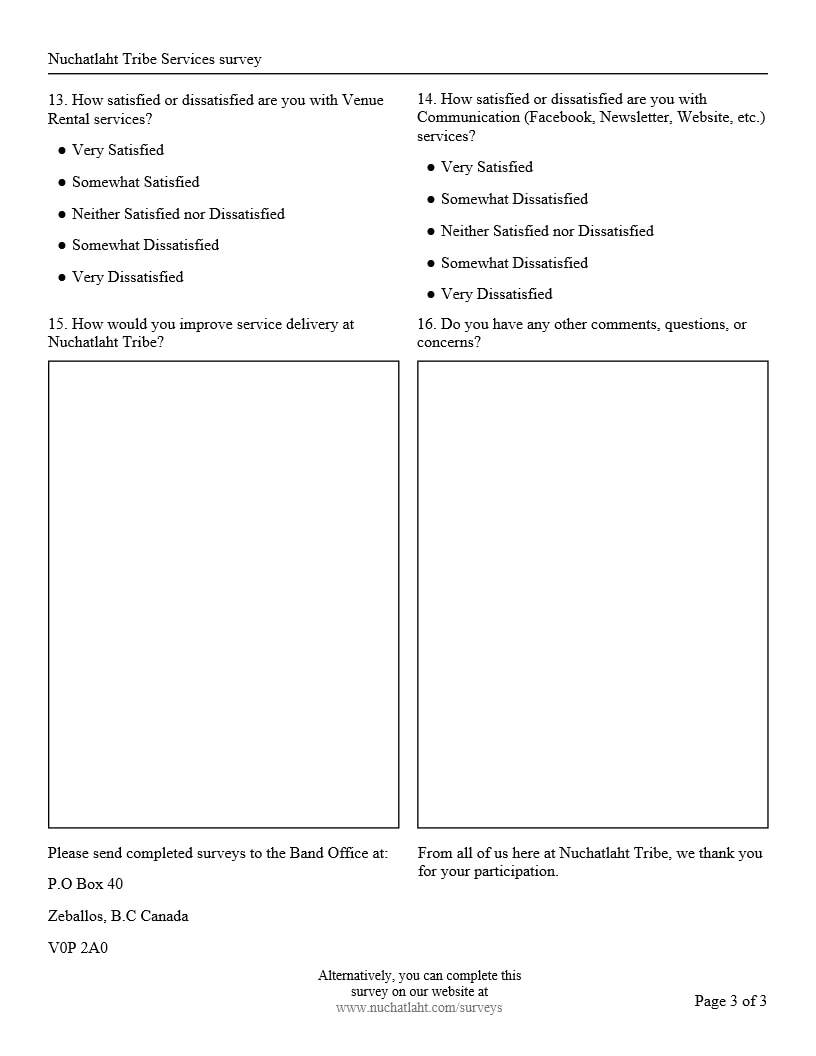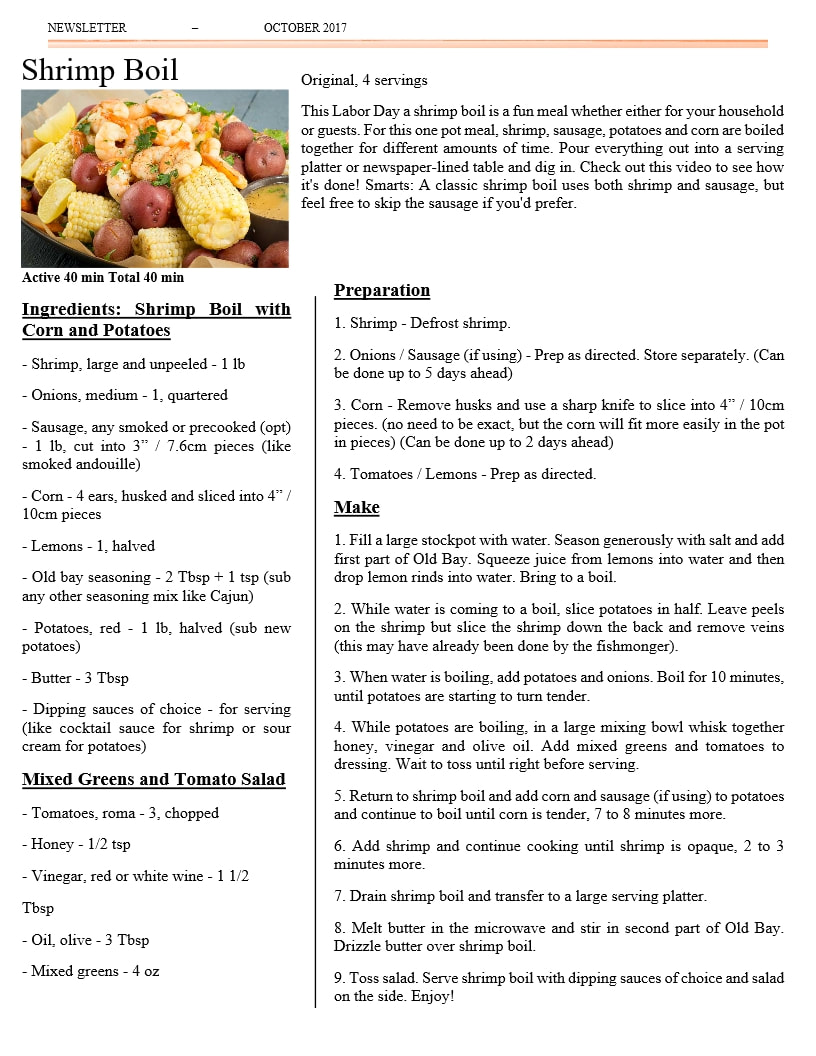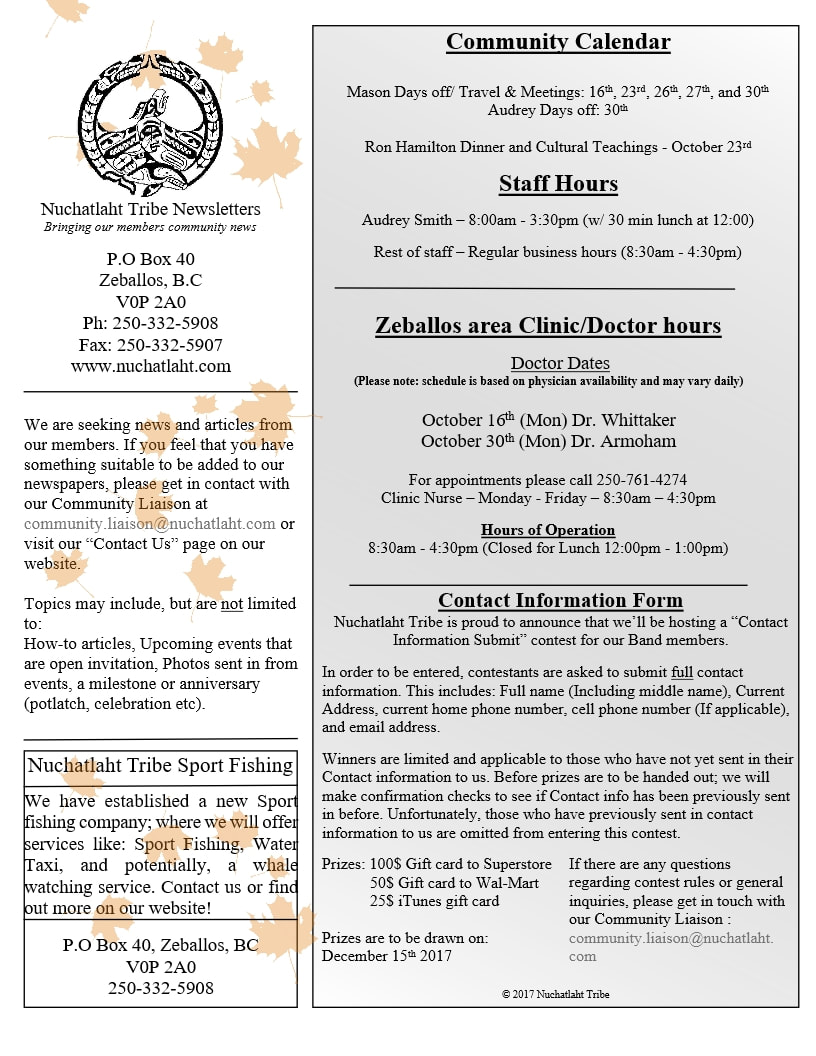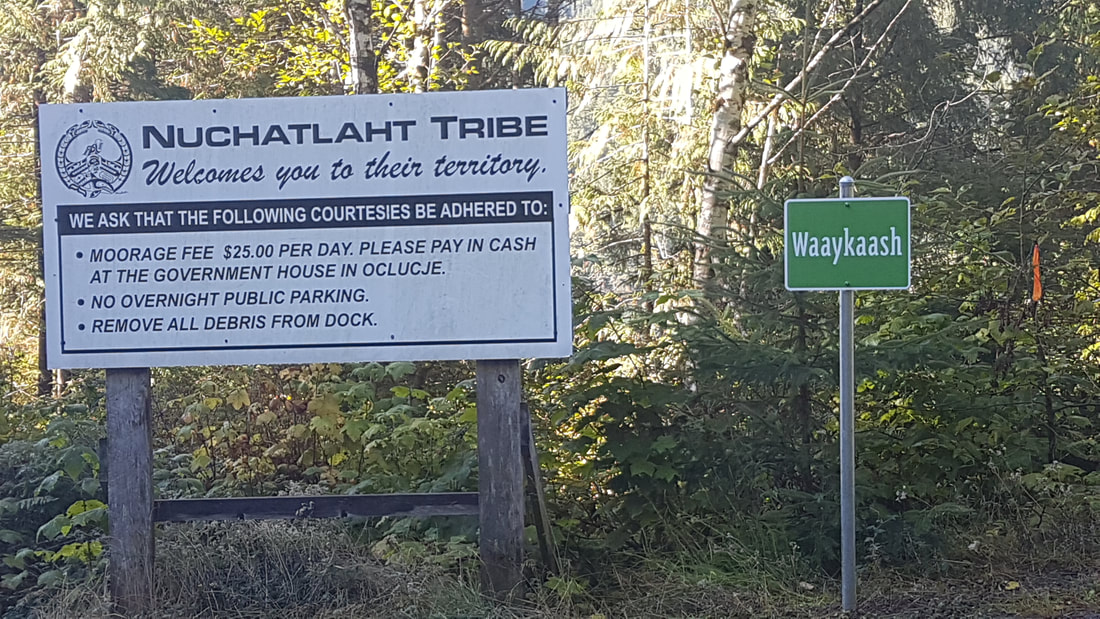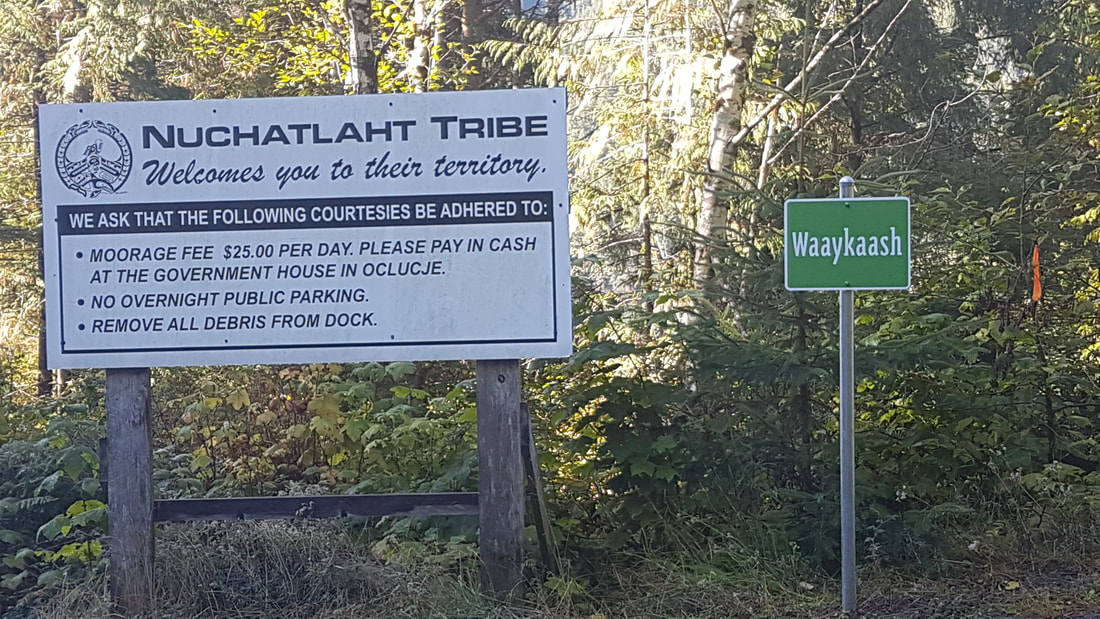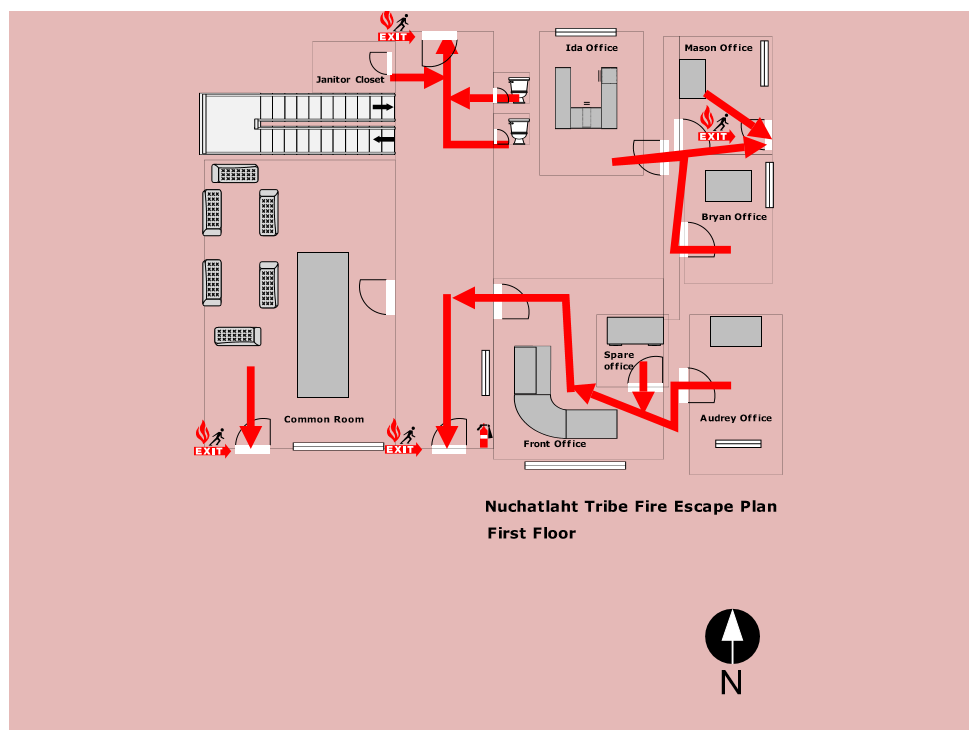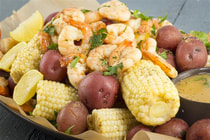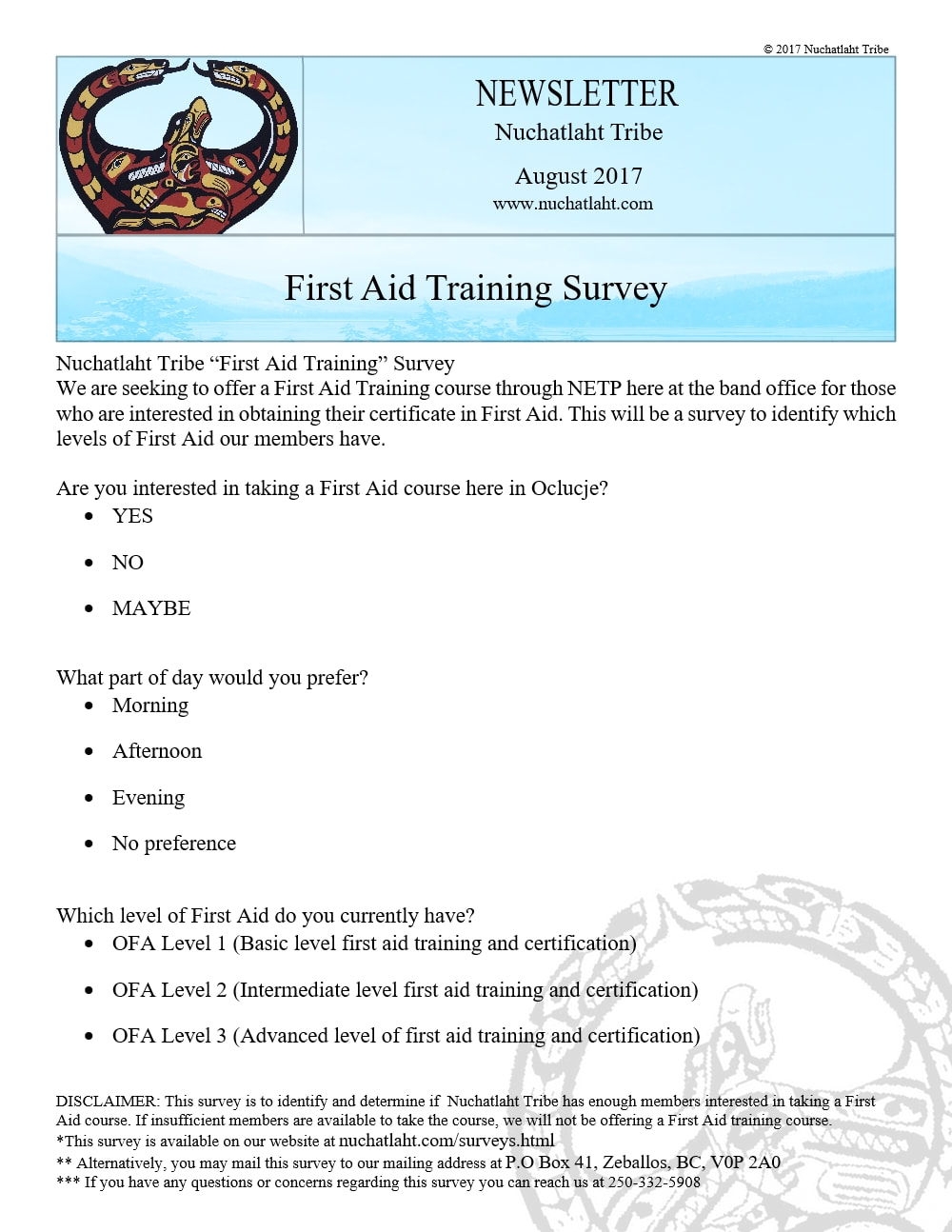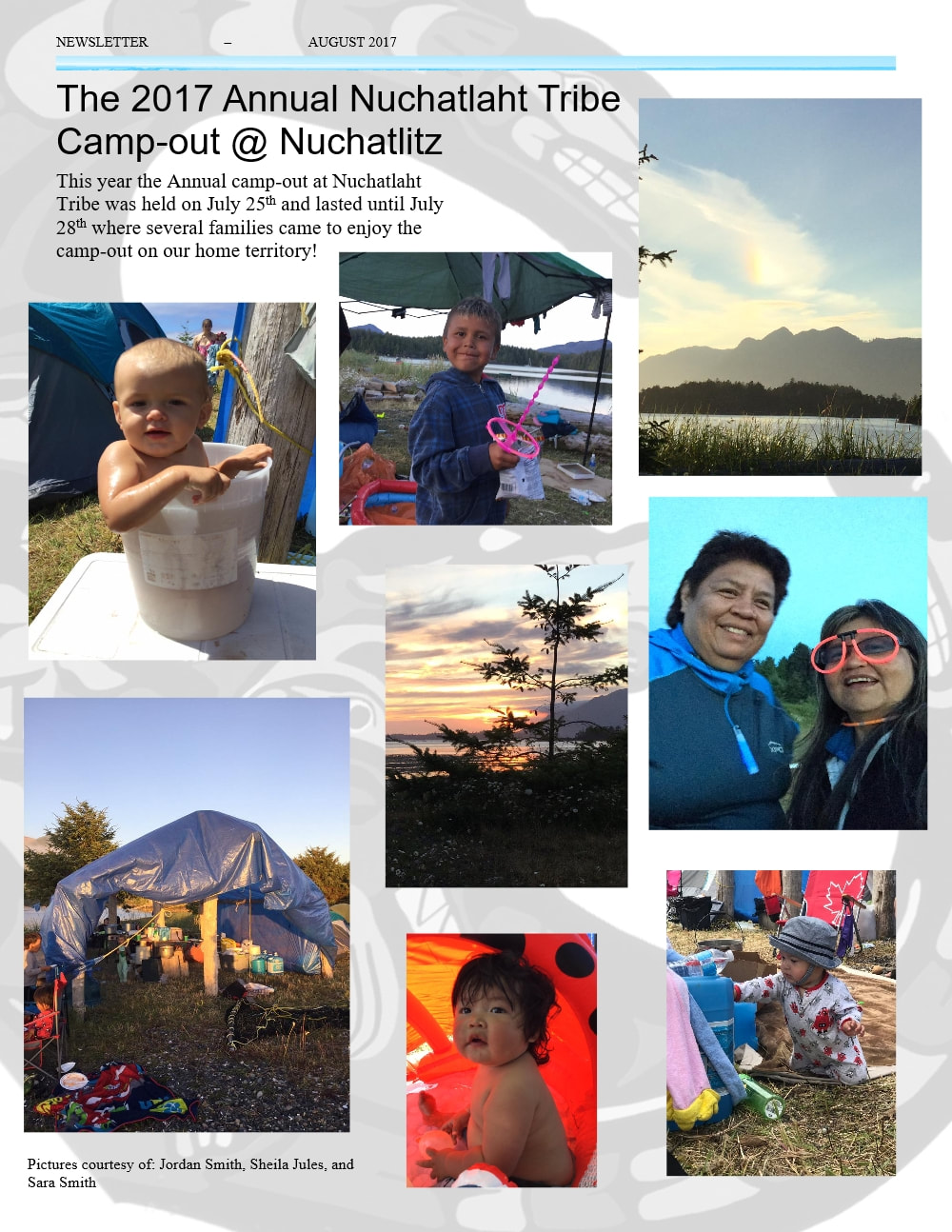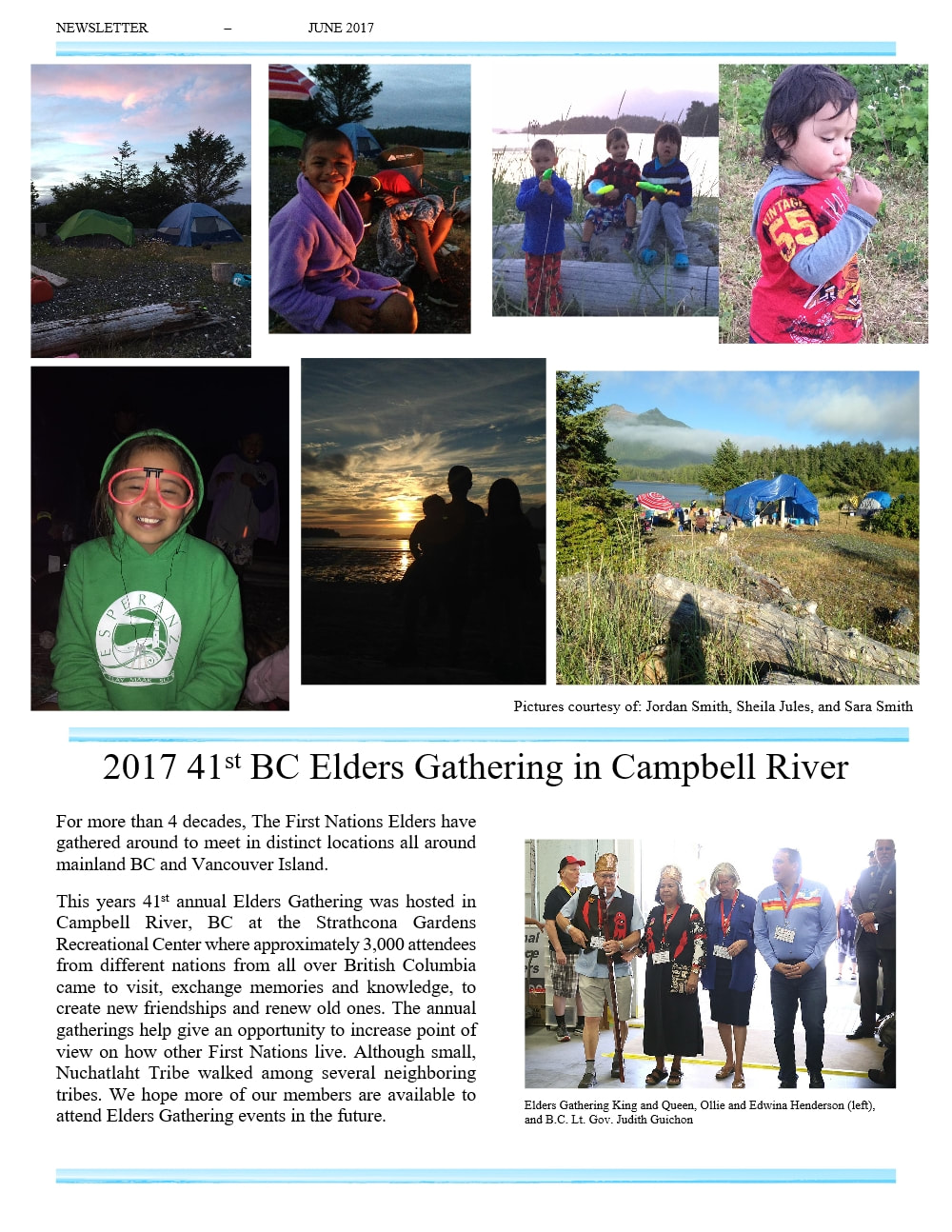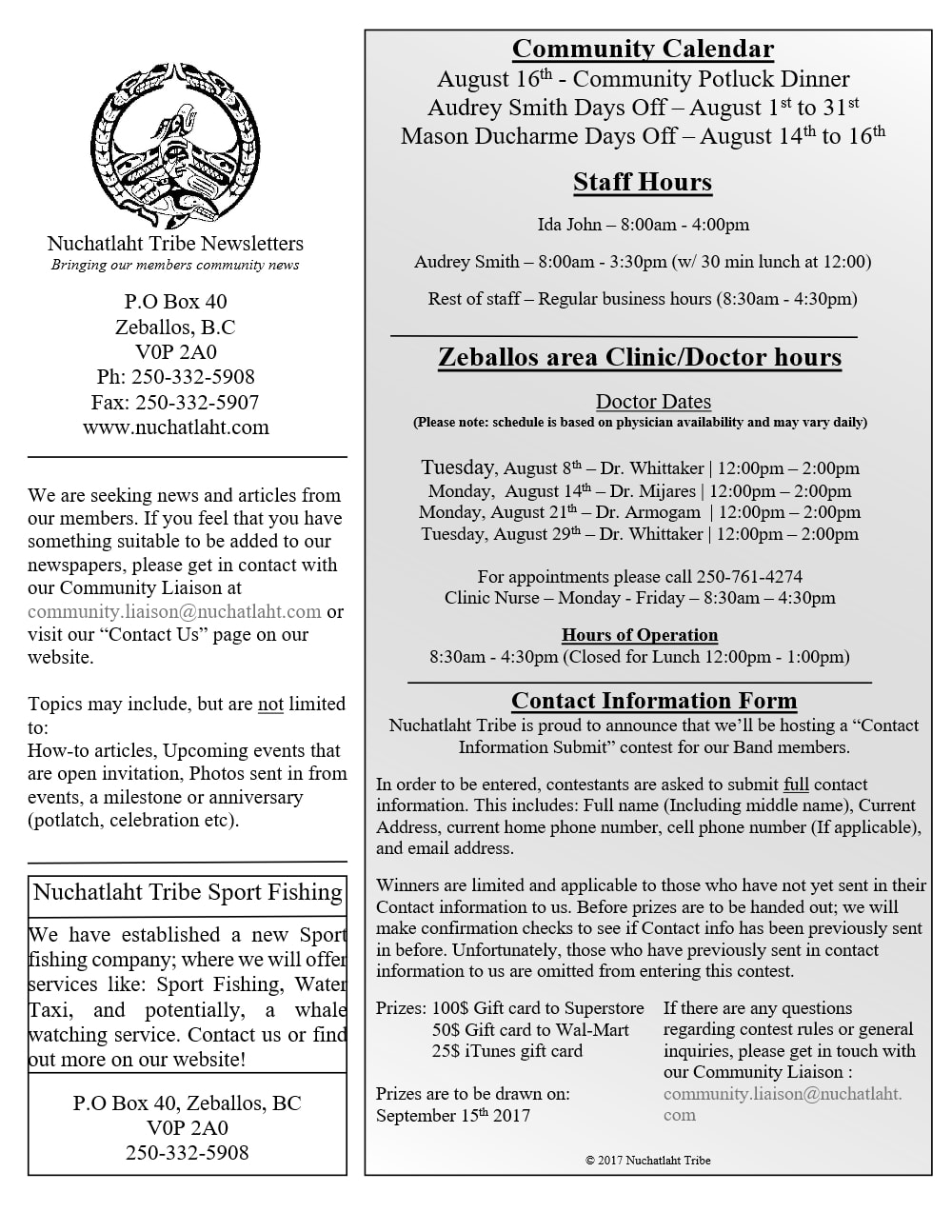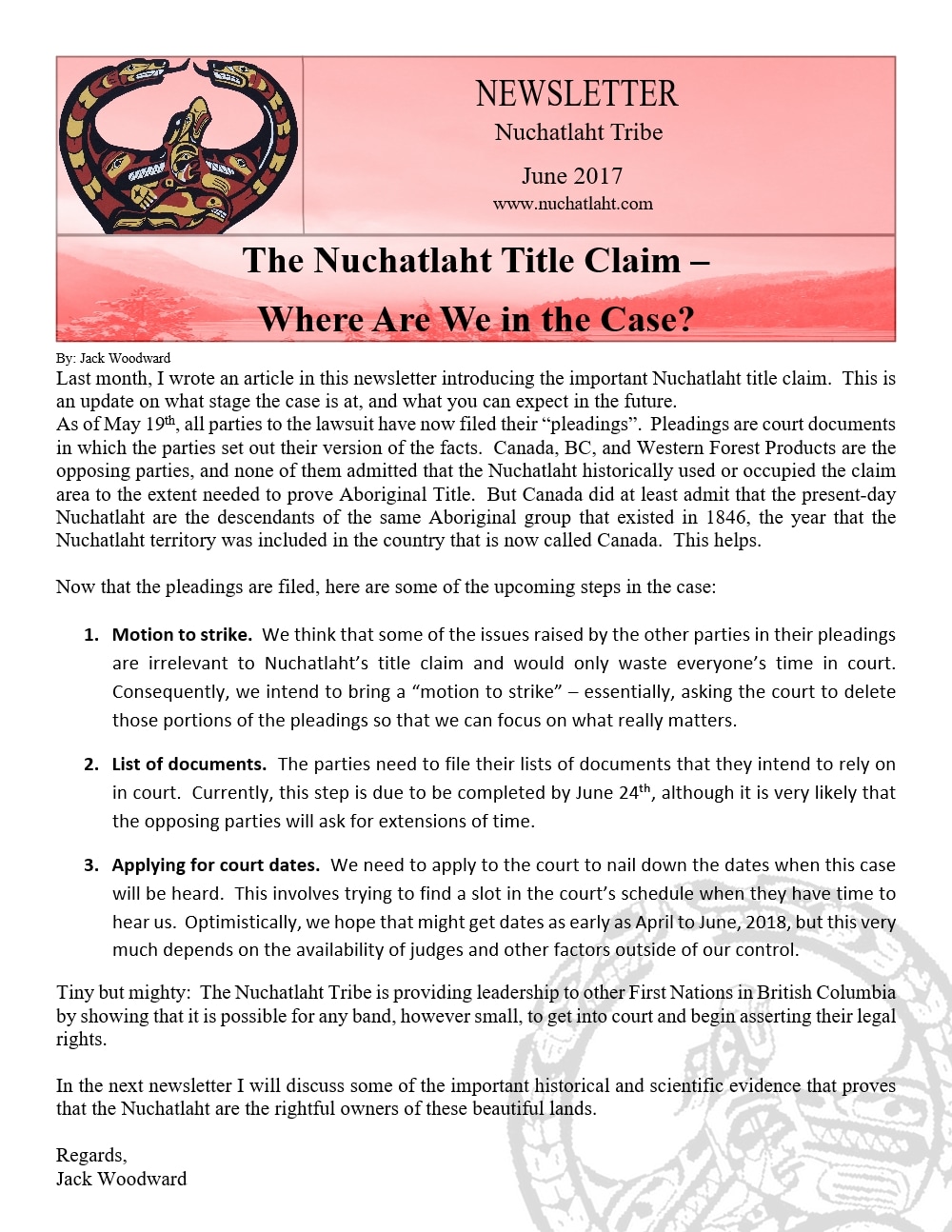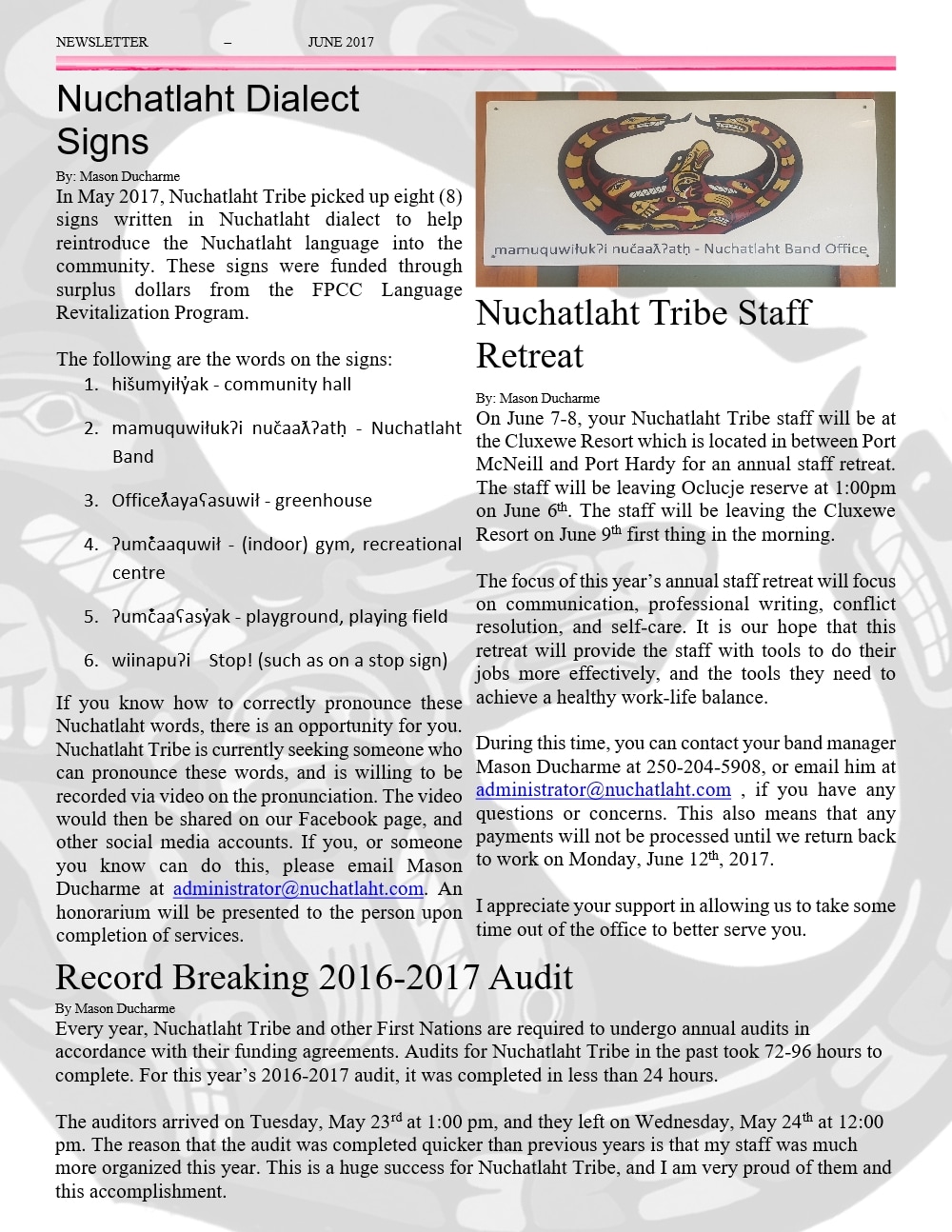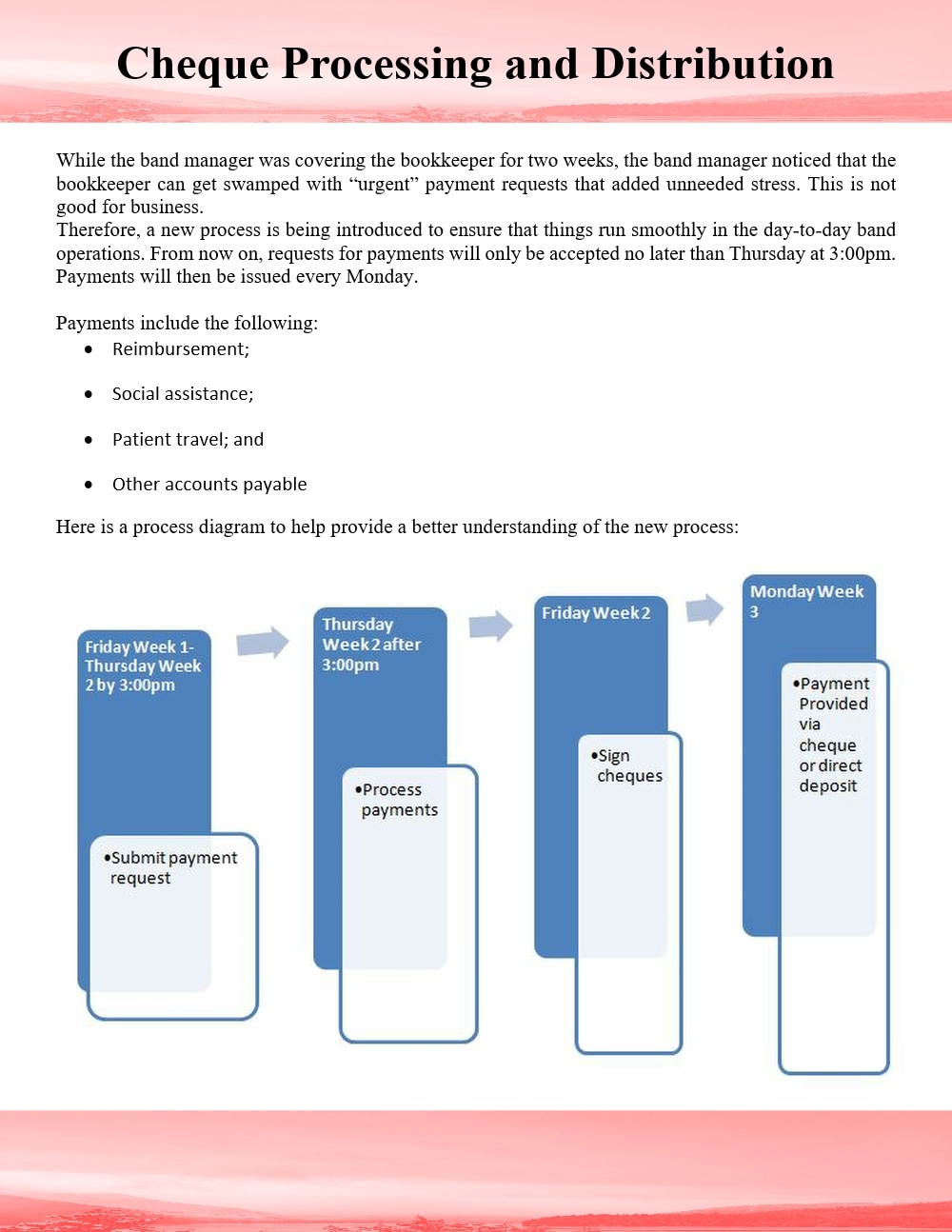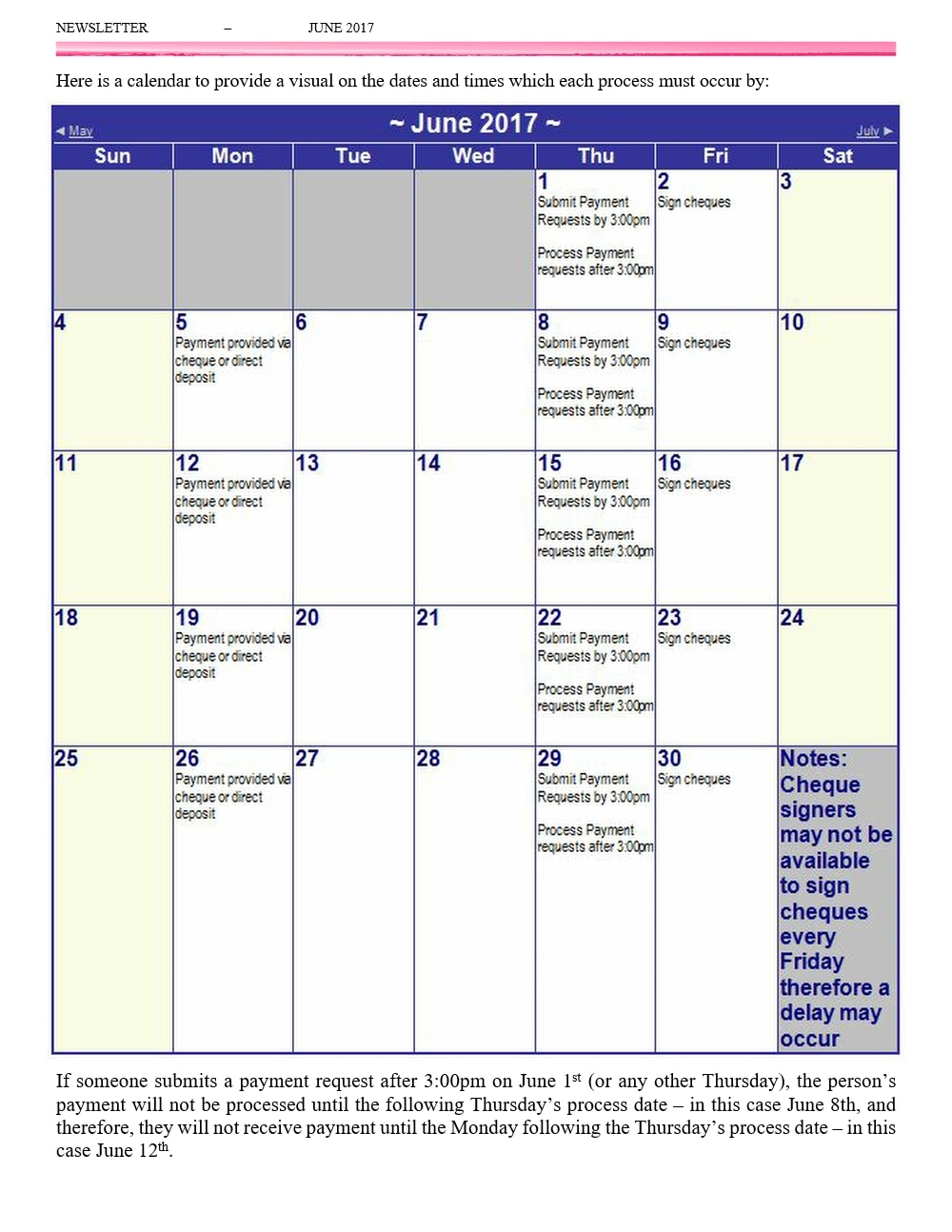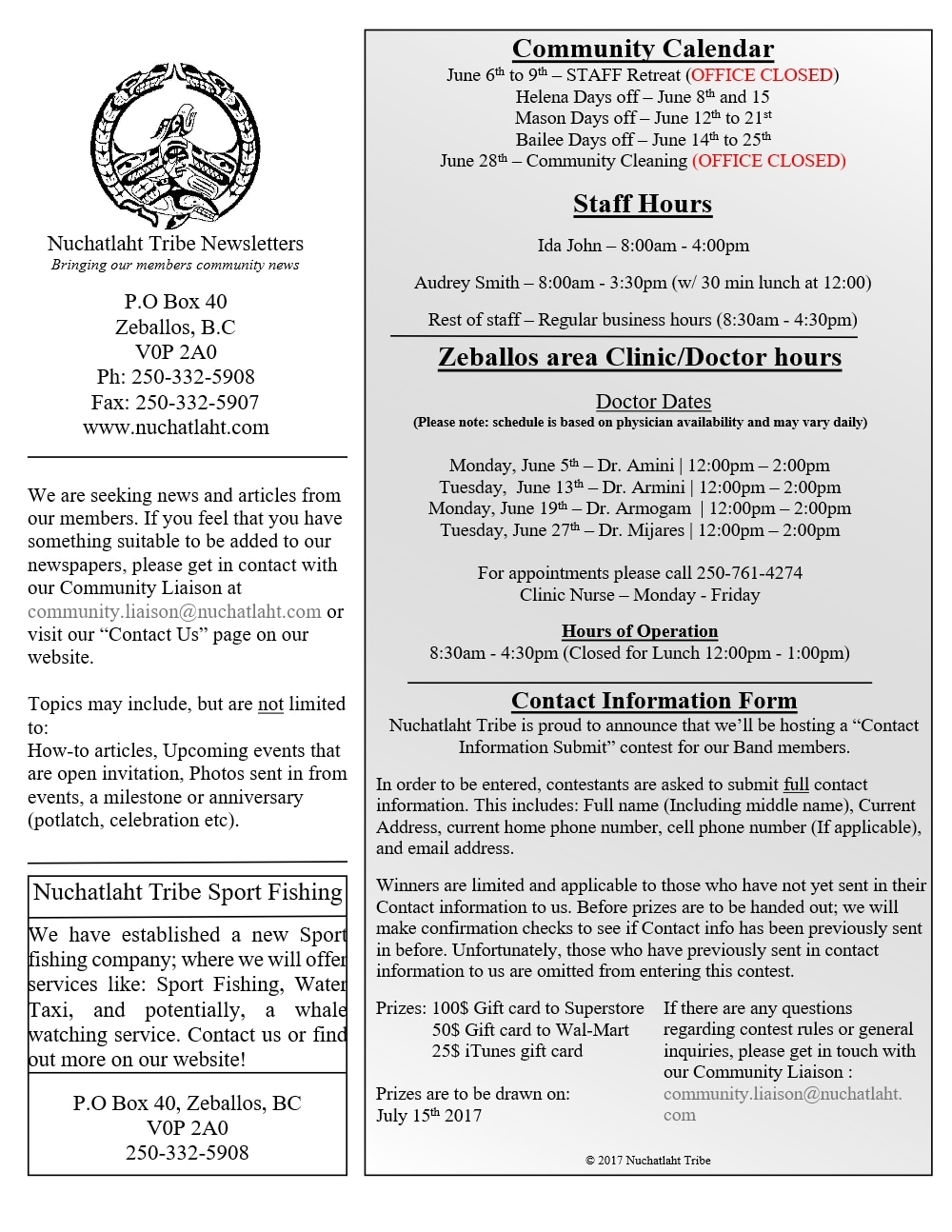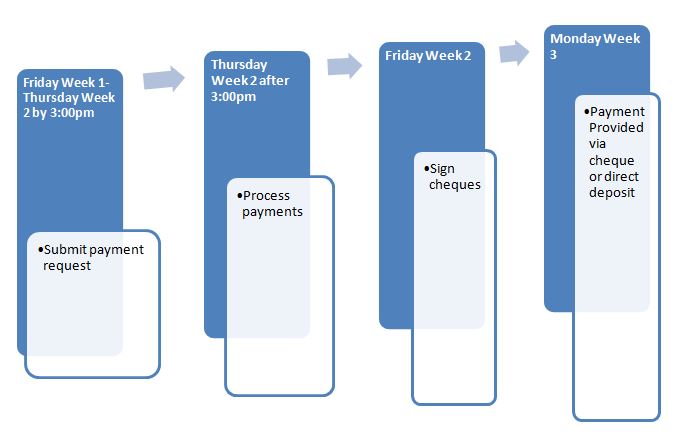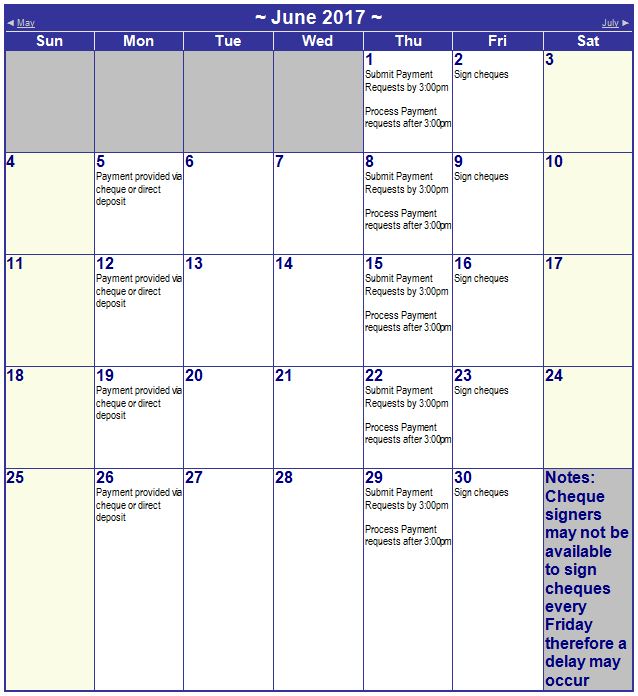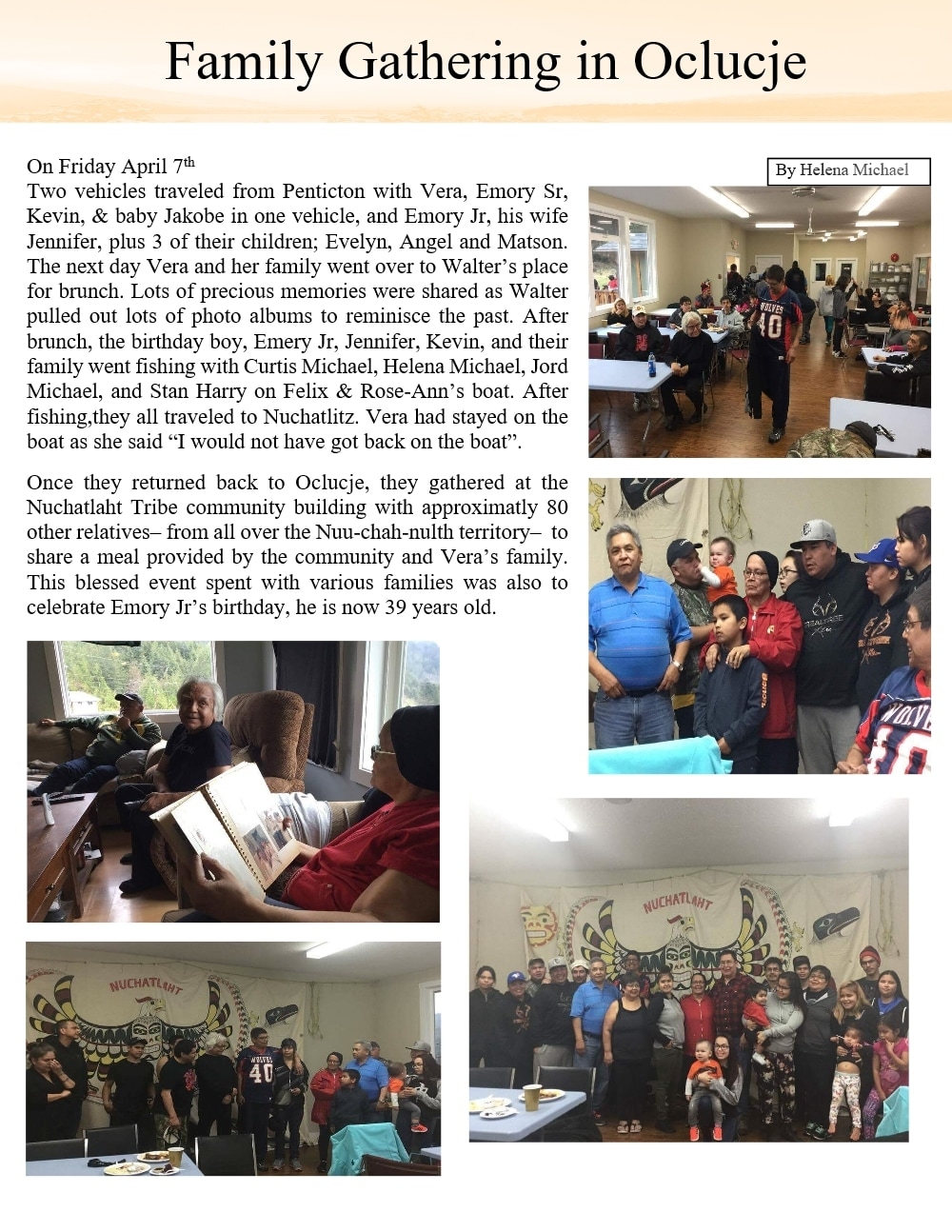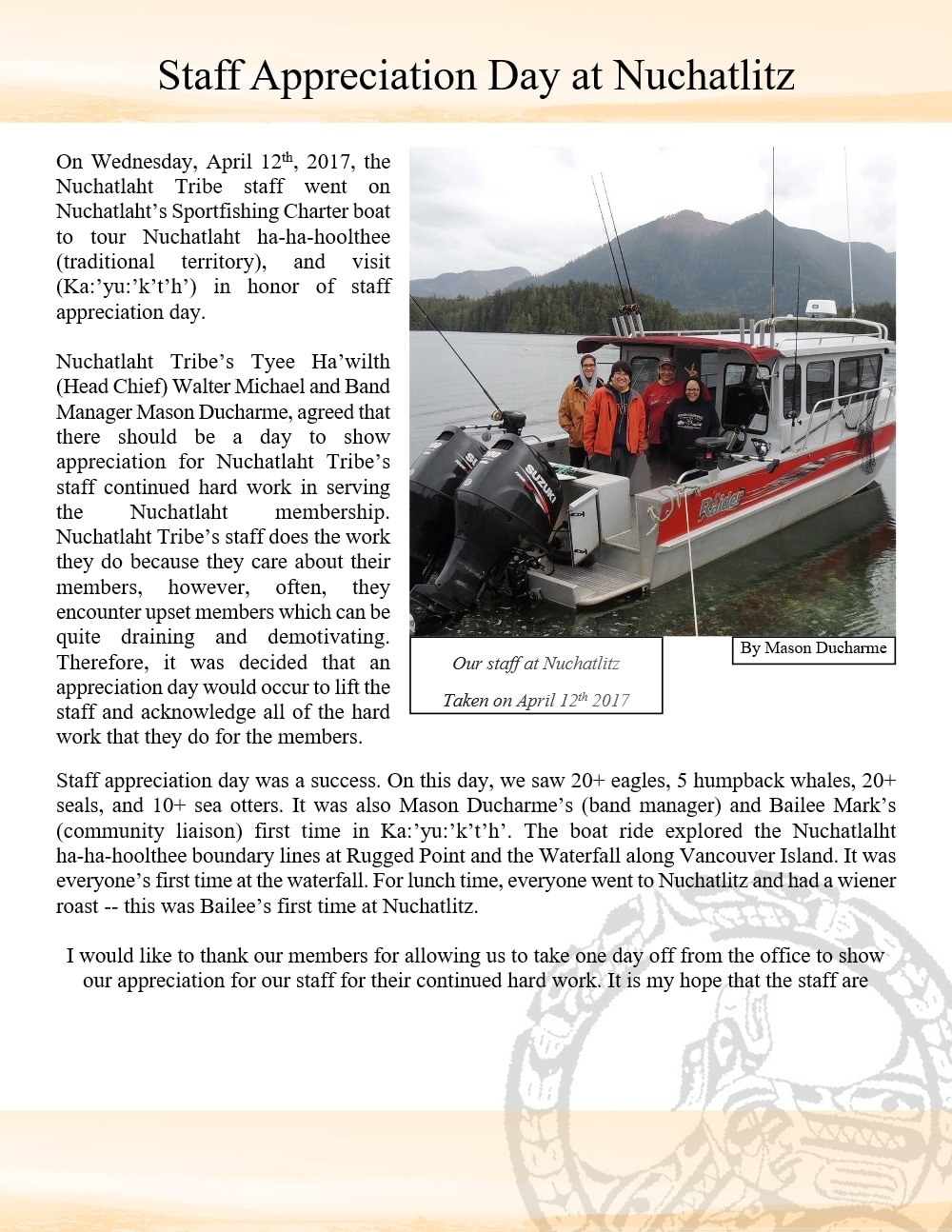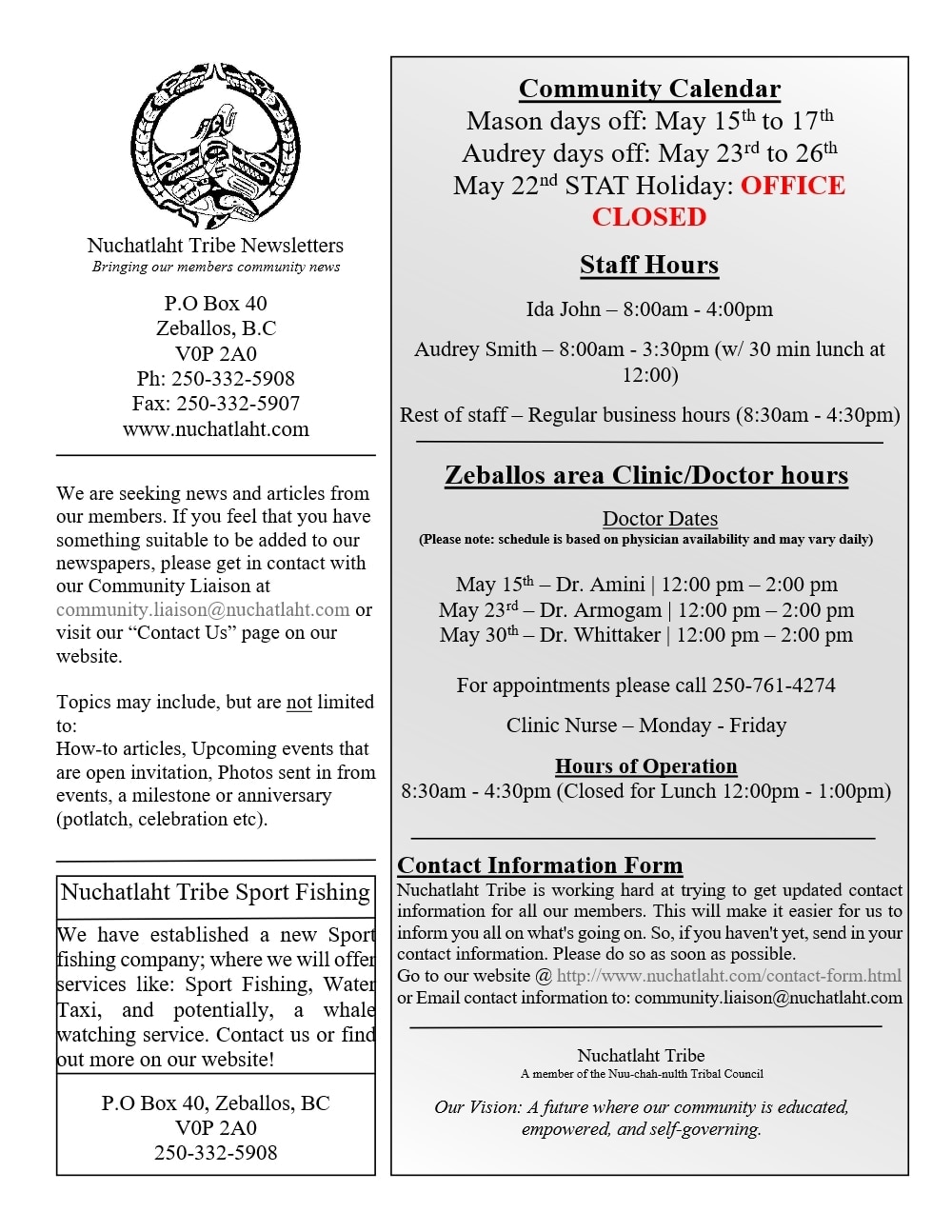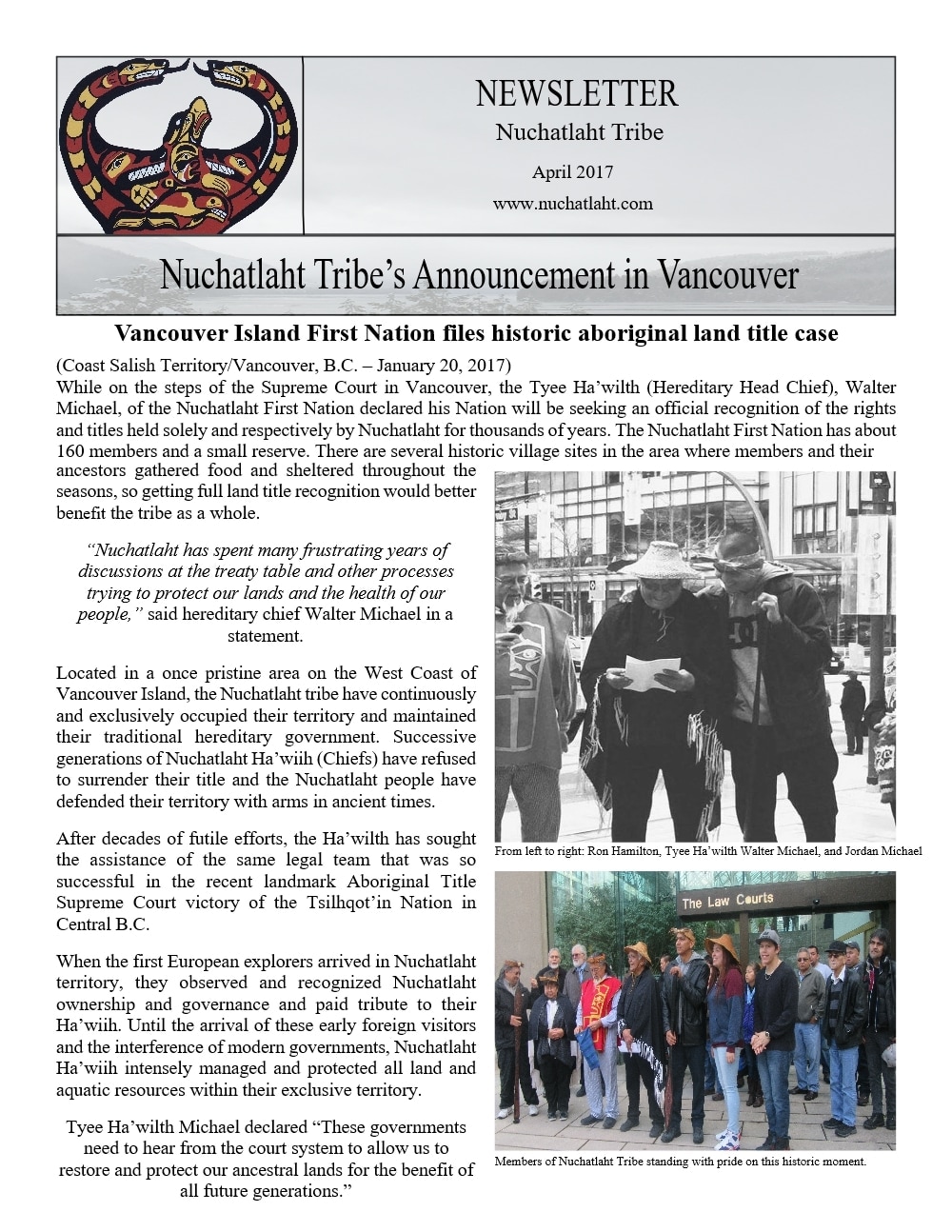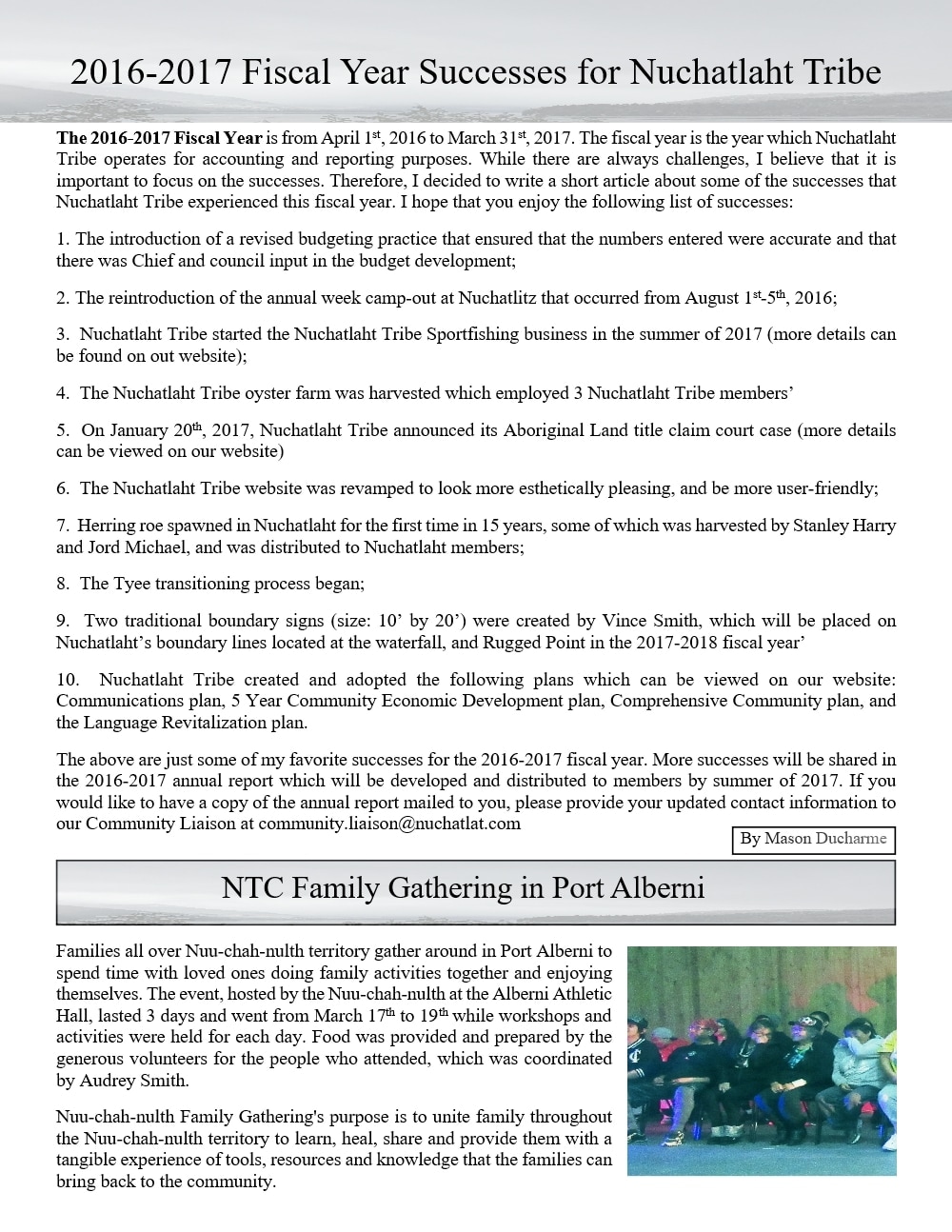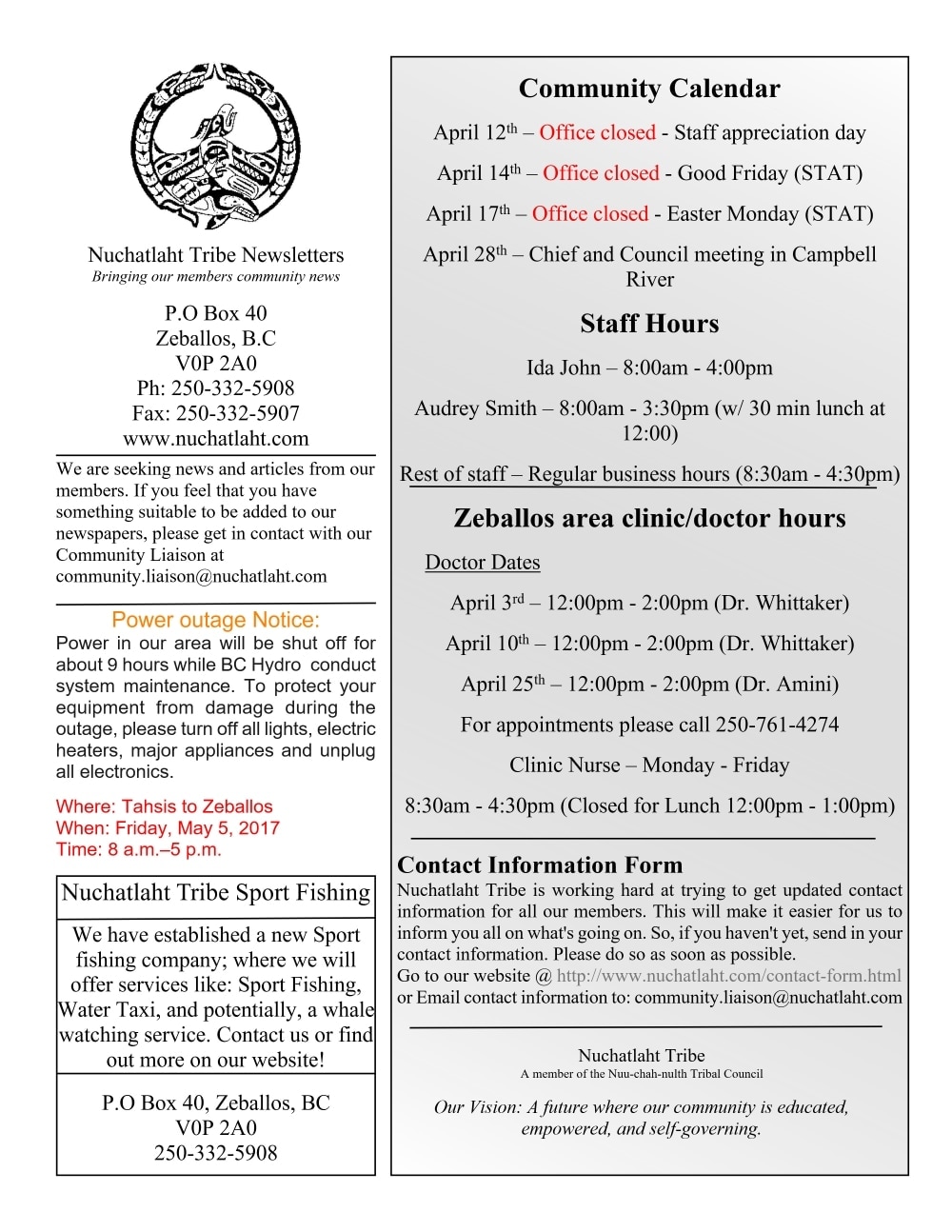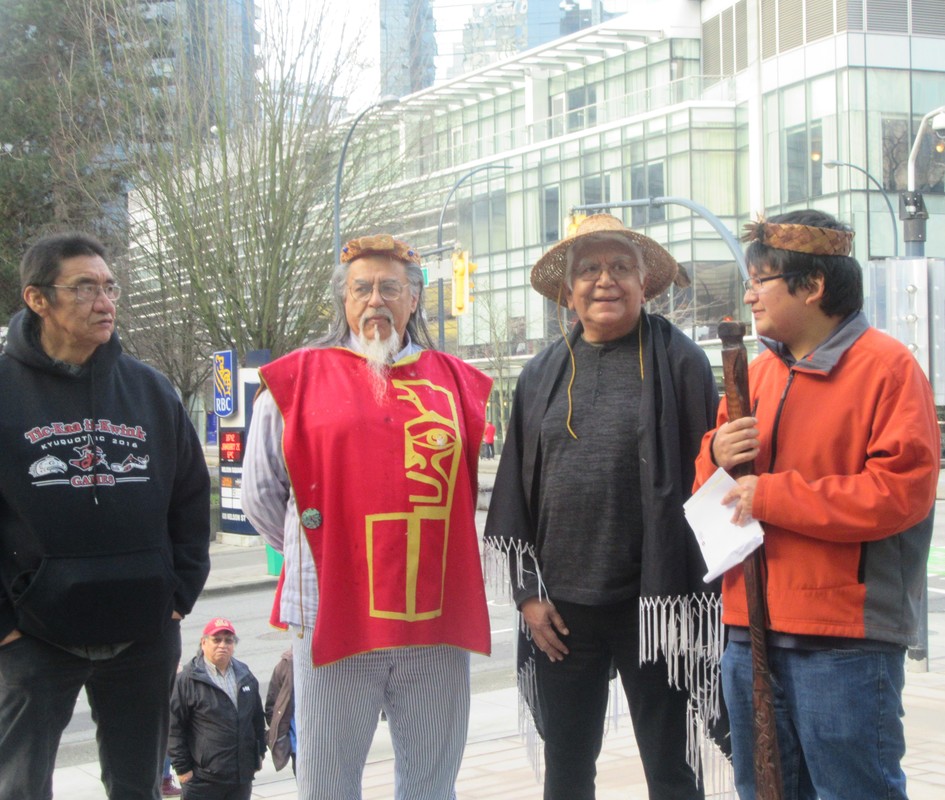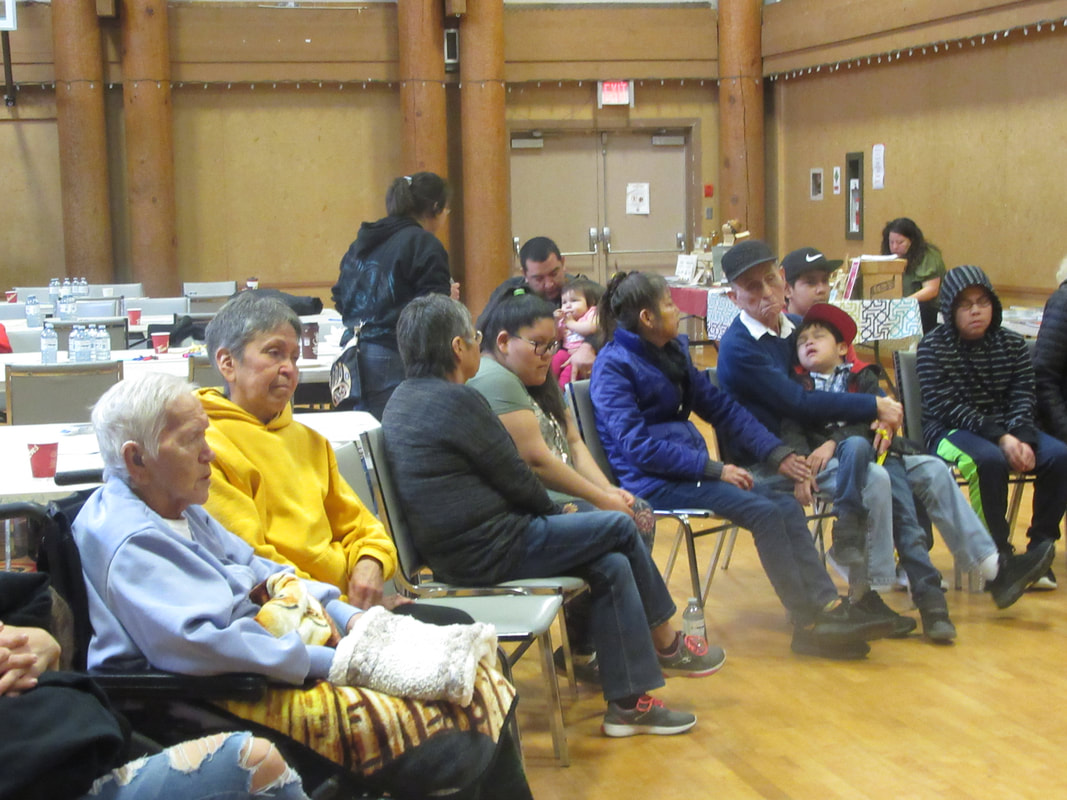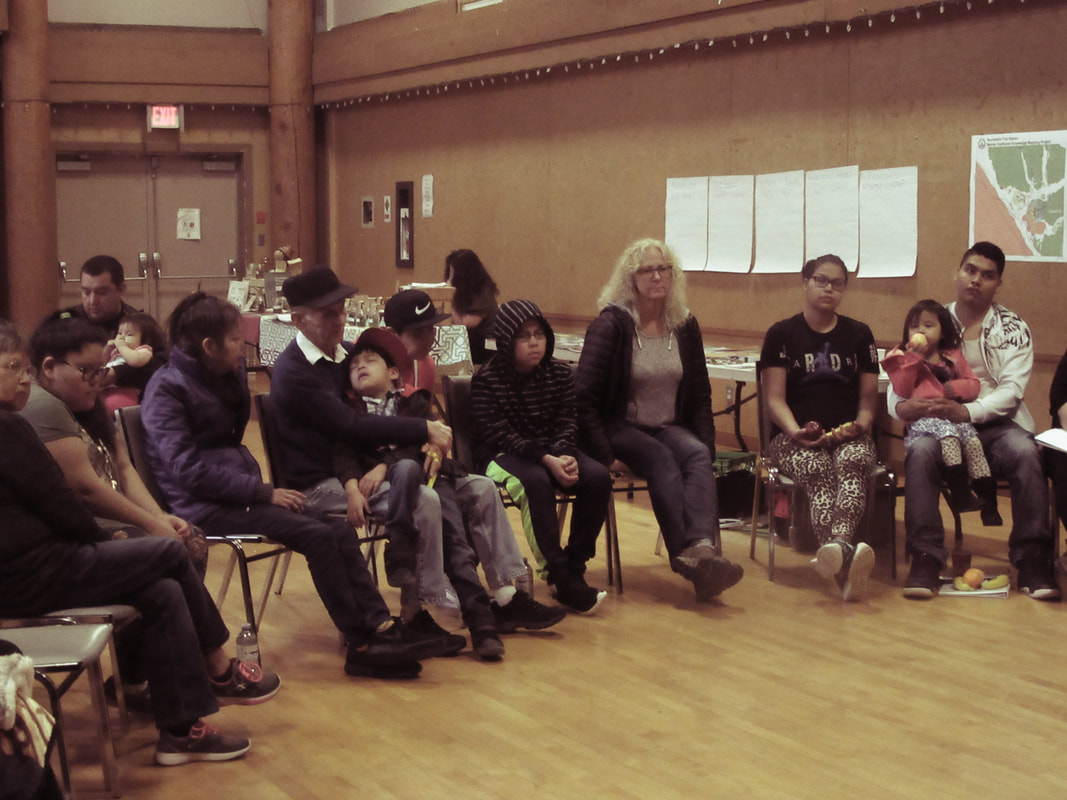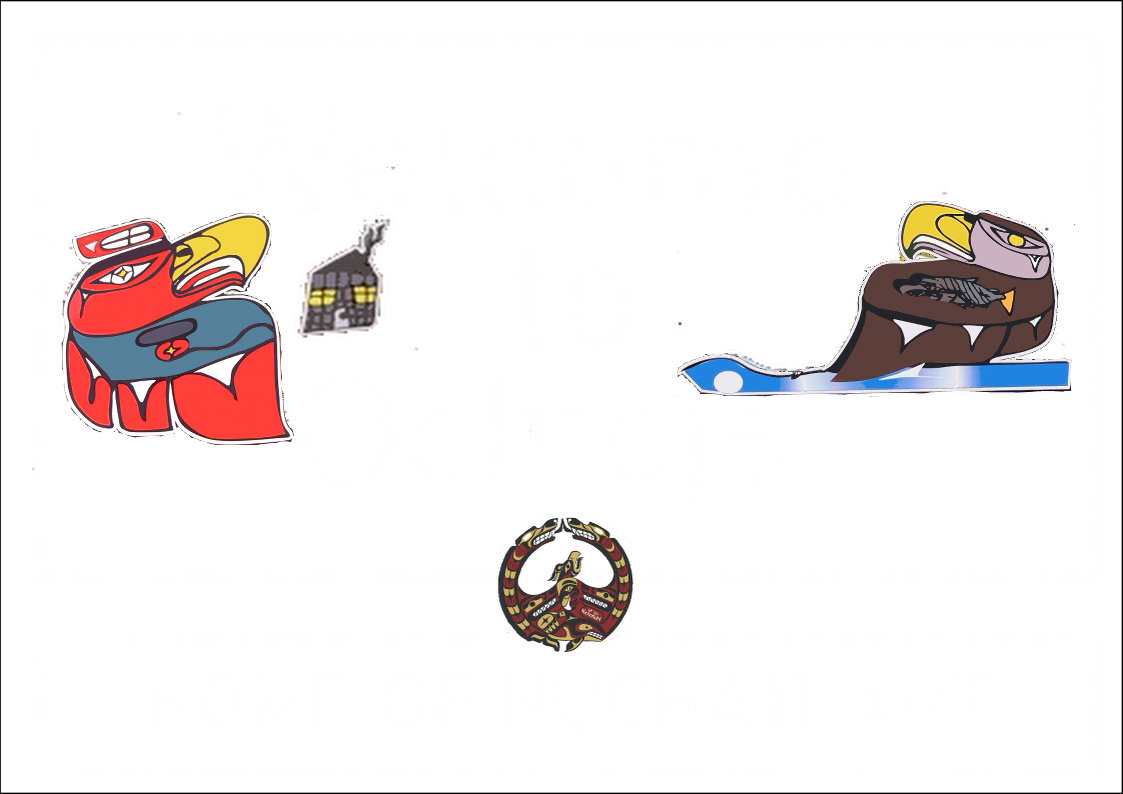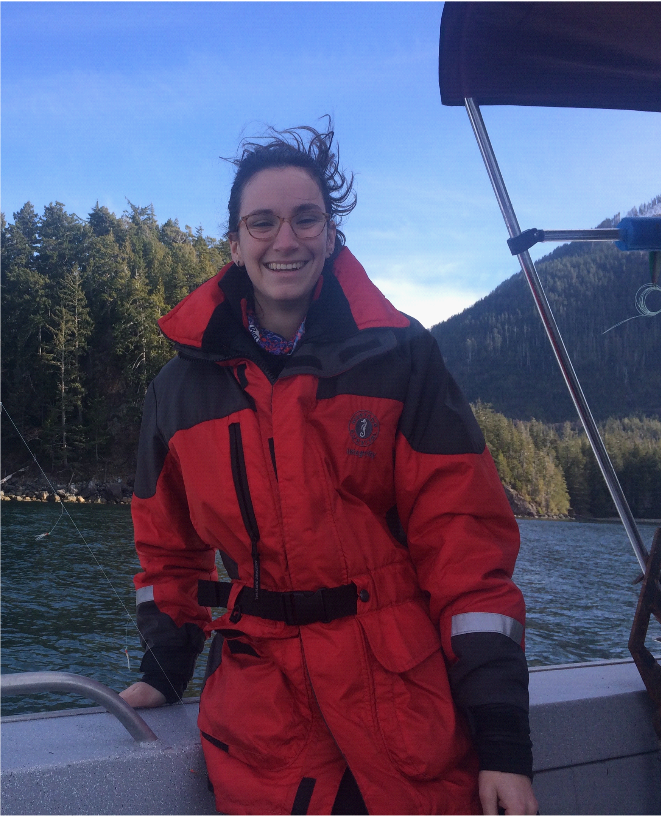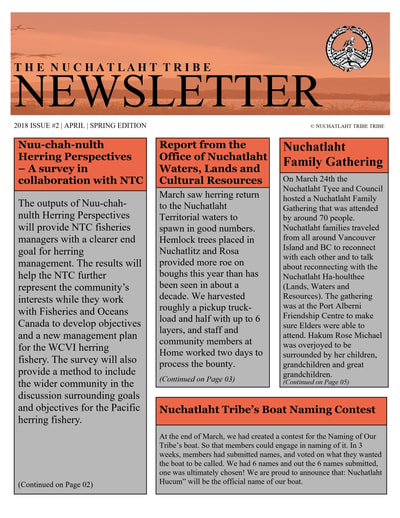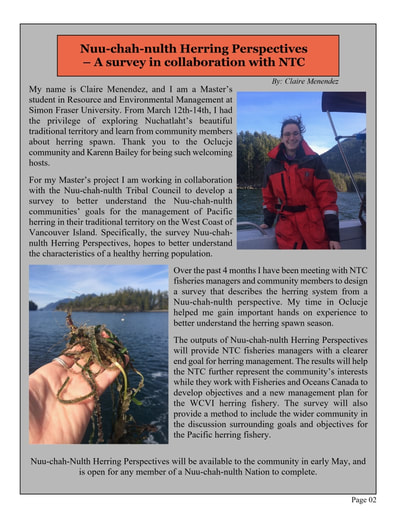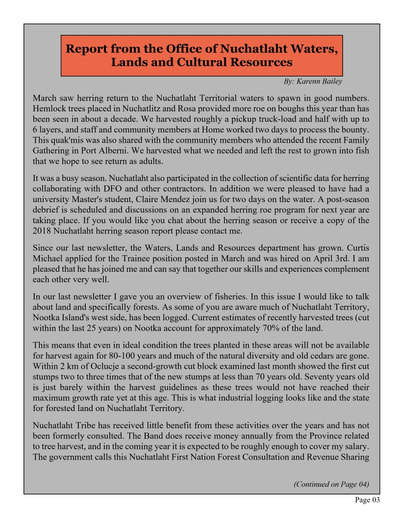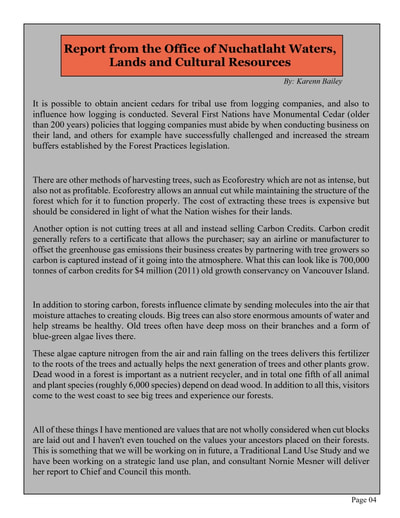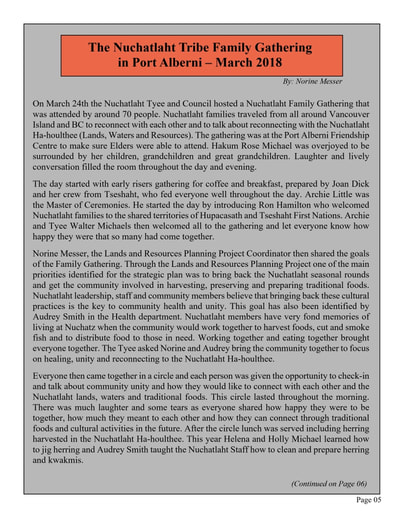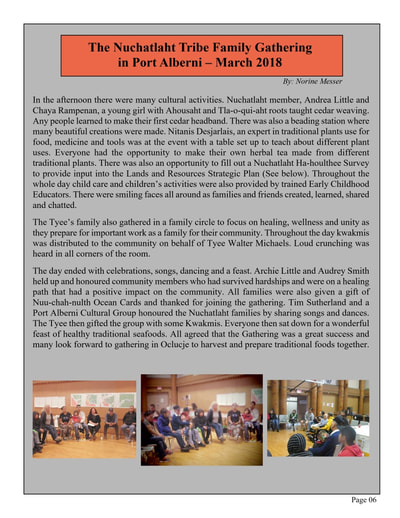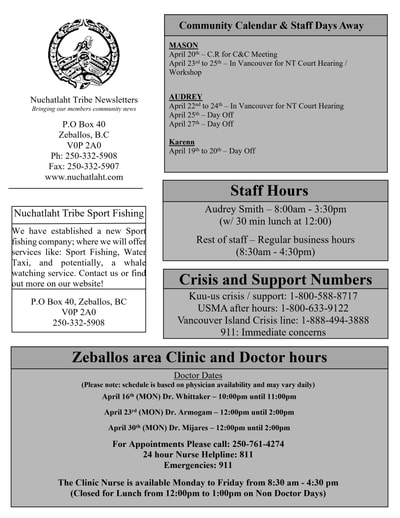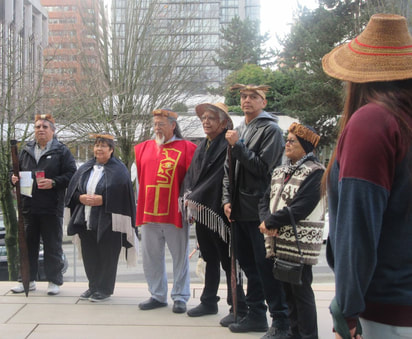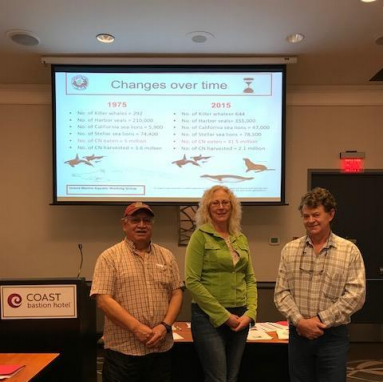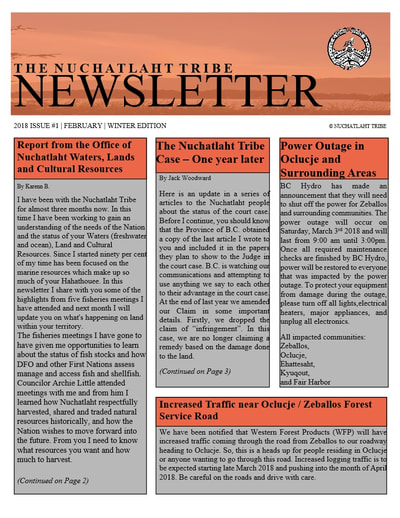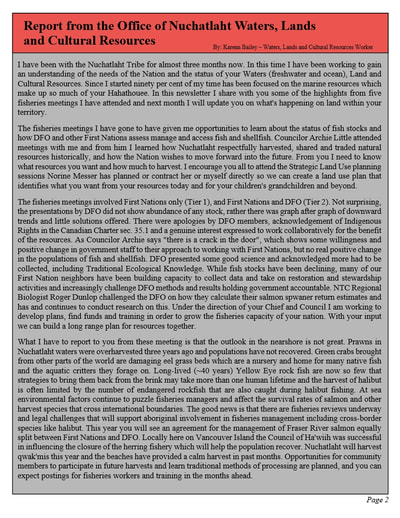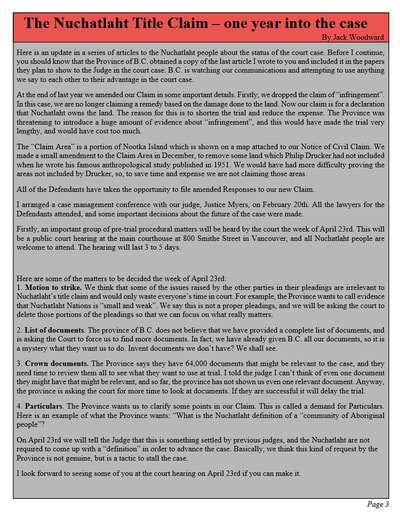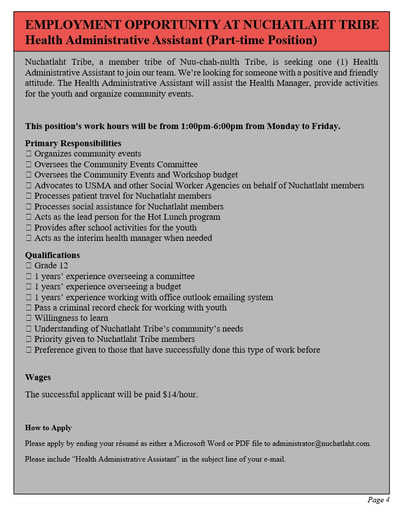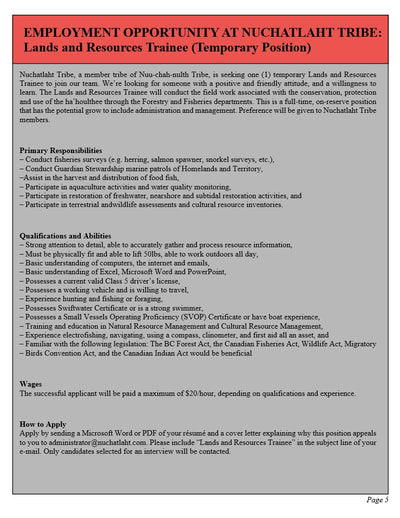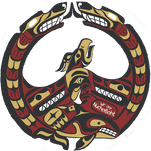2024
Nuchatlaht Summer Campout
The annual Nuchatlaht Summer Campout was held in our home territory of Nuchatlitz from June 28th to July 1st. Members from all over Vancouver Island made the trip to Oclucje to band together for a weekend of bonding, eating, playing, and exploring our beautiful territory.
Although it was a rainy weekend, approximately 60 people were able to arrive for this years campout.
Although it was a rainy weekend, approximately 60 people were able to arrive for this years campout.
Photo Credit: Genevieve Cruz
WE ARE STILL HERE.
NUCHATLAHT FIRST NATION
WINS HISTORIC BC TITLE CLAIM
For the first time in B.C. history, a B.C. Supreme Court has awarded Aboriginal title to a First Nation in B.C.
In a precedentsetting decision, Nuchatlaht’s win hasthe court recognizing Aboriginal title to part of their traditional territory on Northwest Nootka Island.
In a precedentsetting decision, Nuchatlaht’s win hasthe court recognizing Aboriginal title to part of their traditional territory on Northwest Nootka Island.
NUCHATLAHT FIRST NATION WINS HISTORIC BC TITLE CLAIM
NUCHATLAHT First Nation is celebrating a historic legal victory, after Justice Myers of the B.C. Supreme Court found that the Nuchatlaht hold aboriginal title to a portion of their traditional, ancestral, unceded territory on Nootka Island. This ruling marks the first time that a B.C. trial court has recognized a First Nation’s Aboriginal title.
The Tsilhqot’in First Nation needed to appeal their decision to the Supreme Court of Canada in Ottawa. Tyee Ha’wiih Chief Jordan Michaelsaid upon receiving the decision “we are celebrating this victory and looking ahead for the future of our nation. There is still much that needs to be done to restore our land and heal our people.”
This victory follows a 54-day trial which began in March of 2022. In May of 2023 the court rejected the Nuchatlaht’s entire claim area but acknowledged that Nuchatlaht have Aboriginal title somewhere on Nootka Island. This decision identifies those areas and concludes a process started when the Nuchatlaht first brought the claim in 2017.
“This is a victory for Nuchatlaht, but we know that our territory didn’t stop at the bottom of the hill. Our people used everything from the beaches to the mountain tops.” said Nuchatlaht Councillor Mellissa Jack. Nuchatlaht are considering appealing the decision for the remainder of their original claim area. Archie Little, Nuchatlaht elder and Councillor said “we're not just fighting for Nuchatlaht. We want to show the world that we can manage better, we can enhance better, and there will be enough for everybody.”
Future Plans
The case was first started under the leadership of the late Ha’wiih Chief Walter Michael, who said of the case "successive governments have failed to give Nuchatlaht serious iisaak (respect) for their Rights and Title... These governments need to hear from the court system to allow us to restore and protect our ancestral lands for the benefit of all future generations.”
Ha’wiih Chief Jordan Michael spoke about the continuity of this vision. “There has been industrial clearcut logging. There’s no thought about tomorrow. It’s take everything now. We want to do things differently.”
With the reclamation of part of their territory, the Nuchatlaht plan to practice Nuu-chah-nulth stewardship based on the principle of Hishuk-ish tsa’walk (everything is connected). With over 80% of old growth forests clearcut in the region and no watersheds left intact, the aim is to rehabilitate the natural ecosystem while supporting the growth of the Nuchatlaht people and culture.
In addition to forestry, the Nuchatlaht have big plans to collaborate with stakeholders to restore and strengthen wild salmon populations in the area. “We are ocean people,” said Councillor Little. “A priority is restoring wild salmon habitat in our waters.”
Housing is another priority for the Nuchatlaht, and they are developing plans to improve access to housing for members on and off reserve.
“It’ll be a great thing for our small community being able to provide for our community members,” said Melissa Jack, a Nuchatlaht Councilor.
“Now it’ll be our turn and it will be good to see our people flourish.” “This is a real chance at becoming self-sustaining. For far too long we’ve been isolated on this tiny little reserve watching all our resources getting stripped away, while not taking any real part in the economic development of our nation” said Councillor Erick Michael. ”I think it’ll be a huge win for self-determination. We will finally be able to take care of our people and take care of our lands like we want to. It will be really big for generations to come.
The Tsilhqot’in First Nation needed to appeal their decision to the Supreme Court of Canada in Ottawa. Tyee Ha’wiih Chief Jordan Michaelsaid upon receiving the decision “we are celebrating this victory and looking ahead for the future of our nation. There is still much that needs to be done to restore our land and heal our people.”
This victory follows a 54-day trial which began in March of 2022. In May of 2023 the court rejected the Nuchatlaht’s entire claim area but acknowledged that Nuchatlaht have Aboriginal title somewhere on Nootka Island. This decision identifies those areas and concludes a process started when the Nuchatlaht first brought the claim in 2017.
“This is a victory for Nuchatlaht, but we know that our territory didn’t stop at the bottom of the hill. Our people used everything from the beaches to the mountain tops.” said Nuchatlaht Councillor Mellissa Jack. Nuchatlaht are considering appealing the decision for the remainder of their original claim area. Archie Little, Nuchatlaht elder and Councillor said “we're not just fighting for Nuchatlaht. We want to show the world that we can manage better, we can enhance better, and there will be enough for everybody.”
Future Plans
The case was first started under the leadership of the late Ha’wiih Chief Walter Michael, who said of the case "successive governments have failed to give Nuchatlaht serious iisaak (respect) for their Rights and Title... These governments need to hear from the court system to allow us to restore and protect our ancestral lands for the benefit of all future generations.”
Ha’wiih Chief Jordan Michael spoke about the continuity of this vision. “There has been industrial clearcut logging. There’s no thought about tomorrow. It’s take everything now. We want to do things differently.”
With the reclamation of part of their territory, the Nuchatlaht plan to practice Nuu-chah-nulth stewardship based on the principle of Hishuk-ish tsa’walk (everything is connected). With over 80% of old growth forests clearcut in the region and no watersheds left intact, the aim is to rehabilitate the natural ecosystem while supporting the growth of the Nuchatlaht people and culture.
In addition to forestry, the Nuchatlaht have big plans to collaborate with stakeholders to restore and strengthen wild salmon populations in the area. “We are ocean people,” said Councillor Little. “A priority is restoring wild salmon habitat in our waters.”
Housing is another priority for the Nuchatlaht, and they are developing plans to improve access to housing for members on and off reserve.
“It’ll be a great thing for our small community being able to provide for our community members,” said Melissa Jack, a Nuchatlaht Councilor.
“Now it’ll be our turn and it will be good to see our people flourish.” “This is a real chance at becoming self-sustaining. For far too long we’ve been isolated on this tiny little reserve watching all our resources getting stripped away, while not taking any real part in the economic development of our nation” said Councillor Erick Michael. ”I think it’ll be a huge win for self-determination. We will finally be able to take care of our people and take care of our lands like we want to. It will be really big for generations to come.
NEW NUCHATLAHT TRIBE OFFICE LOCATION
The Nuchatlaht Tribe opened a new office in Campbell River in February 2024.
Located at 1741 16th Ave, Campbell River, BC.
Located at 1741 16th Ave, Campbell River, BC.
2023
NORTHERN REGION GAMES
In 2023, the Nuchatlaht First Nation hosted the Northern Region Games in Zeballos, BC.
Various games were held at the local sports field, with more sports being played at the Zeballos Elementary Secondary School. Participants from Northern Vancouver Island tribes gathered around to engage in sporting activities from June 30th to July 2nd, 2023.
With the help of volunteers from other nations and organizations, the 2023 NRG was a success!
Various games were held at the local sports field, with more sports being played at the Zeballos Elementary Secondary School. Participants from Northern Vancouver Island tribes gathered around to engage in sporting activities from June 30th to July 2nd, 2023.
With the help of volunteers from other nations and organizations, the 2023 NRG was a success!
ANNUAL CHRISTMAS DINNER
Our annual Christmas Dinner was held in Campbell River at the Willow Point Lions Club.
2022
Our Land Back Court Case Rally
September 27th, 2022 in Vancouver, B.C.
An Update on Nuchatlaht’s Land Title Claim
In the last few months, Nuchatlaht’s legal team led by Jack Woodward KC and Owen Stewart have gathered and presented evidence before the provincial court. Evidence consisted of compelling research from Archaeologist Jacob Earnshaw and Anthropologist John Dewhirst. The evidence presented consisted of extensive studies on culturally modified trees dating back to the 16th century, with two sites in the Northwest Nootka Island having thousands of CMTs, two of the largest known sites in all of Canada. As part of the evidence presented, there were official archival government records, fur trade journals, and academic texts all showing Nuchatlaht’s long standing presence in and connection to their land.
Meanwhile, the Province is arguing that the Nuchatlaht 1) have no connection to their land 2) were too small to control their territory and 3) should pay for the Province’s legal fees. There is little to support any of these arguments, and evidence presented by Jack Woodward KC instead shows the opposite.
Evidence presented clearly shows what everyone already knows; that the Nuchatlaht today are the descendants of the same Nuchatlaht met by explorers in the 18th and 19th centuries. Given the project of reconciliation it is deeply disappointing that the Province is claiming legal fees against the Nuchatlaht, and in response to the claim that Nuchatlaht were too small, evidence was led showing that Nuchatlaht had amassed an arsenal of over 200 guns by the early 1800s. Small but mighty!
BETRAYED BY B.C HYPOCRISYOn April 21st 2022, the Province announced a provincial action plan to implement the Declaration on the Rights of Indigenous Peoples Act (DRIPA), which consisted of litigation directives that would minimize the adversarial approach that has disadvantaged Indigenous people in court proceedings. Despite this, the Province continues to pursue arguments that contradict the directive.
“Premier Horgan is giving B.C. credit for the transformative change that UNDRIP will bring, yet they have led us further away from reconciliation, and lack any signs of good faith. Apparently, they need 5 more years to talk about implementation,” said Nuchatlaht Tyee Ha’wilth Jordan Michael. “There has been no show of good faith. The hypocrisy of the provincial government is very apparent, and needs to be addressed.”
The arguments presented by the Province include claiming that the Nuchatlaht are too small, that they have no connections to their territory, that they barely used land resources and that the Nuchatlaht should cover the Province’s legal fees.
TIMELINE & NEXT STEPSBetween March 21, 2022 to May 26, 2022 there were 40 days of trial wherein Nuchatlaht and the Province presented their arguments to court. Since May 26, both parties have writing and researching their extensive final arguments. Once presented to the Court, Nuchatlaht’s legal team are hoping for a decision early in the New Year.
Meanwhile, the Province is arguing that the Nuchatlaht 1) have no connection to their land 2) were too small to control their territory and 3) should pay for the Province’s legal fees. There is little to support any of these arguments, and evidence presented by Jack Woodward KC instead shows the opposite.
Evidence presented clearly shows what everyone already knows; that the Nuchatlaht today are the descendants of the same Nuchatlaht met by explorers in the 18th and 19th centuries. Given the project of reconciliation it is deeply disappointing that the Province is claiming legal fees against the Nuchatlaht, and in response to the claim that Nuchatlaht were too small, evidence was led showing that Nuchatlaht had amassed an arsenal of over 200 guns by the early 1800s. Small but mighty!
BETRAYED BY B.C HYPOCRISYOn April 21st 2022, the Province announced a provincial action plan to implement the Declaration on the Rights of Indigenous Peoples Act (DRIPA), which consisted of litigation directives that would minimize the adversarial approach that has disadvantaged Indigenous people in court proceedings. Despite this, the Province continues to pursue arguments that contradict the directive.
“Premier Horgan is giving B.C. credit for the transformative change that UNDRIP will bring, yet they have led us further away from reconciliation, and lack any signs of good faith. Apparently, they need 5 more years to talk about implementation,” said Nuchatlaht Tyee Ha’wilth Jordan Michael. “There has been no show of good faith. The hypocrisy of the provincial government is very apparent, and needs to be addressed.”
The arguments presented by the Province include claiming that the Nuchatlaht are too small, that they have no connections to their territory, that they barely used land resources and that the Nuchatlaht should cover the Province’s legal fees.
TIMELINE & NEXT STEPSBetween March 21, 2022 to May 26, 2022 there were 40 days of trial wherein Nuchatlaht and the Province presented their arguments to court. Since May 26, both parties have writing and researching their extensive final arguments. Once presented to the Court, Nuchatlaht’s legal team are hoping for a decision early in the New Year.
L A N D B A C K
A MESSAGE ABOUT THE LAND TITLE COURT CASE
(Coast Salish Territory/Vancouver, B.C. – January 20, 2017)
This morning, on the steps of the B.C. Supreme Court in Vancouver, the Tyee Ha’wilth (Hereditary Head Chief), Walter Michael of the Nuchatlaht First Nation declared his Nation will be seeking an official recognition of the rights and titles held solely by Nuchatlaht for thousands of years.
Tyee Ha’wilth Michael stated “Nuchatlaht has spent many frustrating years of discussions at the Treaty table and other processes trying to protect our lands and the health of our people. Successive governments have failed to give Nuchatlaht serious iisaak (respect) for their Rights and Title.”
Located in a once pristine area on the West Coast of Vancouver Island, the Nuchatlaht tribe have continuously and exclusively occupied their territory and maintained their traditional hereditary government. Successive generations of Nuchatlaht Ha’wiih (Chiefs) have refused to surrender their title and the Nuchatlaht muschim (People) have defended their territory with arms in ancient times.
When the first European explorers arrived in Nuchatlaht territory, they observed and recognized Nuchatlaht ownership and governance and paid tribute to their Ha’wiih. Until the arrival of these early foreign visitors and the interference of modern governments, Nuchatlaht Ha’wiih intensely managed and protected all land and aquatic resources within their Hahoulthi (Chief’s exclusive territory).
This continuous, sustainable management cycle protected the land and resources and sustained the Nuchatlaht people. This system was interrupted when wasteful industrial systems were implemented by B.C. and Canada during the last 150 years. These actions have enriched corporations , but adversely impacted Nuchatlaht sacred land and food sources while leaving few benefits for the Nuchatlaht people.
After decades of futile efforts, the Ha’wilth of Nuchatlaht has sought the assistance of the same legal team that was so successful in the recent landmark Aboriginal Title Supreme Court victory of the Tsilhqot’in Nation in Central B.C.
Tyee Ha’wilth Michael declared “These governments need to hear from the court system to allow us to restore and protect our ancestral lands for the benefit of all future generations.”
This morning, on the steps of the B.C. Supreme Court in Vancouver, the Tyee Ha’wilth (Hereditary Head Chief), Walter Michael of the Nuchatlaht First Nation declared his Nation will be seeking an official recognition of the rights and titles held solely by Nuchatlaht for thousands of years.
Tyee Ha’wilth Michael stated “Nuchatlaht has spent many frustrating years of discussions at the Treaty table and other processes trying to protect our lands and the health of our people. Successive governments have failed to give Nuchatlaht serious iisaak (respect) for their Rights and Title.”
Located in a once pristine area on the West Coast of Vancouver Island, the Nuchatlaht tribe have continuously and exclusively occupied their territory and maintained their traditional hereditary government. Successive generations of Nuchatlaht Ha’wiih (Chiefs) have refused to surrender their title and the Nuchatlaht muschim (People) have defended their territory with arms in ancient times.
When the first European explorers arrived in Nuchatlaht territory, they observed and recognized Nuchatlaht ownership and governance and paid tribute to their Ha’wiih. Until the arrival of these early foreign visitors and the interference of modern governments, Nuchatlaht Ha’wiih intensely managed and protected all land and aquatic resources within their Hahoulthi (Chief’s exclusive territory).
This continuous, sustainable management cycle protected the land and resources and sustained the Nuchatlaht people. This system was interrupted when wasteful industrial systems were implemented by B.C. and Canada during the last 150 years. These actions have enriched corporations , but adversely impacted Nuchatlaht sacred land and food sources while leaving few benefits for the Nuchatlaht people.
After decades of futile efforts, the Ha’wilth of Nuchatlaht has sought the assistance of the same legal team that was so successful in the recent landmark Aboriginal Title Supreme Court victory of the Tsilhqot’in Nation in Central B.C.
Tyee Ha’wilth Michael declared “These governments need to hear from the court system to allow us to restore and protect our ancestral lands for the benefit of all future generations.”
2021
As an Indigenous leader, I Didn't Feel Heard at COP26
READ MORE
This column is written by Jordan Michael, Tyee Ha'wiilth (Chief) of the Nuchatlaht First Nation.
Written in December of 2021
This fall, over 200 years since the first Europeans visited Nuchatlaht territory, I travelled to Glasgow, Scotland to attend COP26, the eminent climate change conference in the world. What I saw there was disappointing. You probably haven't heard of the Nuchatlaht. We are a small nation from the West Coast of Vancouver Island. We have lived and thrived on these lands for thousands of years.
We were here when British captain James Cook sailed into Nootka Sound in 1778. We were here when George Vancouver met the Spanish captain Bodega y Quadra in 1792. The two European powers were fighting over ownership of our land. They obviously didn't include us in the conversation. Our people are still on Nootka Island today and we're having that conversation now, in B.C. Supreme Court, where we're fighting to regain part of what was taken from us. Nootka Island is a land of big trees and big fish, but it has become a land of clear cuts.
This past summer I watched our drought-stricken cedar go thirsty and our salmon cook in the rivers as an unprecedented heat dome saw record-high
temperatures. These are the things that sustained our nation. Without cedar and salmon, Nuchatlaht culture is at risk. It is obvious that things are not
right. I went to COP26 to talk about salmon parks. Salmon parks are watershed-based parks that protect more than the narrow strips of forest along freshwater streams. They protect the habitats that sustain young salmon, including the watersheds and forests above them. They are based on the Nuu-chah-nulth principle of hishuk ish tsawalk, meaning "everything is interconnected." Salmon parks recognize that from the tops of mountains to the bottoms of valleys, salmon health, river health and forest health are related.
Salmon parks are not currently widespread, but can be a key Indigenous-led tool to fight climate change by protecting one of the richest carbon sinks in the country: coastal B.C. rainforest. By keeping these forests stable and free from disturbance, we are protecting the climate and creating resilient ecosystems.
The great cedars that built this province also pull carbon out of our atmosphere. The Nuchatlaht want them to keep doing that instead of being cut down. Our nation has proposed two watersheds in Nuchatlaht territory be turned into salmon parks. British Columbia, which is fighting us in court, will not let us govern our lands and create these parks. We need more than lip service. COP26 was an opportunity for governments to recognize Indigenous solutions, like salmon parks. A chance to come up with an ambitious and inclusive plan to tackle climate change.
Instead, the conference felt like a trade show, full of government and industry patting themselves on the back for weak solutions.
Getting into COP26 was its own challenge. The flights and lodging are expensive. If you want to rub elbows with government delegates, you need an official UN badge to access the "Blue Zone," where speechmakers and representatives from organizations could mingle. These badges are hard to come by, requiring a lengthy accreditation process. I saw few other Indigenous folks with them. Even with a badge, with so many voices crowding out those with fewer resources, it was a challenge to be a part of meaningful conversations. Just like 200 years ago, Indigenous voices are excluded from the conversation.
There were moments when COP26 was loud, but it never felt like Indigenous voices were heard. At least not within the Blue Zone. Outside the Blue Zone was more inclusive, more Indigenous and more in tune to the challenges we face. I met with Indigenous peoples from around the country and world to share our struggles, hardships and solutions. Our stories are remarkably similar. Thousands of people marched in Glasgow for climate change. This felt like action.
We Nuchatlaht managed our lands sustainably for thousands of years. Our stewardship and knowledge is essential for the land to be sustained for thousands more. There is a lot that we can do, if the government will help us do it, so let us help. Indigenous people need to have a meaningful presence at the policy table if Canada is to meet its climate targets. We need more than lip service. Reconciliation demands it. After COP26, I returned home to more extreme weather, broken highways and flooded neighbourhoods from the devastating storms that hit B.C. in November. After a disappointing conference, it was a harsh reminder of the risks we face. But I'm not coming home empty handed. With my resolve intact, I'm back home pushing for salmon parks, and for reconciliation.
Written in December of 2021
This fall, over 200 years since the first Europeans visited Nuchatlaht territory, I travelled to Glasgow, Scotland to attend COP26, the eminent climate change conference in the world. What I saw there was disappointing. You probably haven't heard of the Nuchatlaht. We are a small nation from the West Coast of Vancouver Island. We have lived and thrived on these lands for thousands of years.
We were here when British captain James Cook sailed into Nootka Sound in 1778. We were here when George Vancouver met the Spanish captain Bodega y Quadra in 1792. The two European powers were fighting over ownership of our land. They obviously didn't include us in the conversation. Our people are still on Nootka Island today and we're having that conversation now, in B.C. Supreme Court, where we're fighting to regain part of what was taken from us. Nootka Island is a land of big trees and big fish, but it has become a land of clear cuts.
This past summer I watched our drought-stricken cedar go thirsty and our salmon cook in the rivers as an unprecedented heat dome saw record-high
temperatures. These are the things that sustained our nation. Without cedar and salmon, Nuchatlaht culture is at risk. It is obvious that things are not
right. I went to COP26 to talk about salmon parks. Salmon parks are watershed-based parks that protect more than the narrow strips of forest along freshwater streams. They protect the habitats that sustain young salmon, including the watersheds and forests above them. They are based on the Nuu-chah-nulth principle of hishuk ish tsawalk, meaning "everything is interconnected." Salmon parks recognize that from the tops of mountains to the bottoms of valleys, salmon health, river health and forest health are related.
Salmon parks are not currently widespread, but can be a key Indigenous-led tool to fight climate change by protecting one of the richest carbon sinks in the country: coastal B.C. rainforest. By keeping these forests stable and free from disturbance, we are protecting the climate and creating resilient ecosystems.
The great cedars that built this province also pull carbon out of our atmosphere. The Nuchatlaht want them to keep doing that instead of being cut down. Our nation has proposed two watersheds in Nuchatlaht territory be turned into salmon parks. British Columbia, which is fighting us in court, will not let us govern our lands and create these parks. We need more than lip service. COP26 was an opportunity for governments to recognize Indigenous solutions, like salmon parks. A chance to come up with an ambitious and inclusive plan to tackle climate change.
Instead, the conference felt like a trade show, full of government and industry patting themselves on the back for weak solutions.
Getting into COP26 was its own challenge. The flights and lodging are expensive. If you want to rub elbows with government delegates, you need an official UN badge to access the "Blue Zone," where speechmakers and representatives from organizations could mingle. These badges are hard to come by, requiring a lengthy accreditation process. I saw few other Indigenous folks with them. Even with a badge, with so many voices crowding out those with fewer resources, it was a challenge to be a part of meaningful conversations. Just like 200 years ago, Indigenous voices are excluded from the conversation.
There were moments when COP26 was loud, but it never felt like Indigenous voices were heard. At least not within the Blue Zone. Outside the Blue Zone was more inclusive, more Indigenous and more in tune to the challenges we face. I met with Indigenous peoples from around the country and world to share our struggles, hardships and solutions. Our stories are remarkably similar. Thousands of people marched in Glasgow for climate change. This felt like action.
We Nuchatlaht managed our lands sustainably for thousands of years. Our stewardship and knowledge is essential for the land to be sustained for thousands more. There is a lot that we can do, if the government will help us do it, so let us help. Indigenous people need to have a meaningful presence at the policy table if Canada is to meet its climate targets. We need more than lip service. Reconciliation demands it. After COP26, I returned home to more extreme weather, broken highways and flooded neighbourhoods from the devastating storms that hit B.C. in November. After a disappointing conference, it was a harsh reminder of the risks we face. But I'm not coming home empty handed. With my resolve intact, I'm back home pushing for salmon parks, and for reconciliation.
2021 FAMILY CAMP OUTINGS FOR THE MICHAEL & SMITH FAMILY
READ MORE
In the summer of 2021, our annual family gathering occurred after missing the annual gathering the year prior. The Smith family camped out at Nuchatlitz while the Michael family were at Ferrier Point. After missing a year due to the pandemic, we were successful in planning and hosting this event for our membership. Every year we aim to get the largest families together to camp, laugh, reminisce and enjoy our beautiful territory during the summer.
During the 5 day camp out, we shared stories, cooked and shared meals together, and had long, meaningful conversations with distant relatives. On the first day of the camp out, the Michael family were so happy to see distant family and to be introduced to distant relatives and new born babies. We were fortunate enough that the weather was beautiful. There were approximately 30 family members getting together. The young children especially enjoyed their time camping. We hope to continue this tradition this year.
During the 5 day camp out, we shared stories, cooked and shared meals together, and had long, meaningful conversations with distant relatives. On the first day of the camp out, the Michael family were so happy to see distant family and to be introduced to distant relatives and new born babies. We were fortunate enough that the weather was beautiful. There were approximately 30 family members getting together. The young children especially enjoyed their time camping. We hope to continue this tradition this year.
Traditional Cultural Events in Oclucje
READ MORE
Julie John is the Cultural and Native Language Contractor. As apart of her job, she has helped organize and coordinate opportunities for Native Dancing, Native Singing, and Native Language opportunities. Native Dancing opportunities started in 2021 at the Oclucje hall with Kaila Rain, our Wellness Coordinator and Annie John. Annie facilitated some sessions of native dancing, where the topic of native music rights came up, and the rights to dance to each song. Annie shared the spiritual component of dancing, about the movement of the feet, thus opening up a world of knowledge not known to some members. Some ladies of the community took part in dancing, and the community kids attended each session.
Shelly Hamilton was added to the dance team too, and she was able to work with the young kids. One session, Shelly did a different program where she asked the kids cultural questions, and shared cultural information with them. After Native Dancing with Annie, I realized that we needed to build the Nuchatlaht music library to help the native dancers be successful. So, I started the Native Singing Learning group with community members and we contracted teachers Brian Lucas and Cory Howard.
The sessions started in November 2021, and, so far, we have had one weekend session a month at the Oclucje Hall. Apart from the singing sessions, we have been hand making traditional drums, so one weekend was dedicated to drum making where community members participating in the program got to build a drum. The goal of the Native Singing Learning group is to build up Nuchatlahts native singers so that they can fly solo one day in honor of Nuchatlaht Tribe.
The pandemic has made some programs a little hard to run, due to all the restrictions. So, native language opportunities started out virtually in the beginning. I have native language information and native language videos on a Facebook group: “Nuchatlaht Native language with Julie John”. Julie is not a fluent speaker, but as a second language learner she encourages all members to start with the language building blocks of the native alphabet, using native language out loud at home.
As part of her program, she has done some community research to see where members might be ready to get involved in native language program. As part of her research, she has attempted to run Prize Programs where member sign up, but practice with native language from the safety of their own home, no matter where they live. Some of the first prizes where pop and chips. Then next prize was $100. The last program prize was a Nuchatlaht sweater. There are also internet recordings of Nuchatlaht members, and the Nuu-chah-nulth people.
Shelly Hamilton was added to the dance team too, and she was able to work with the young kids. One session, Shelly did a different program where she asked the kids cultural questions, and shared cultural information with them. After Native Dancing with Annie, I realized that we needed to build the Nuchatlaht music library to help the native dancers be successful. So, I started the Native Singing Learning group with community members and we contracted teachers Brian Lucas and Cory Howard.
The sessions started in November 2021, and, so far, we have had one weekend session a month at the Oclucje Hall. Apart from the singing sessions, we have been hand making traditional drums, so one weekend was dedicated to drum making where community members participating in the program got to build a drum. The goal of the Native Singing Learning group is to build up Nuchatlahts native singers so that they can fly solo one day in honor of Nuchatlaht Tribe.
The pandemic has made some programs a little hard to run, due to all the restrictions. So, native language opportunities started out virtually in the beginning. I have native language information and native language videos on a Facebook group: “Nuchatlaht Native language with Julie John”. Julie is not a fluent speaker, but as a second language learner she encourages all members to start with the language building blocks of the native alphabet, using native language out loud at home.
As part of her program, she has done some community research to see where members might be ready to get involved in native language program. As part of her research, she has attempted to run Prize Programs where member sign up, but practice with native language from the safety of their own home, no matter where they live. Some of the first prizes where pop and chips. Then next prize was $100. The last program prize was a Nuchatlaht sweater. There are also internet recordings of Nuchatlaht members, and the Nuu-chah-nulth people.
NUCHATLAHT CULTTURAL ACTIVITY : JARRING FISH TUTURIAL
READ MORE
Julie John, Nuchatlaht’s Cultural and Native Language Coordinator did a tutorial on jarring fish at the Oclucje Hall in the late months of 2021. The opportunity was offered to adults, and children of the community. The fish that was caught in the summer time by our fisherman was used for jarring. Julie huddled the kids around, with Kaila and Candace, to show them how to fillet salmon, and prepare salmon for jarring.
Once the fish was all cut up, the kids helped put salt in the jars, and then helped put fish in the jars. We all got the jars sealed up, and put it in pots to seal the jars. That all sounds simple, but anyone who has done it remembers how long of a process it takes, and the kids had a wonderful time hanging out with each other while we all waited for the fish to finish on the stove.
After the fish finished, we emptied the pots, and let them cool for the night. Then next day, we all met at the hall again, opened up one or two jars and made some fish sandwich to taste our very own jarred fish. Each participant got to take a jar home, and the rest stayed at the hall for after school activities and community gatherings. At the end, we had successfully jarred 16 cans of fish.
Once the fish was all cut up, the kids helped put salt in the jars, and then helped put fish in the jars. We all got the jars sealed up, and put it in pots to seal the jars. That all sounds simple, but anyone who has done it remembers how long of a process it takes, and the kids had a wonderful time hanging out with each other while we all waited for the fish to finish on the stove.
After the fish finished, we emptied the pots, and let them cool for the night. Then next day, we all met at the hall again, opened up one or two jars and made some fish sandwich to taste our very own jarred fish. Each participant got to take a jar home, and the rest stayed at the hall for after school activities and community gatherings. At the end, we had successfully jarred 16 cans of fish.
2017 - 2018
Archives
December 2017
|
December
2017 |
Planning Meeting before Meeting with the Provincial Ministers
Historical Meeting with Provincial MinistersWelcoming a new member to the Staff: Karen Bailey, Lands and Resources workerI was born and raised in the traditional territory of the Squamish Nation. The mountains and ocean of the Sea to Sky corridor and Vancouver’s North Shore are my homelands. The wild places and natural seascapes have been a source of refuge, restoration and learning my entire life.
The wise use of our natural resources has always been of interest to me and is now a driving force in my life. I am a Steward, Educator and Administrator, and a Professional Biologist. I originally went to BCIT for business and worked 12 years in administration, accounting, human resources and marketing. I went back to BCIT in my forties because I wanted to switch careers and pursue a passion for conservation. I earned a Bachelor of Technology in Ecological Restoration (2013) and a Technical Diploma from the Fish, Wildlife and Recreation program (2010) from BCIT. Within a year of graduation I applied for and received two research grants, parlayed my academic studies into three paid work assignments and applied these projects to accreditation with the BC College of Applied Biology, a provincially legislated body. My environmental work has been diverse. I have assessment and restoration experience in wetlands, stream and riparian habitats; and estuarine reclamation and recovery of coastal sand ecosystems both BC and Hawaii. I have a curious mind, love learning and exchanging experiences and knowledge. My expertise lies in BC coastal freshwater ecosystems but has equally involved urban water issues. I am an ecosystem biologist interested in how bears, birds frogs and fish use their environment and interact with each other. I acknowledge that coastal First Nations have been a part of that ecosystem, have co-evoled with their natural environment and been stewards of natural resources for over 15, 000 years. I do not have children, something the Creator has chosen, not me. I believe that I am to nurture the land and sea and mentor and assist those who want natural landscapes that function as Mother Nature intended and water that is clean and full of life. I believe I have a great opportunity to do this in your Lands and Resources department and look forward to meeting you all and serving your community. Christmas Traditions, a brief history of “Deck the Halls” and Traditional Knowledge useMany ancient European cultures used evergreen plants and boughs in the winter months:
Many traditions involving greenery originated in Druid, Celt, Norse, and Roman civilizations, which celebrated the winter solstice around December 21. Because the color green represented eternal life, plants that remained green throughout the year played an important role in these celebrations. Ancient cultures believed bringing in green branches would ensure the return of vegetation at winter's end. They used mistletoe and holly in pagan religious rituals and to decorate their homes. Romans exchanged holly wreaths as part of their Saturnalia festivities. Saturnalia was the celebration around winter solstice (the days with the least sunlight hours, also know as the darkest day of the year, December 21). Coastal First Nations had many uses of evergreen boughs; cedar, pine, fir and hemlock. One that I was told of was the use of fir evergreen boughs inside the long houses in wintertime. The thinking was that the fresh fragrance of fir and the relatively flat arrangement of the needles on the branch made them ideal for making bedding. Each time the needles are crushed they release a lemony smell. As you can imagine with all the people living together all winter, and cooking smells, etc. was perhaps a welcome smell to have inside the longhouses. HOLIDAY OFFICE CLOSURE AND EMERGENCY CONTACTThe office will be closed on Thursday, December 21st 2017 until January 8th 2018. For emergencies, you can contact Ida John by email at [email protected]. Ida will be on call on the following dates:
December 27th December 28th January 2nd to January 5th During these on call dates, Ida will check her email throughout the day, and check the band’s voicemail once a day. Ida can assist with emergency patient travel and providing emergency funding to members. |
OCTOBER 2017
|
October
2017 |
New Names for Two RoadsNuchatlaht Tribe is currently obtaining a license of occupation so that they can replace the main bridge into Oclucje Reserve. Part of this application required Nuchatlaht Tribe to name two roads. These two roads are the road that comes into Oclucje from the Zeballos Forest Service Road, and the road that goes towards our dock.
With help from Ron Hamilton and with Tyee Ha’wilth Walter Michael’s blessings, the two roads were given the following names:
1) T'ashii-is 2) Waaykaash. According to Ron the names mean the following: 1. T'ashii-is = The Way To 2. Waaykaash = Praise T'ashii'is will be the name of the road coming in from the highway Waaykaash will be the name of the road going towards the dock Wi-Fi Can Reach Everywhere in the Band OfficeOn September 6th, 2017, Nuchatlaht’s wifi (internet) finally reached all parts of the band office. Previously, the Wi-Fi could barely reach Jordan’s and Archie's office due to the weak Wi-Fi extender the band used. This couldn’t be possible without the advancement in technology, and the help of our IT whiz, Bryan M.
Now when visitors come to the band office, they will not have any connectivity issues. This is a small but great success that Nuchatlaht Tribe is proud of. Fire Escape Plan WorkshopOn September 27th, 2017, Nuchatlaht Tribe hosted a Fire Escape Plan workshop where participants learned about the importance of Fire Escape Plans and then created one for their household. After the workshop was done, the participants requested that further workshops be delivered on a quarterly (every 3 months) basis that focuses on the following topics:
1. Different types of fires and how to extinguish them out; 2. Prevention of household fires; and 3. Fire escape drills This is important that Nuchatlaht Tribe continue to deliver these workshops as the Village of Zeballos is not legally obligated to extinguish fires for us; therefore, we need to have the tools to prevent and extinguish fires ourselves. Here is the Fire escape plan that we created so that our guests have a better understanding of where to go when a fire occurs
Shrimp Boil (recipe)
|
AUGUST 2017
|
August
2017 |
The 2017 Annual Nuchatlaht Tribe Camp-out @ Nuchatlitz
2017 41st BC Elders Gathering in Campbell River
For more than 4 decades, The First Nations Elders have gathered around to meet in distinct locations all around mainland BC and Vancouver Island.
This years 41st annual Elders Gathering was hosted in Campbell River, BC at the Strathcona Gardens Recreational Center where approximately 3,000 attendees from different nations from all over British Columbia came to visit, exchange memories and knowledge, to create new friendships and renew old ones. The annual gatherings help give an opportunity to increase point of view on how other First Nations live. Although small, Nuchatlaht Tribe walked among several neighboring tribes. We hope more of our members are available to attend Elders Gathering events in the future. |
JUNE 2017
|
June
2017 |
The Nuchatlaht Title Claim – Where Are We in the Case?
By: Jack Woodward
Last month, I wrote an article in this newsletter introducing the important Nuchatlaht title claim. This is an update on what stage the case is at, and what you can expect in the future. As of May 19th, all parties to the lawsuit have now filed their “pleadings”. Pleadings are court documents in which the parties set out their version of the facts. Canada, BC, and Western Forest Products (WFP) are the opposing parties, and none of them admitted that the Nuchatlaht historically used or occupied the claim area to the extent needed to prove Aboriginal Title. But Canada did at least admit that the present-day Nuchatlaht are the descendants of the same Aboriginal group that existed in 1846, the year that the Nuchatlaht territory was included in the country that is now called Canada. This helps. Now that the pleadings are filed, here are some of the upcoming steps in the case: 1. Motion to strike. We think that some of the issues raised by the other parties in their pleadings are irrelevant to Nuchatlaht’s title claim and would only waste everyone’s time in court. Consequently, we intend to bring a “motion to strike” – essentially, asking the court to delete those portions of the pleadings so that we can focus on what really matters. 2. List of documents. The parties need to file their lists of documents that they intend to rely on in court. Currently, this step is due to be completed by June 24th, although it is very likely that the opposing parties will ask for extensions of time. 3. Applying for court dates. We need to apply to the court to nail down the dates when this case will be heard. This involves trying to find a slot in the court’s schedule when they have time to hear us. Optimistically, we hope that might get dates as early as April to June, 2018, but this very much depends on the availability of judges and other factors outside of our control. Tiny but mighty: The Nuchatlaht Tribe is providing leadership to other First Nations in British Columbia by showing that it is possible for any band, however small, to get into court and begin asserting their legal rights. In the next newsletter I will discuss some of the important historical and scientific evidence that proves that the Nuchatlaht are the rightful owners of these beautiful lands. Regards, Jack Woodward Nuchatlaht Dialect Signs
By: Mason Ducharme
In May 2017, Nuchatlaht Tribe picked up eight (8) signs written in Nuchatlaht dialect to help reintroduce the Nuchatlaht language into the community. These signs were funded through surplus dollars from the FPCC Language Revitalization Program. The following are the words on the signs: 1. hišumyiły̓ak - community hall 2. mamuquwiłukʔi nučaaƛʔatḥ - Nuchatlaht Band 3. Officeƛ̓ayaʕasuwił - greenhouse 4. ʔumč̓aaquwił - (indoor) gym, recreational centre 5. ʔumč̓aaʕasy̓ak - playground, playing field 6. wiinapuʔi Stop! (such as on a stop sign) If you know how to correctly pronounce these Nuchatlaht words, there is an opportunity for you. Nuchatlaht Tribe is currently seeking someone who can pronounce these words, and is willing to be recorded via video on the pronunciation. The video would then be shared on our Facebook page, and other social media accounts. If you, or someone you know can do this, please email Mason Ducharme at [email protected]. An honorarium will be presented to the person upon completion of services. Nuchatlaht Tribe Staff Retreat
By: Mason Ducharme
On June 7-8, your Nuchatlaht Tribe staff will be at the Cluxewe Resort which is located in between Port McNeill and Port Hardy for an annual staff retreat. The staff will be leaving Oclucje reserve at 1:00pm on June 6th. The staff will be leaving the Cluxewe Resort on June 9th first thing in the morning. The focus of this year’s annual staff retreat will focus on communication, professional writing, conflict resolution, and self-care. It is our hope that this retreat will provide the staff with tools to do their jobs more effectively, and the tools they need to achieve a healthy work-life balance. During this time, you can contact your band manager Mason Ducharme at 250-204-5908, or email him at [email protected] , if you have any questions or concerns. This also means that any payments will not be processed until we return back to work on Monday, June 12th, 2017. I appreciate your support in allowing us to take some time out of the office to better serve you. Record Breaking 2016-2017 Audit
By Mason Ducharme
Every year, Nuchatlaht Tribe and other First Nations are required to undergo annual audits in accordance with their funding agreements. Audits for Nuchatlaht Tribe in the past took 72-96 hours to complete. For this year’s 2016-2017 audit, it was completed in less than 24 hours. The auditors arrived on Tuesday, May 23rd at 1:00 pm, and they left on Wednesday, May 24th at 12:00 pm. The reason that the audit was completed quicker than previous years is that my staff was much more organized this year. This is a huge success for Nuchatlaht Tribe, and I am very proud of them and this accomplishment. Cheque Processing and Distribution
While the band manager was covering the bookkeeper for two weeks, the band manager noticed that the bookkeeper can get swamped with “urgent” payment requests that added unneeded stress. This is not good for business.
Therefore, a new process is being introduced to ensure that things run smoothly in the day-to-day band operations. From now on, requests for payments will only be accepted no later than Thursday at 3:00pm. Payments will then be issued every Monday. Payments include the following: Reimbursement; Social assistance; Patient travel; and Other accounts payable Here is a process diagram to help provide a better understanding of the new process: Here is a calendar to provide a visual on the dates and times which each process must occur by:
|
If someone submits a payment request after 3:00pm on June 1st (or any other Thursday), the person’s payment will not be processed until the following Thursday’s process date – in this case June 8th, and therefore, they will not receive payment until the Monday following the Thursday’s process date – in this case June 12th.
MAY 2017
|
May
2017 |
The Nuchatlaht Title Claim – What's it about?
By Jack Woodward, QC
On January 20 this year, the Nuchatlaht First Nation filed a lawsuit asking the BC Supreme Court to declare that the Nuchatlaht have Aboriginal title to their traditional territories on part of Nootka Island and surrounding areas. The lawsuit also asks the Court to declare that current government-approved logging activities in the claim area infringe Nuchatlaht’s title, and to grant an injunction to stop the logging. What is Aboriginal title? It is a legal recognition that the Nuchatlaht have occupied their traditional territories since before Canada became a nation, and that Nuchatlaht owns the lands and resources and can decide how to use them. In the 2014 Tsilhqot’in case, the Supreme Court of Canada described Aboriginal title in this way: "Aboriginal title confers ownership rights… including: the right to decide how the land will be used; the right of enjoyment and occupancy of the land; the right to possess the land; the right to the economic benefits of the land; and the right to pro-actively use and manage the land." In practical terms, if the Nuchatlaht are successful in establishing title, the government would be expected to seek Nuchatlaht’s consent before making decisions that might negatively affect their title lands (such as logging approvals). It would also confirm that Nuchatlaht, not the government, owns the resources on those lands and has the right to benefit from them. Currently, the BC government is permitting Western Forest Products to go into Nuchatlaht’s traditional territories and cut down and remove trees. Not only is this damaging the land and removing its wealth in order to enrich an outside corporation, there is also evidence that a large number of culturally modified trees are being cut down, destroying irreplaceable archaeological evidence of Nuchatlaht’s cultural history. If the Nuchatlaht prove title to these lands, they could insist that any logging activities take place in locations and on terms that are acceptable to them. They could even take over logging operations themselves, or prohibit further logging. It’s your decision – that is the point of Aboriginal title, and that is what this lawsuit is about. You, not the government, get to decide what happens with your lands. I am honoured to represent the Nuchatlaht people in this important lawsuit. I will give you updates as we move through the process. Kleko, Kleko! Jack Woodward Staff Appreciation Day at Nuchatlitz
By Mason Ducharme
On Wednesday, April 12, 2017, the Nuchatlaht Tribe staff went on Nuchatlaht’s Sportfishing Charter boat to tour Nuchatlaht ha-ha-hoolthee (traditional territory), and visit Ka:’yu:’k’t’h’ in honor of staff appreciation day. Nuchatlaht Tribe’s Tyee Ha’wilth (Head Chief) Walter Michael and Band Manager Mason Ducharme, agreed that there should be a day to show appreciation for Nuchatlaht Tribe’s staff continued hard work in serving the Nuchatlaht membership. Nuchatlaht Tribe’s staff does the work they do because they care about their members, however, often, they encounter upset members which can be quite draining and demotivating. Therefore, it was decided that an appreciation day would occur to lift the staff and acknowledge all of the hard work that they do for the members. Staff appreciation day was a success. On this day, we saw 20+ eagles, 5 humpback whales, 20+ seals, and 10+ sea otters. It was also Mason Ducharme’s (band manager) and Bailee's (community liaison) first time in Ka:’yu:’k’t’h’. The boat ride explored the Nuchatlalht ha-ha-hoolthee boundary lines at Rugged Point and the Waterfall. It was everyone’s first time at the waterfall. For lunch time, everyone went to Nuchatlitz and had a wiener roast -- this was Bailee’s first time at Nuchatlitz. I would like to thank our members for allowing us to take one day off from the office to show our appreciation for our staff for their continued hard work. It is my hope that the staff are feeling appreciated and recuperated to continue servicing our members. Family Gathering in Oclucje
On Friday 7th,
Two vehicles traveled from Penticton with Vera Michael, Emory Sr, Kevin, & baby Jakobe in one vehicle, and Emory Jr, his wife, Jennifer, plus 3 of their children; Evelyn, Angel, and Matson. The next day Vera and her family went over to Walter Michael's (Tyee Ha'wilth) place for brunch. Lots of precious memories were shared as Walter pulled out lots of photo albums to reminisce the past. After brunch, the birthday boy, Emory Jr, Jennifer and their family went fishing with Curtis Michael, Helena Michael, Jord Michael, and Stan Harry on Felix & Rose-Ann Michael's boat. After fishing they traveled to Nuchatlitz. Vera had stayed on the boat as she said "I would not have got back on the boat". Once they returned back to Oclucje they gathered at the Nuchatlaht Tribe community building with apporoximatly 80 other relatives-- from all over the Nuu-chah-nulth territory-- to share a dinner provided by the community, the volunteers and Vera's family. This blessed event spent with various families was also to celebrate Emory Jr's birthday. He is now 39 years old. |
APRIL 2017
April
|
Nuchatlaht Title Claim Announcement in Vancouver
(Coast Salish Territory/Vancouver, B.C. – January 20, 2017)While on the steps of the Supreme Court in Vancouver, the Tyee Ha’wilth (Hereditary Head Chief), Walter Michael, of the Nuchatlaht First Nation declared his Nation will be seeking an official recognition of the rights and titles held solely and respectively by Nuchatlaht for thousands of years. The Nuchatlaht First Nation has about 160 members and a small reserve.
There are several historic village sites in the area where members and their ancestors gathered food and sheltered throughout the seasons, so getting full land title recognition would better benefit the tribe as a whole. “Nuchatlaht has spent many frustrating years of discussions at the treaty table and other processes trying to protect our lands and the health of our people,” said hereditary chief Walter Michael in a statement. Located in a once pristine area on the West Coast of Vancouver Island, the Nuchatlaht tribe have continuously and exclusively occupied their territory and maintained their traditional hereditary government. Successive generations of Nuchatlaht Ha’wiih (Chiefs) have refused to surrender their title and the Nuchatlaht people have defended their territory with arms in ancient times. After decades of futile efforts, the Ha’wilth has sought the assistance of the same legal team that was so successful in the recent landmark Aboriginal Title Supreme Court victory of the Tsilhqot’in Nation in Central B.C. When the first European explorers arrived in Nuchatlaht territory, they observed and recognized Nuchatlaht ownership and governance and paid tribute to their Ha’wiih. Until the arrival of these early foreign visitors and the interference of modern governments, Nuchatlaht Ha’wiih intensely managed and protected all land and aquatic resources within their exclusive territory. Tyee Ha’wilth Michael declared “These governments need to hear from the court system to allow us to restore and protect our ancestral lands for the benefit of all future generations.” 2016-2017 Fiscal Year Successes for Nuchatlaht Tribe
By Mason Ducharme
The 2016-2017 Fiscal Year is from April 1st, 2016 to March 31st, 2017. The fiscal year is the year which Nuchatlaht Tribe operates for accounting and reporting purposes. While there are always challenges, I believe that it is important to focus on the successes. Therefore, I decided to write a short article about some of the successes that Nuchatlaht Tribe experienced this fiscal year. I hope that you enjoy the following list of successes: 1. The introduction of a revised budgeting practice that ensured that the numbers entered were accurate and that there was Chief and council input in the budget development; 2. The reintroduction of the annual week camp-out at Nuchatlitz that occurred from August 1st-5th, 2016; 3. Nuchatlaht Tribe started the Nuchatlaht Tribe Sportfishing business in the summer of 2017 (more details can be found on out website); 4. The Nuchatlaht Tribe oyster farm was harvested which employed 3 Nuchatlaht Tribe members’ 5. On January 20th, 2017, Nuchatlaht Tribe announced its Aboriginal Land title claim court case (more details can be viewed on our website) 6. The Nuchatlaht Tribe website was revamped to look more esthetically pleasing, and be more user-friendly; 7. Herring roe spawned in Nuchatlaht for the first time in 15 years, some of which was harvested by Stanley Harry and Jord Michael, and was distributed to Nuchatlaht members; 8. The Tyee transitioning process began; 9. Two traditional boundary signs (size: 10’ by 20’) were created by Vince Smith, which will be placed on Nuchatlaht’s boundary lines located at the waterfall, and Rugged Point in the 2017-2018 fiscal year’ 10. Nuchatlaht Tribe created and adopted the following plans which can be viewed on our website: Communications plan, 5 Year Community Economic Development plan, Comprehensive Community plan, and the Language Revitalization plan. The above are just some of my favorite successes for the 2016-2017 fiscal year. More successes will be shared in the 2016-2017 annual report which will be developed and distributed to members by summer of 2017. If you would like to have a copy of the annual report mailed to you, please provide your updated contact information to our Community Liaison at [email protected] |
June 2018
Highlights from the Mason Ducharme-Era
By: Mason Ducharme
|
Dear Members,
My last day in the office as your band administrator is Thursday, June 21st, 2018. I will be leaving Nuchatlaht Tribe to be the Manager of Advanced Education and Training for my Nation of Lil’wat Nation up near Pemberton, BC. It has been quite the three years working for you. During these three years, I believe that Nuchatlaht Tribe accomplished a lot. To end things on a positive note, I have written down some of my favorite highlights from my era as your band administrator. |
2015-2016 Highlights
1. Purchase of the two portables which are used as a carving/storage shed, and a community recreational center
2. A new welcome sign to Oclucje was created by Billie John
3. A Strategic Housing Investment Plan was created which indicates what work needs to be done on each house to bring it up to the BC Building Code
4. Cameras were installed in the band office to ensure safety and security in the community
5. Annual performance appraisals were introduced
6. A terms of reference document was created by Chief and Council for Chief and Council
7. Official portfolios were assigned to Councillors
8. The emergency funding for members policy was established
9. The fish week policy was created
10. Hosted the first community meeting in awhile
1. Purchase of the two portables which are used as a carving/storage shed, and a community recreational center
2. A new welcome sign to Oclucje was created by Billie John
3. A Strategic Housing Investment Plan was created which indicates what work needs to be done on each house to bring it up to the BC Building Code
4. Cameras were installed in the band office to ensure safety and security in the community
5. Annual performance appraisals were introduced
6. A terms of reference document was created by Chief and Council for Chief and Council
7. Official portfolios were assigned to Councillors
8. The emergency funding for members policy was established
9. The fish week policy was created
10. Hosted the first community meeting in awhile
2016-2017 Highlights
1. The annual Nuchatlitz Campout was reintroduced
2. An Economic Development Plan was created
3. The charter boat was purchased and the first operating season occurred
4. Created an official communications department
5. A Language Revitalization Plan was created
6. A Communications Plan was created
7. Nuchatlaht Tribe announced its Aboriginal Title Case
8. The introduction of a revised budgeting practice that ensured that the numbers entered were accurate and that there was Chief and council input in the budget development
9. Two traditional boundary signs (size: 10’ by 20’) were created by Vince Smith, which will be placed on Nuchatlaht’s boundary lines located at Nuchatlitz and Opnit
10. The Nuchatlaht Tribe website was revamped to look more esthetically pleasing, and be more user-friendly
1. The annual Nuchatlitz Campout was reintroduced
2. An Economic Development Plan was created
3. The charter boat was purchased and the first operating season occurred
4. Created an official communications department
5. A Language Revitalization Plan was created
6. A Communications Plan was created
7. Nuchatlaht Tribe announced its Aboriginal Title Case
8. The introduction of a revised budgeting practice that ensured that the numbers entered were accurate and that there was Chief and council input in the budget development
9. Two traditional boundary signs (size: 10’ by 20’) were created by Vince Smith, which will be placed on Nuchatlaht’s boundary lines located at Nuchatlitz and Opnit
10. The Nuchatlaht Tribe website was revamped to look more esthetically pleasing, and be more user-friendly
2017-2018 Highlights
1. Hired three positions: lands and resources worker, lands and resources worker trainee and health administrative assistant
2. A Tsunami Preparedness Strategic Plan was created
3. A Funeral Policy was created
4. A Cheque Processing and Distribution Policy was created
5. A registered pension plan was introduced to Nuchatlaht Tribe’s employees
6. Held a Nuchatlaht Tribe Family Gathering in Port Alberni
7. Naming of two roads entering Oclucje
8. Fire escape plans created for the band office
9. Hosted a staff appreciation day which included a tour of Nuchatlaht Tribe’s hahoulthee and a wiener roast in Nuchatlitz
10. Installation of Nuchatlaht Dialect signs in the community
11. Formed the Hiring Committee which consists of the Band Administrator, a staff representative and a council representative – they are responsible for hiring full-time permanent staff
1. Hired three positions: lands and resources worker, lands and resources worker trainee and health administrative assistant
2. A Tsunami Preparedness Strategic Plan was created
3. A Funeral Policy was created
4. A Cheque Processing and Distribution Policy was created
5. A registered pension plan was introduced to Nuchatlaht Tribe’s employees
6. Held a Nuchatlaht Tribe Family Gathering in Port Alberni
7. Naming of two roads entering Oclucje
8. Fire escape plans created for the band office
9. Hosted a staff appreciation day which included a tour of Nuchatlaht Tribe’s hahoulthee and a wiener roast in Nuchatlitz
10. Installation of Nuchatlaht Dialect signs in the community
11. Formed the Hiring Committee which consists of the Band Administrator, a staff representative and a council representative – they are responsible for hiring full-time permanent staff
2018-2019 Highlights
1. Played in an instrumental role in securing $1.9 million dollars in provincial funding for the province to maintain the Zeballos Forest Service Road to a higher standard
2. A 2018-2023 Strategic Plan was created
3. The letters of support from the neighbouring First Nations were secured and now the development of a cemetery and new septic system can occur behind Oclucje reserve
4. Completed the audit in 20 hours which is quick compared to the previous years’ completion times that ranged from 24-96 hours
1. Played in an instrumental role in securing $1.9 million dollars in provincial funding for the province to maintain the Zeballos Forest Service Road to a higher standard
2. A 2018-2023 Strategic Plan was created
3. The letters of support from the neighbouring First Nations were secured and now the development of a cemetery and new septic system can occur behind Oclucje reserve
4. Completed the audit in 20 hours which is quick compared to the previous years’ completion times that ranged from 24-96 hours
Finally, I would like to say klecko-klecko to each of you members for allowing me to serve you. Everything I did, I did for you. I hope that the future of Nuchatlaht Tribe shines bright because the potential is definitely there.
May 2018
Record Breaking 2017-2018 Audit
By: Mason Ducharme
Every year, Nuchatlaht Tribe and other First Nations are required to undergo annual audits in accordance with their funding agreements. Audits for Nuchatlaht Tribe in the past took 72-96 hours to complete. Last year, it took 23 hours. For this year’s 2017-2018 audit, it was completed in 20 hours.
The auditors arrived on Tuesday, May 22nd at 1:00 pm, and they left on Wednesday, May 23rd at 9:00 am. The reason that the audit was completed quicker than previous years is that my staff were much more organized this year. This is a huge success for Nuchatlaht Tribe, and I am very proud of them and this accomplishment.
The auditors arrived on Tuesday, May 22nd at 1:00 pm, and they left on Wednesday, May 23rd at 9:00 am. The reason that the audit was completed quicker than previous years is that my staff were much more organized this year. This is a huge success for Nuchatlaht Tribe, and I am very proud of them and this accomplishment.
april 2018
The Nuchatlaht Tribe Family Gathering in Port Alberni – March 2018
By: Norine Messer
|
On March 24th, the Nuchatlaht Tyee and Council hosted a Nuchatlaht Family Gathering that was attended by approximately 70 people. Nuchatlaht families traveled from all around Vancouver Island and BC to reconnect with each other and to talk about reconnecting with the Nuchatlaht Ha-houlthee (Lands, Waters and Resources). The gathering was at the Port Alberni Friendship Centre to make sure Elders were able to attend. Hakum Rose Michael was overjoyed to be surrounded by her children, grandchildren and great grandchildren. Laughter and lively conversation filled the room throughout the day and evening.
The day started with early risers gathering for coffee and breakfast, prepared by Joan Dick and her crew from Tseshaht, who fed everyone well throughout the day. Archie Little was the Master of Ceremonies. He started the day by introducing Ron Hamilton who welcomed Nuchatlaht families to the shared territories of Hupacasath and Tseshaht First Nations. Archie and Tyee Walter Michaels then welcomed all to the gathering and let everyone know how happy they were that so many had come together. Norine Messer, the Lands and Resources Planning Project Coordinator then shared the goals of the Family Gathering. Through the Lands and Resources Planning Project one of the main priorities identified for the strategic plan was to bring back the Nuchatlaht seasonal rounds and get the community involved in harvesting, preserving and preparing traditional foods. Nuchatlaht leadership, staff and community members believe that bringing back these cultural practices is the key to community health and unity.
This goal has also been identified by Audrey Smith in the Health department. Nuchatlaht members have very fond memories of living at Nuchatz when the community would work together to harvest foods, cut and smoke fish and to distribute food to those in need. Working together and eating together brought everyone together. The Tyee asked Norine and Audrey bring the community together to focus on healing, unity and reconnecting to the Nuchatlaht Ha-houlthee. Everyone then came together in a circle and each person was given the opportunity to check-in and talk about community unity and how they would like to connect with each other and the Nuchatlaht lands, waters and traditional foods. This circle lasted throughout the morning. There was much laughter and some tears as everyone shared how happy they were to be together, how much they meant to each other and how they can connect through traditional foods and cultural activities in the future. After the circle lunch was served including herring harvested in the Nuchatlaht Ha-houlthee. This year Helena and Holly Michael learned how to jig herring and Audrey Smith taught the Nuchatlaht Staff how to clean and prepare herring and kwakmis. In the afternoon there were many cultural activities. Nuchatlaht member, Andrea Little and Chaya Rampenan, a young girl with Ahousaht and Tla-o-qui-aht roots taught cedar weaving. Any people learned to make their first cedar headband. There was also a beading station where many beautiful creations were made. Nitanis Desjarlais, an expert in traditional plants use for food, medicine and tools was at the event with a table set up to teach about different plant uses. Everyone had the opportunity to make their own herbal tea made from different traditional plants. There was also an opportunity to fill out a Nuchatlaht Ha-houlthee Survey to provide input into the Lands and Resources Strategic Plan (See below). Throughout the whole day child care and children’s activities were also provided by trained Early Childhood Educators. There were smiling faces all around as families and friends created, learned, shared and chatted. The Tyee’s family also gathered in a family circle to focus on healing, wellness and unity as they prepare for important work as a family for their community. Throughout the day kwakmis was distributed to the community on behalf of Tyee Walter Michaels. Loud crunching was heard in all corners of the room. The day ended with celebrations, songs, dancing and a feast. Archie Little and Audrey Smith held up and honoured community members who had survived hardships and were on a healing path that had a positive impact on the community. All families were also given a gift of Nuu-chah-nulth Ocean Cards and thanked for joining the gathering. Tim Sutherland and a Port Alberni Cultural Group honoured the Nuchatlaht families by sharing songs and dances. The Tyee then gifted the group with some Kwakmis. Everyone then sat down for a wonderful feast of healthy traditional seafoods. All agreed that the Gathering was a great success and many look forward to gathering in Oclucje to harvest and prepare traditional foods together. |
April Report from the Office of Nuchatlaht Waters, Lands and Cultural Resources
By: Karenn Bailey
March saw herring return to the Nuchatlaht Territorial waters to spawn in good numbers. Hemlock trees placed in Nuchatlitz and Rosa provided more roe on boughs this year than has been seen in about a decade. We harvested roughly a pickup truck-load and half with up to 6 layers, and staff and community members at Home worked two days to process the bounty. This quak'mis was also shared with the community members who attended the recent Family Gathering in Port Alberni. We harvested what we needed and left the rest to grown into fish that we hope to see return as adults.
It was a busy season. Nuchatlaht also participated in the collection of scientific data for herring collaborating with DFO and other contractors. In addition we were pleased to have had a university Master's student, Claire Mendez join us for two days on the water. A post-season debrief is scheduled and discussions on an expanded herring roe program for next year are taking place. If you would like you chat about the herring season or receive a copy of the 2018 Nuchatlaht herring season report please contact me.
Since our last newsletter, the Waters, Lands and Resources department has grown. Curtis Michael applied for the Trainee position posted in March and was hired on April 3rd. I am pleased that he has joined me and can say that together our skills and experiences complement each other very well.
In our last newsletter I gave you an overview of fisheries. In this issue I would like to talk about land and specifically forests. As some of you are aware much of Nuchatlaht Territory, Nootka Island's west side, has been logged. Current estimates of recently harvested trees (cut within the last 25 years) on Nootka account for approximately 70% of the land.
This means that even in ideal condition the trees planted in these areas will not be available for harvest again for 80-100 years and much of the natural diversity and old cedars are gone. Within 2 km of Oclucje a second-growth cut block examined last month showed the first cut stumps two to three times that of the new stumps at less than 70 years old. Seventy years old is just barely within the harvest guidelines as these trees would not have reached their maximum growth rate yet at this age. This is what industrial logging looks like and the state for forested land on Nuchatlaht Territory.
Nuchatlaht Tribe has received little benefit from these activities over the years and has not been formerly consulted. The Band does receive money annually from the Province related to tree harvest, and in the coming year it is expected to be roughly enough to cover my salary. The government calls this Nuchatlaht First Nation Forest Consultation and Revenue Sharing
It is possible to obtain ancient cedars for tribal use from logging companies, and also to influence how logging is conducted. Several First Nations have Monumental Cedar (older than 200 years) policies that logging companies must abide by when conducting business on their land, and others for example have successfully challenged and increased the stream buffers established by the Forest Practices legislation.
There are other methods of harvesting trees, such as Ecoforestry which are not as intense, but also not as profitable. Ecoforestry allows an annual cut while maintaining the structure of the forest which for it to function properly. The cost of extracting these trees is expensive but should be considered in light of what the Nation wishes for their lands.
Another option is not cutting trees at all and instead selling Carbon Credits. Carbon credit generally refers to a certificate that allows the purchaser; say an airline or manufacturer to offset the greenhouse gas emissions their business creates by partnering with tree growers so carbon is captured instead of it going into the atmosphere. What this can look like is 700,000 tonnes of carbon credits for $4 million (2011) old growth conservancy on Vancouver Island.
In addition to storing carbon, forests influence climate by sending molecules into the air that moisture attaches to creating clouds. Big trees can also store enormous amounts of water and help streams be healthy. Old trees often have deep moss on their branches and a form of blue-green algae lives there.
These algae capture nitrogen from the air and rain falling on the trees delivers this fertilizer to the roots of the trees and actually helps the next generation of trees and other plants grow. Dead wood in a forest is important as a nutrient recycler, and in total one fifth of all animal and plant species (roughly 6,000 species) depend on dead wood. In addition to all this, visitors come to the west coast to see big trees and experience our forests.
All of these things I have mentioned are values that are not wholly considered when cut blocks are laid out and I haven't even touched on the values your ancestors placed on their forests. This is something that we will be working on in future, a Traditional Land Use Study and we have been working on a strategic land use plan, and consultant Nornie Mesner will deliver her report to Chief and Council this month.
It was a busy season. Nuchatlaht also participated in the collection of scientific data for herring collaborating with DFO and other contractors. In addition we were pleased to have had a university Master's student, Claire Mendez join us for two days on the water. A post-season debrief is scheduled and discussions on an expanded herring roe program for next year are taking place. If you would like you chat about the herring season or receive a copy of the 2018 Nuchatlaht herring season report please contact me.
Since our last newsletter, the Waters, Lands and Resources department has grown. Curtis Michael applied for the Trainee position posted in March and was hired on April 3rd. I am pleased that he has joined me and can say that together our skills and experiences complement each other very well.
In our last newsletter I gave you an overview of fisheries. In this issue I would like to talk about land and specifically forests. As some of you are aware much of Nuchatlaht Territory, Nootka Island's west side, has been logged. Current estimates of recently harvested trees (cut within the last 25 years) on Nootka account for approximately 70% of the land.
This means that even in ideal condition the trees planted in these areas will not be available for harvest again for 80-100 years and much of the natural diversity and old cedars are gone. Within 2 km of Oclucje a second-growth cut block examined last month showed the first cut stumps two to three times that of the new stumps at less than 70 years old. Seventy years old is just barely within the harvest guidelines as these trees would not have reached their maximum growth rate yet at this age. This is what industrial logging looks like and the state for forested land on Nuchatlaht Territory.
Nuchatlaht Tribe has received little benefit from these activities over the years and has not been formerly consulted. The Band does receive money annually from the Province related to tree harvest, and in the coming year it is expected to be roughly enough to cover my salary. The government calls this Nuchatlaht First Nation Forest Consultation and Revenue Sharing
It is possible to obtain ancient cedars for tribal use from logging companies, and also to influence how logging is conducted. Several First Nations have Monumental Cedar (older than 200 years) policies that logging companies must abide by when conducting business on their land, and others for example have successfully challenged and increased the stream buffers established by the Forest Practices legislation.
There are other methods of harvesting trees, such as Ecoforestry which are not as intense, but also not as profitable. Ecoforestry allows an annual cut while maintaining the structure of the forest which for it to function properly. The cost of extracting these trees is expensive but should be considered in light of what the Nation wishes for their lands.
Another option is not cutting trees at all and instead selling Carbon Credits. Carbon credit generally refers to a certificate that allows the purchaser; say an airline or manufacturer to offset the greenhouse gas emissions their business creates by partnering with tree growers so carbon is captured instead of it going into the atmosphere. What this can look like is 700,000 tonnes of carbon credits for $4 million (2011) old growth conservancy on Vancouver Island.
In addition to storing carbon, forests influence climate by sending molecules into the air that moisture attaches to creating clouds. Big trees can also store enormous amounts of water and help streams be healthy. Old trees often have deep moss on their branches and a form of blue-green algae lives there.
These algae capture nitrogen from the air and rain falling on the trees delivers this fertilizer to the roots of the trees and actually helps the next generation of trees and other plants grow. Dead wood in a forest is important as a nutrient recycler, and in total one fifth of all animal and plant species (roughly 6,000 species) depend on dead wood. In addition to all this, visitors come to the west coast to see big trees and experience our forests.
All of these things I have mentioned are values that are not wholly considered when cut blocks are laid out and I haven't even touched on the values your ancestors placed on their forests. This is something that we will be working on in future, a Traditional Land Use Study and we have been working on a strategic land use plan, and consultant Nornie Mesner will deliver her report to Chief and Council this month.
Nuu-chah-nulth Herring Perspectives –
A survey in collaboration with NTC
By Clair Menendez
|
My name is Claire Menendez, and I am a Master’s student in Resource and Environmental Management at Simon Fraser University. From March 12th-14th, I had the privilege of exploring Nuchatlaht’s beautiful traditional territory and learn from community members about herring spawn. Thank you to the Oclucje community and Karenn Bailey for being such welcoming hosts.
For my Master’s project I am working in collaboration with the Nuu-chah-nulth Tribal Council to develop a survey to better understand the Nuu-chah-nulth communities’ goals for the management of Pacific herring in their traditional territory on the West Coast of Vancouver Island. Specifically, the survey Nuu-chah-nulth Herring Perspectives, hopes to better understand the characteristics of a healthy herring population. |
Over the past 4 months I have been meeting with NTC fisheries managers and community members to design a survey that describes the herring system from a Nuu-chah-nulth perspective. My time in Oclucje helped me gain important hands on experience to better understand the herring spawn season.
The outputs of Nuu-chah-nulth Herring Perspectives will provide NTC fisheries managers with a clearer end goal for herring management. The results will help the NTC further represent the community’s interests while they work with Fisheries and Oceans Canada to develop objectives and a new management plan for the WCVI herring fishery. The survey will also provide a method to include the wider community in the discussion surrounding goals and objectives for the Pacific herring fishery. |
February 2018
The Nuchatlaht Tribe Case – One year later
By Jack Woodward
|
Here is an update in a series of articles to the Nuchatlaht people about the status of the court case. Before I continue, you should know that the Province of B.C. obtained a copy of the last article I wrote to you and included it in the papers they plan to show to the Judge in the court case. B.C. is watching our communications and attempting to use anything we say to each other to their advantage in the court case.
At the end of last year we amended our Claim in some important details. Firstly, we dropped the claim of “infringement”. In this case, we are no longer claiming a remedy based on the damage done to the land. Now our claim is for a declaration that Nuchatlaht owns the land. |
The reason for this is to shorten the trial and reduce the expense. The Province was threatening to introduce a huge amount of evidence about “infringement”, and this would have made the trial very lengthy, and would have cost too much.
The “Claim Area” is a portion of Nootka Island which is shown on a map attached to our Notice of Civil Claim. We made a small amendment to the Claim Area in December, to remove some land which Philip Drucker had not included when he wrote his famous anthropological study published in 1951. We would have had more difficulty proving the areas not included by Drucker, so, to save time and expense we are not claiming those areas.
All of the Defendants have taken the opportunity to file amended Responses to our new Claim.
I arranged a case management conference with our judge, Justice Myers, on February 20th. All the lawyers for the Defendants attended, and some important decisions about the future of the case were made.
Firstly, an important group of pre-trial procedural matters will be heard by the court the week of April 23rd. This will be a public court hearing at the main courthouse at 800 Smithe Street in Vancouver, and all Nuchatlaht people are welcome to attend. The hearing will last 3 to 5 days.
Here are some of the matters to be decided the week of April 23rd:
1. Motion to strike. We think that some of the issues raised by the other parties in their pleadings are irrelevant to Nuchatlaht’s title claim and would only waste everyone’s time in court. For example, the Province wants to call evidence that Nuchatlaht Nations is “small and weak”. We say this is not a proper pleadings, and we will be asking the court to delete those portions of the pleadings so that we can focus on what really matters.
2. List of documents. The province of B.C. does not believe that we have provided a complete list of documents, and is asking the Court to force us to find more documents. In fact, we have already given B.C. all our documents, so it is a mystery what they want us to do. Invent documents we don’t have? We shall see.
3. Crown documents. The Province says they have 64,000 documents that might be relevant to the case, and they need time to review them all to see what they want to use at trial. I told the judge I can’t think of even one document they might have that might be relevant, and so far, the province has not shown us even one relevant document. Anyway, the province is asking the court for more time to look at documents. If they are successful it will delay the trial.
4. Particulars. The Province wants us to clarify some points in our Claim. This is called a demand for Particulars. Here is an example of what the Province wants: “What is the Nuchatlaht definition of a “community of Aboriginal people”?
On April 23rd we will tell the Judge that this is something settled by previous judges, and the Nuchatlaht are not required to come up with a “definition” in order to advance the case. Basically, we think this kind of request by the Province is not genuine, but is a tactic to stall the case.
I look forward to seeing some of you at the court hearing on April 23rd if you can make it.
Kleko, Kleko, Jack Woodward
The “Claim Area” is a portion of Nootka Island which is shown on a map attached to our Notice of Civil Claim. We made a small amendment to the Claim Area in December, to remove some land which Philip Drucker had not included when he wrote his famous anthropological study published in 1951. We would have had more difficulty proving the areas not included by Drucker, so, to save time and expense we are not claiming those areas.
All of the Defendants have taken the opportunity to file amended Responses to our new Claim.
I arranged a case management conference with our judge, Justice Myers, on February 20th. All the lawyers for the Defendants attended, and some important decisions about the future of the case were made.
Firstly, an important group of pre-trial procedural matters will be heard by the court the week of April 23rd. This will be a public court hearing at the main courthouse at 800 Smithe Street in Vancouver, and all Nuchatlaht people are welcome to attend. The hearing will last 3 to 5 days.
Here are some of the matters to be decided the week of April 23rd:
1. Motion to strike. We think that some of the issues raised by the other parties in their pleadings are irrelevant to Nuchatlaht’s title claim and would only waste everyone’s time in court. For example, the Province wants to call evidence that Nuchatlaht Nations is “small and weak”. We say this is not a proper pleadings, and we will be asking the court to delete those portions of the pleadings so that we can focus on what really matters.
2. List of documents. The province of B.C. does not believe that we have provided a complete list of documents, and is asking the Court to force us to find more documents. In fact, we have already given B.C. all our documents, so it is a mystery what they want us to do. Invent documents we don’t have? We shall see.
3. Crown documents. The Province says they have 64,000 documents that might be relevant to the case, and they need time to review them all to see what they want to use at trial. I told the judge I can’t think of even one document they might have that might be relevant, and so far, the province has not shown us even one relevant document. Anyway, the province is asking the court for more time to look at documents. If they are successful it will delay the trial.
4. Particulars. The Province wants us to clarify some points in our Claim. This is called a demand for Particulars. Here is an example of what the Province wants: “What is the Nuchatlaht definition of a “community of Aboriginal people”?
On April 23rd we will tell the Judge that this is something settled by previous judges, and the Nuchatlaht are not required to come up with a “definition” in order to advance the case. Basically, we think this kind of request by the Province is not genuine, but is a tactic to stall the case.
I look forward to seeing some of you at the court hearing on April 23rd if you can make it.
Kleko, Kleko, Jack Woodward
Report from the Office of Nuchatlaht Waters, Lands and Cultural Resources
By Karenn Bailey
|
I have been with the Nuchatlaht Tribe for almost three months now. In this time I have been working to gain an understanding of the needs of the Nation and the status of your Waters (freshwater and ocean), Land and Cultural Resources. Since I started ninety per cent of my time has been focused on the marine resources which make up so much of your Hahathouee. In this newsletter I share with you some of the highlights from five fisheries meetings I have attended and next month I will update you on what's happening on land within your territory.
The fisheries meetings I have gone to have given me opportunities to learn about the status of fish stocks and how DFO and other First Nations assess manage and access fish and shellfish. |
Councilor Archie Little attended meetings with me and from him I learned how Nuchatlaht respectfully harvested, shared and traded natural resources historically, and how the Nation wishes to move forward into the future. From you I need to know what resources you want and how much to harvest. I encourage you all to attend the Strategic Land Use planning sessions Norine Messer has planned or contract her or myself directly so we can create a land use plan that identifies what you want from your resources today and for your children's grandchildren and beyond.
The fisheries meetings involved First Nations only (Tier 1), and First Nations and DFO (Tier 2). Not surprising, the presentations by DFO did not show abundance of any stock, rather there was graph after graph of downward trends and little solutions offered. There were apologies by DFO members, acknowledgement of Indigenous Rights in the Canadian Charter sec. 35.1 and a genuine interest expressed to work collaboratively for the benefit of the resources. As Councilor Archie says "there is a crack in the door", which shows some willingness and positive change in government staff to their approach to working with First Nations, but no real positive change in the populations of fish and shellfish. DFO presented some good science and acknowledged more had to be collected, including Traditional Ecological Knowledge.
While fish stocks have been declining, many of our First Nation neighbors have been building capacity to collect data and take on restoration and stewardship activities and increasingly challenge DFO methods and results holding government accountable. NTC Regional Biologist Roger Dunlop challenged the DFO on how they calculate their salmon spwaner return estimates and has and continues to conduct research on this. Under the direction of your Chief and Council I am working to develop plans, find funds and training in order to grow the fisheries capacity of your nation. With your input we can build a long range plan for resources together.
What I have to report to you from these meeting is that the outlook in the nearshore is not great. Prawns in Nuchatlaht waters were overharvested three years ago and populations have not recovered. Green crabs brought from other parts of the world are damaging eel grass beds which are a nursery and home for many native fish and the aquatic critters they forage on. Long-lived (~40 years) Yellow Eye rockfish are now so few that strategies to bring them back from the brink may take more than one human lifetime and the harvest of halibut is often limited by the number of endangered rockfish that are also caught during halibut fishing. At sea environmental factors continue to puzzle fisheries managers and affect the survival rates of salmon and other harvest species that cross international boundaries.
The good news is that there are fisheries reviews underway and legal challenges that will support aboriginal involvement in fisheries management including cross-border species like halibut. This year you will see an agreement for the management of Fraser River salmon equally split between First Nations and DFO. Locally here on Vancouver Island the Council of Ha'wiih was successful in influencing the closure of the herring fishery which will help the population recover. Nuchatlaht will harvest qwak'mis this year and the beaches have provided a calm harvest in past months. Opportunities for community members to participate in future harvests and learn traditional methods of processing are planned, and you can expect postings for fisheries workers and training in the months ahead.
The fisheries meetings involved First Nations only (Tier 1), and First Nations and DFO (Tier 2). Not surprising, the presentations by DFO did not show abundance of any stock, rather there was graph after graph of downward trends and little solutions offered. There were apologies by DFO members, acknowledgement of Indigenous Rights in the Canadian Charter sec. 35.1 and a genuine interest expressed to work collaboratively for the benefit of the resources. As Councilor Archie says "there is a crack in the door", which shows some willingness and positive change in government staff to their approach to working with First Nations, but no real positive change in the populations of fish and shellfish. DFO presented some good science and acknowledged more had to be collected, including Traditional Ecological Knowledge.
While fish stocks have been declining, many of our First Nation neighbors have been building capacity to collect data and take on restoration and stewardship activities and increasingly challenge DFO methods and results holding government accountable. NTC Regional Biologist Roger Dunlop challenged the DFO on how they calculate their salmon spwaner return estimates and has and continues to conduct research on this. Under the direction of your Chief and Council I am working to develop plans, find funds and training in order to grow the fisheries capacity of your nation. With your input we can build a long range plan for resources together.
What I have to report to you from these meeting is that the outlook in the nearshore is not great. Prawns in Nuchatlaht waters were overharvested three years ago and populations have not recovered. Green crabs brought from other parts of the world are damaging eel grass beds which are a nursery and home for many native fish and the aquatic critters they forage on. Long-lived (~40 years) Yellow Eye rockfish are now so few that strategies to bring them back from the brink may take more than one human lifetime and the harvest of halibut is often limited by the number of endangered rockfish that are also caught during halibut fishing. At sea environmental factors continue to puzzle fisheries managers and affect the survival rates of salmon and other harvest species that cross international boundaries.
The good news is that there are fisheries reviews underway and legal challenges that will support aboriginal involvement in fisheries management including cross-border species like halibut. This year you will see an agreement for the management of Fraser River salmon equally split between First Nations and DFO. Locally here on Vancouver Island the Council of Ha'wiih was successful in influencing the closure of the herring fishery which will help the population recover. Nuchatlaht will harvest qwak'mis this year and the beaches have provided a calm harvest in past months. Opportunities for community members to participate in future harvests and learn traditional methods of processing are planned, and you can expect postings for fisheries workers and training in the months ahead.
Increased Traffic near Oclucje / Zeballos Forest Service Road
We have been notified that Western Forest Products (WFP) will have increased traffic coming through the road from Zeballos to our roadway heading to Oclucje. So, this is a heads up for people residing in Oclucje or anyone wanting to go through this road. Increased logging traffic is to be expected starting late March 2018 and pushing into the month of April 2018. Be careful on the roads and drive with care.




























